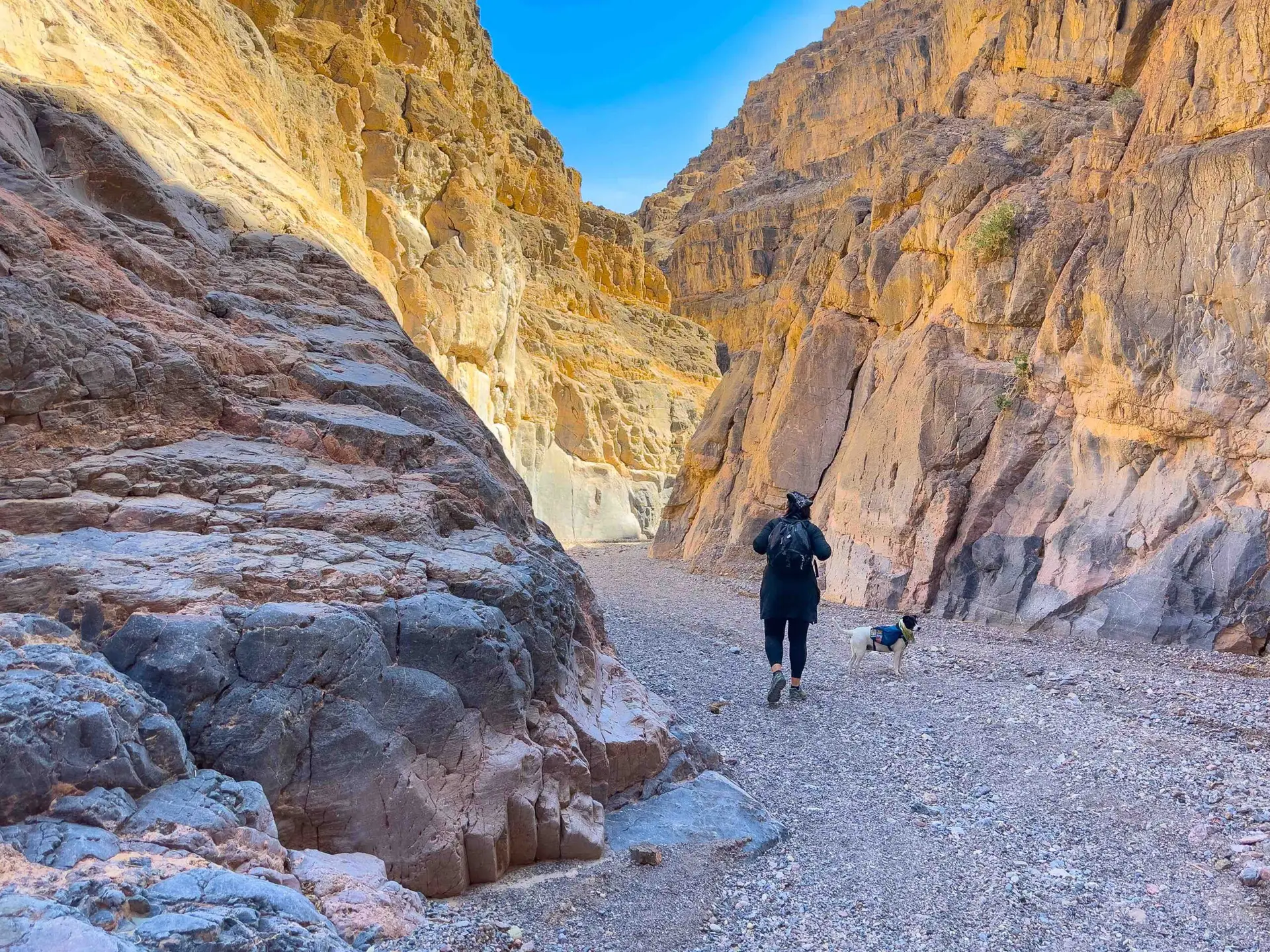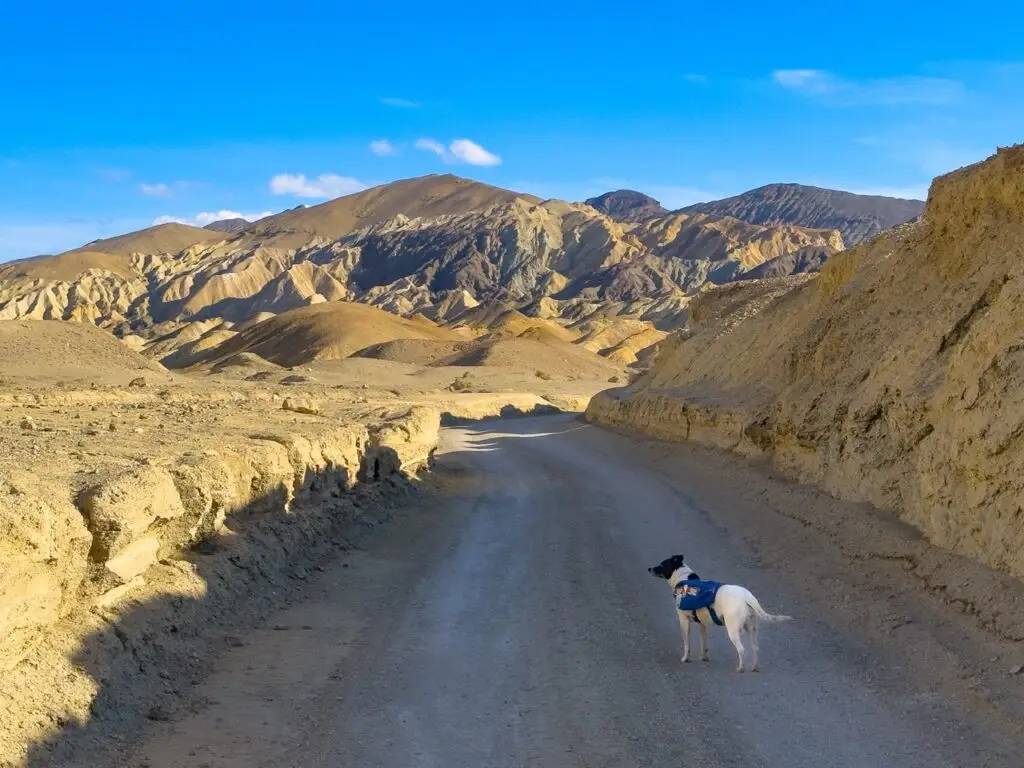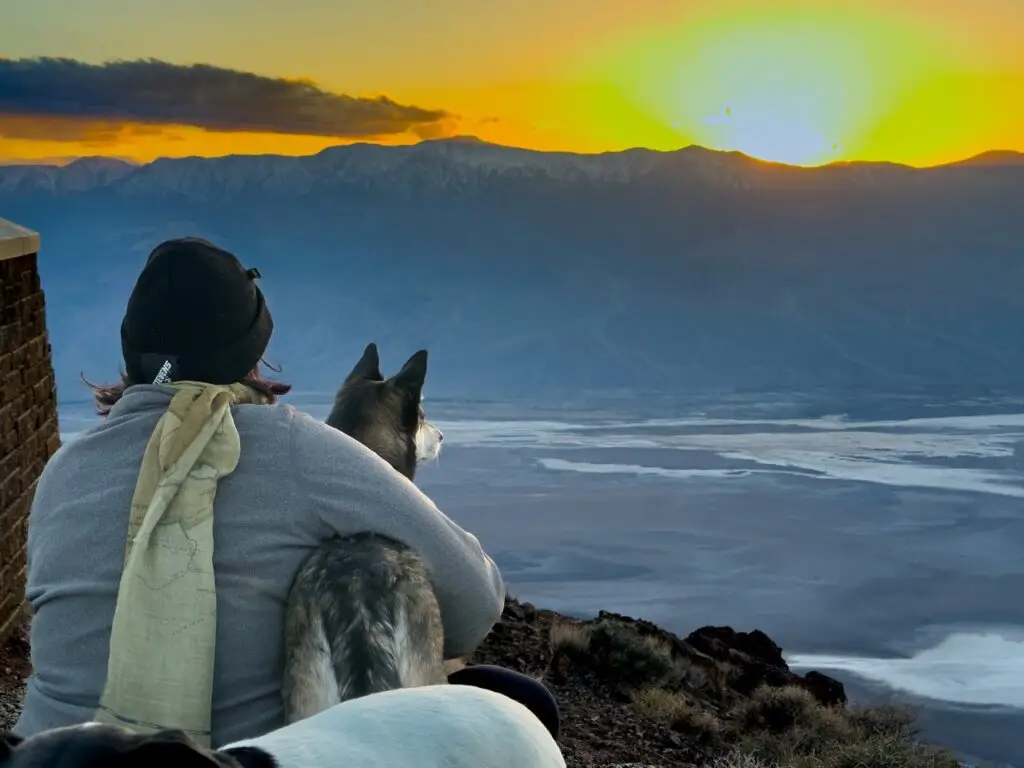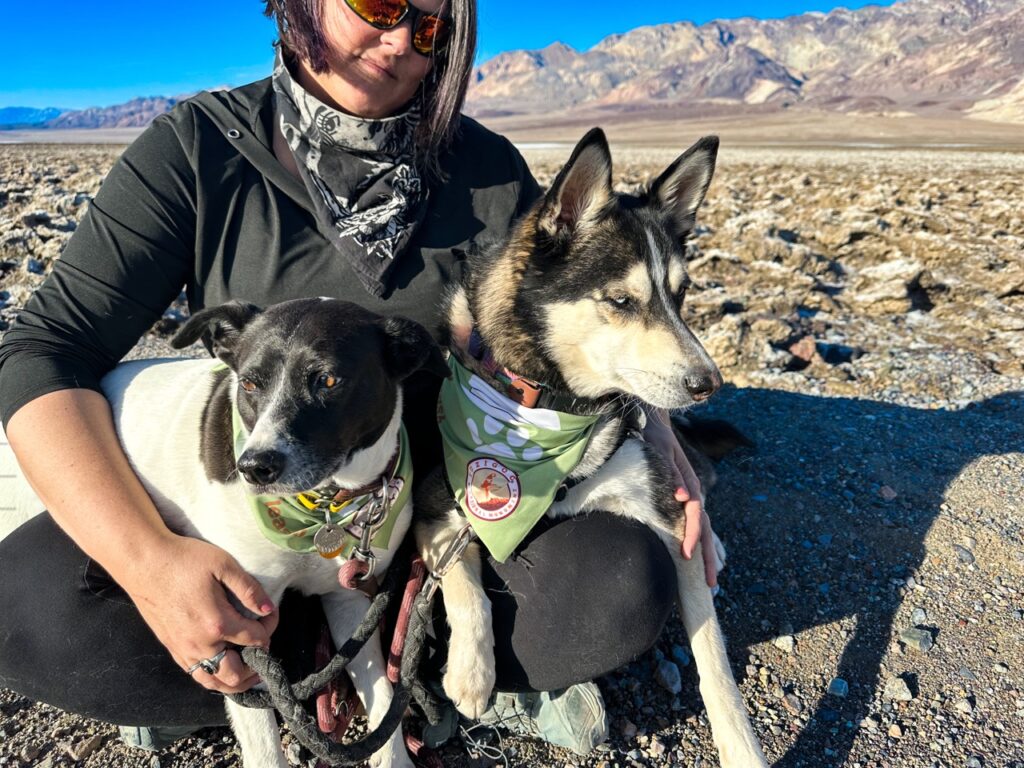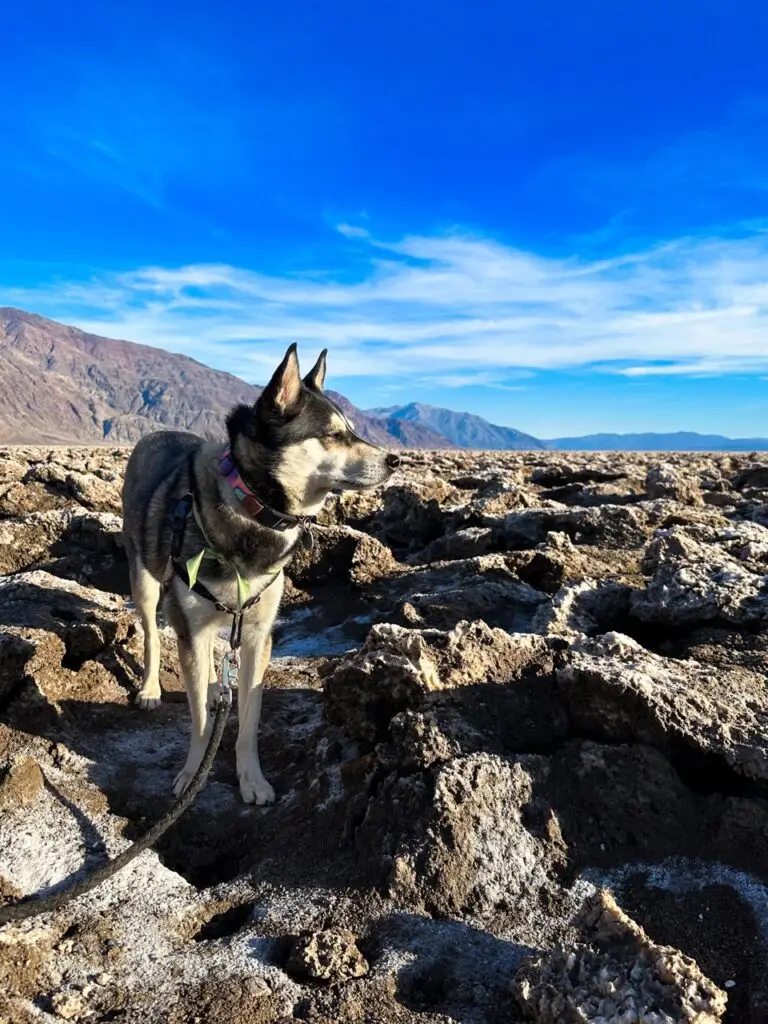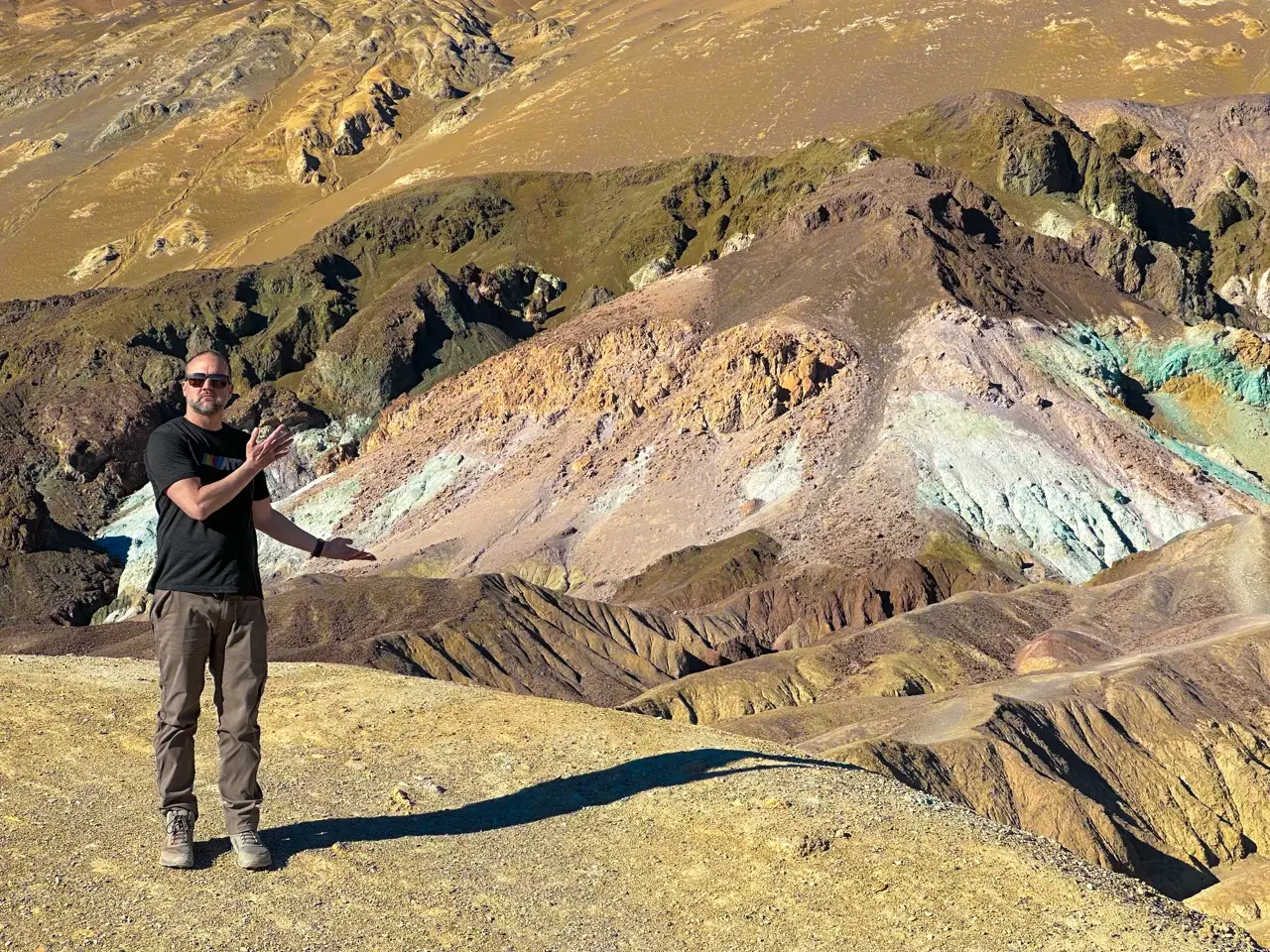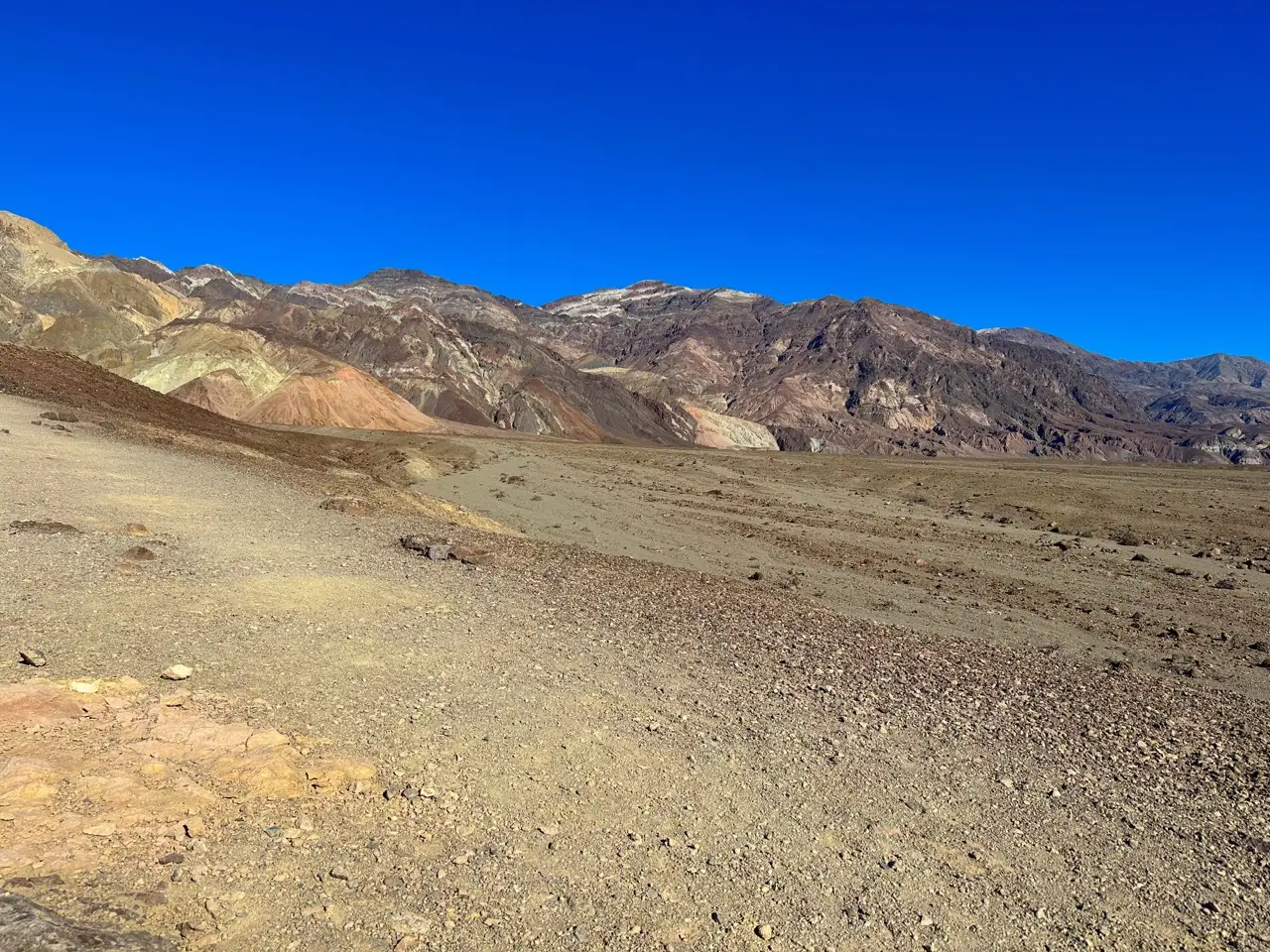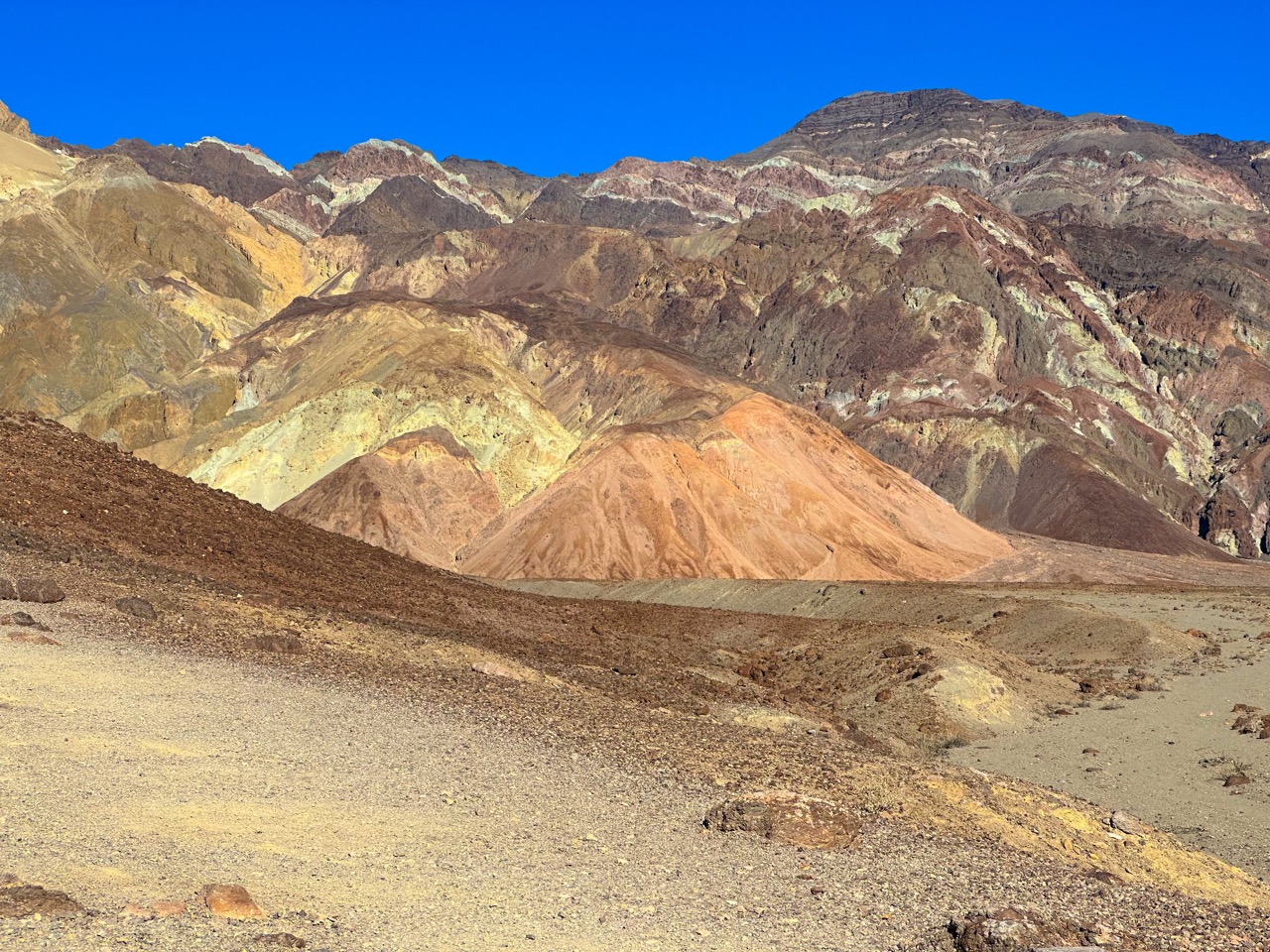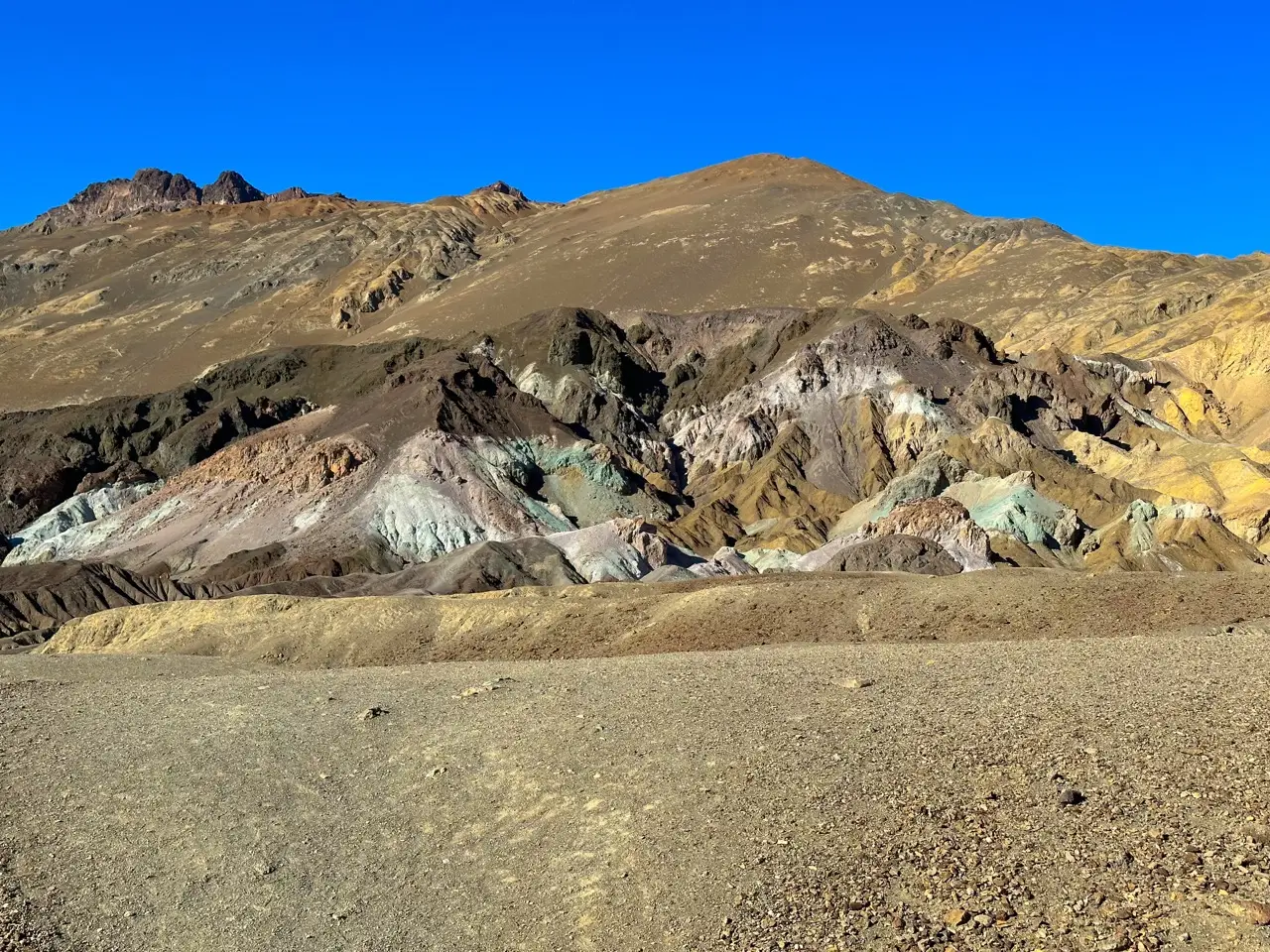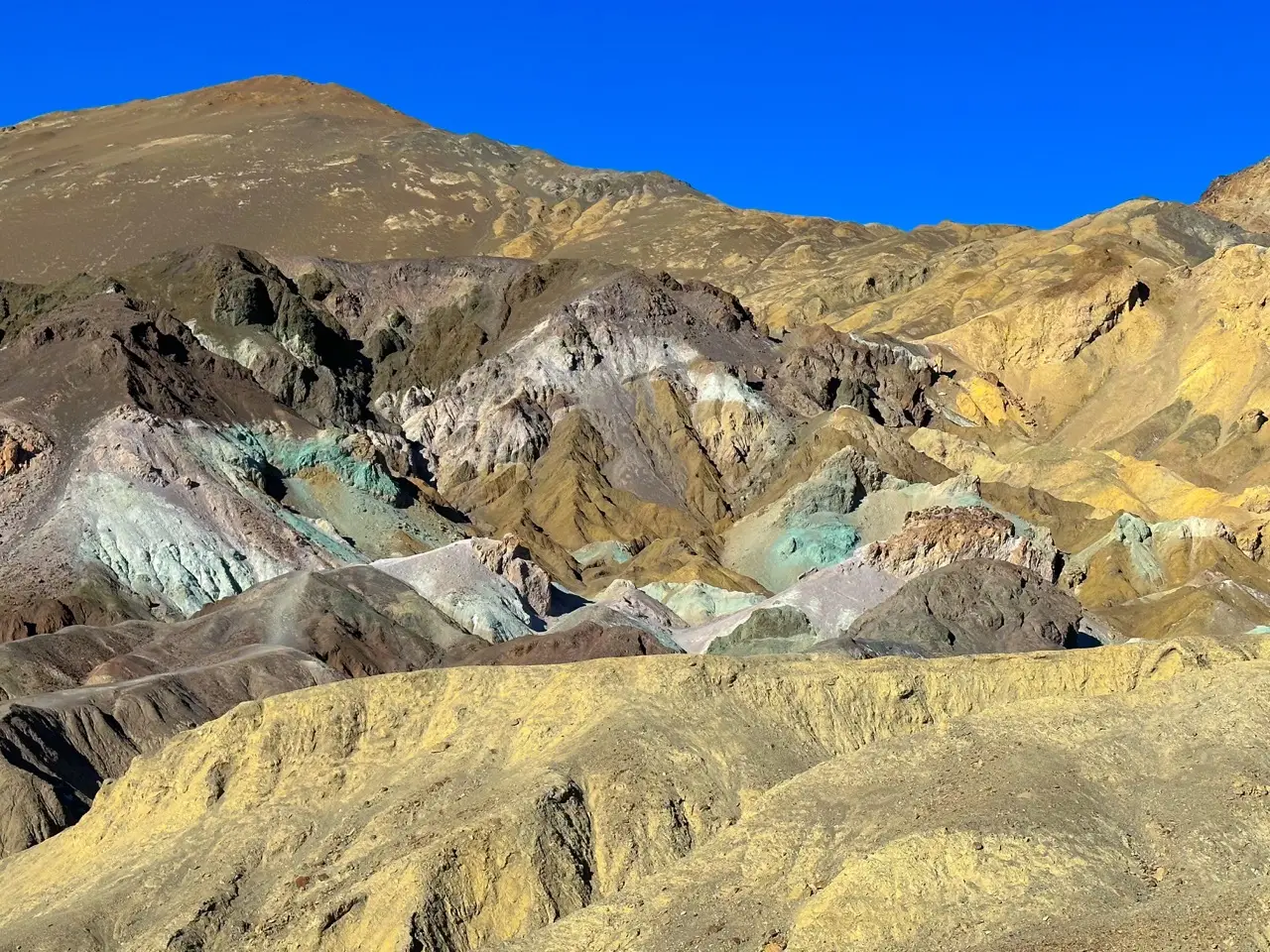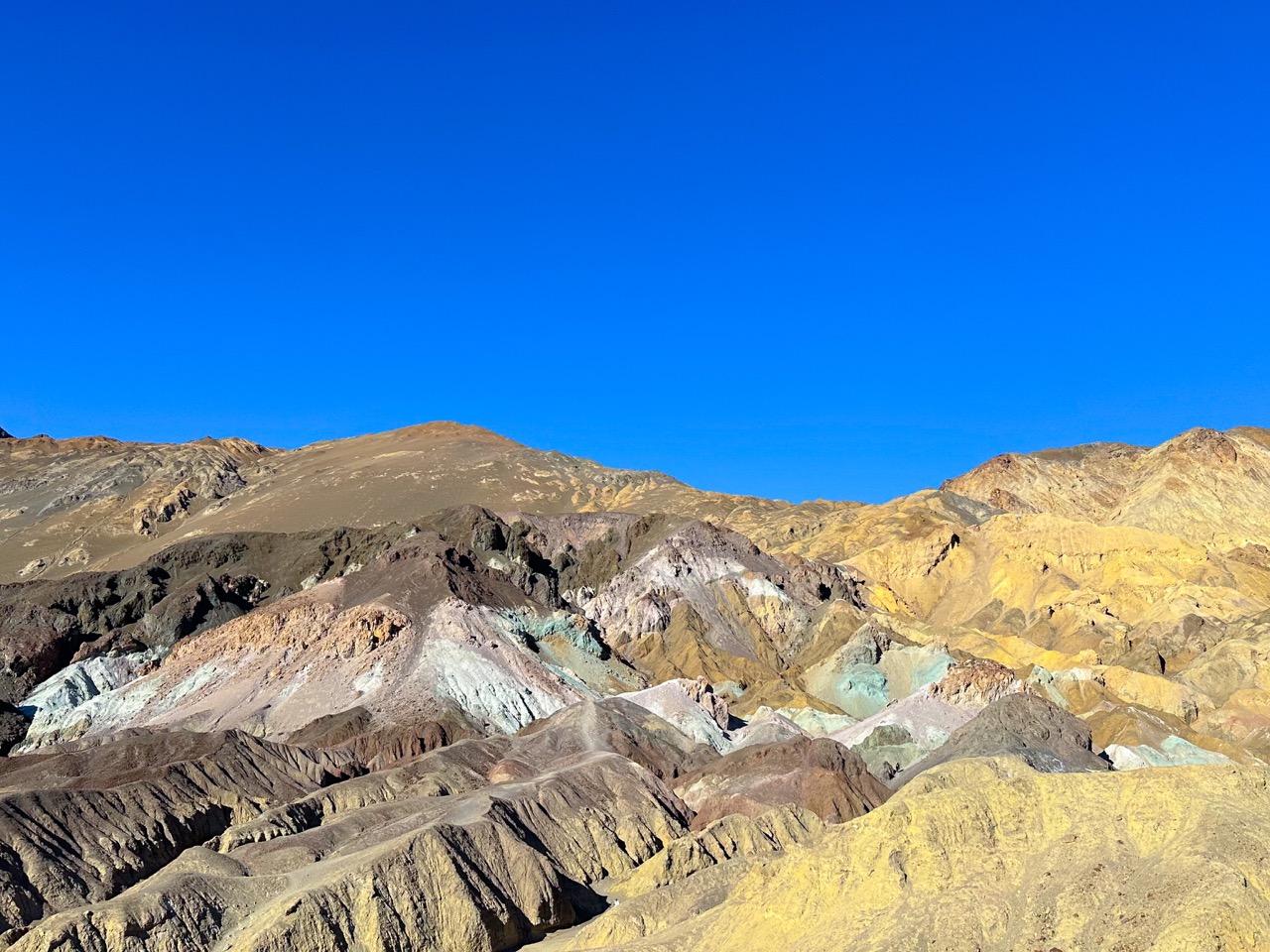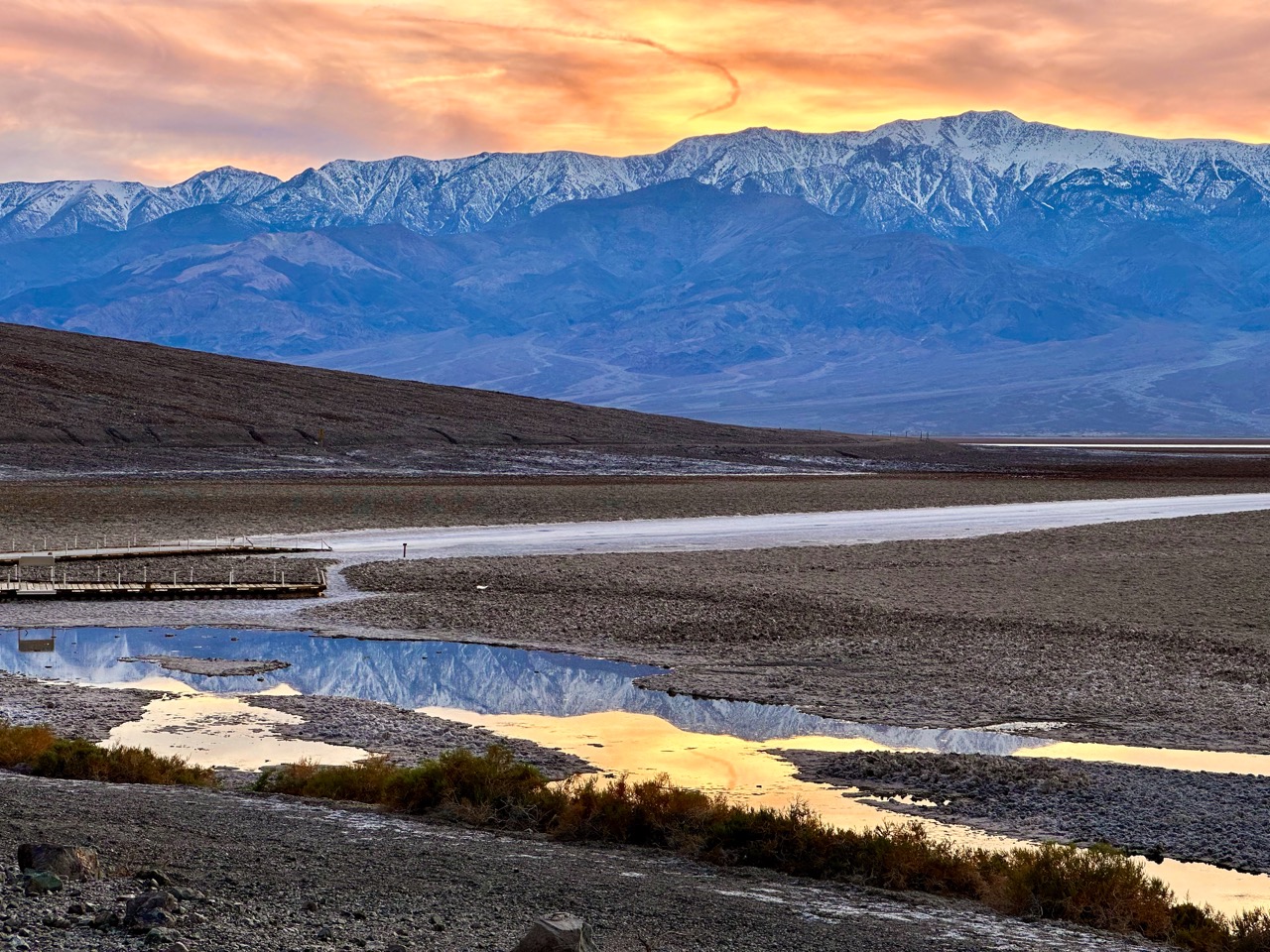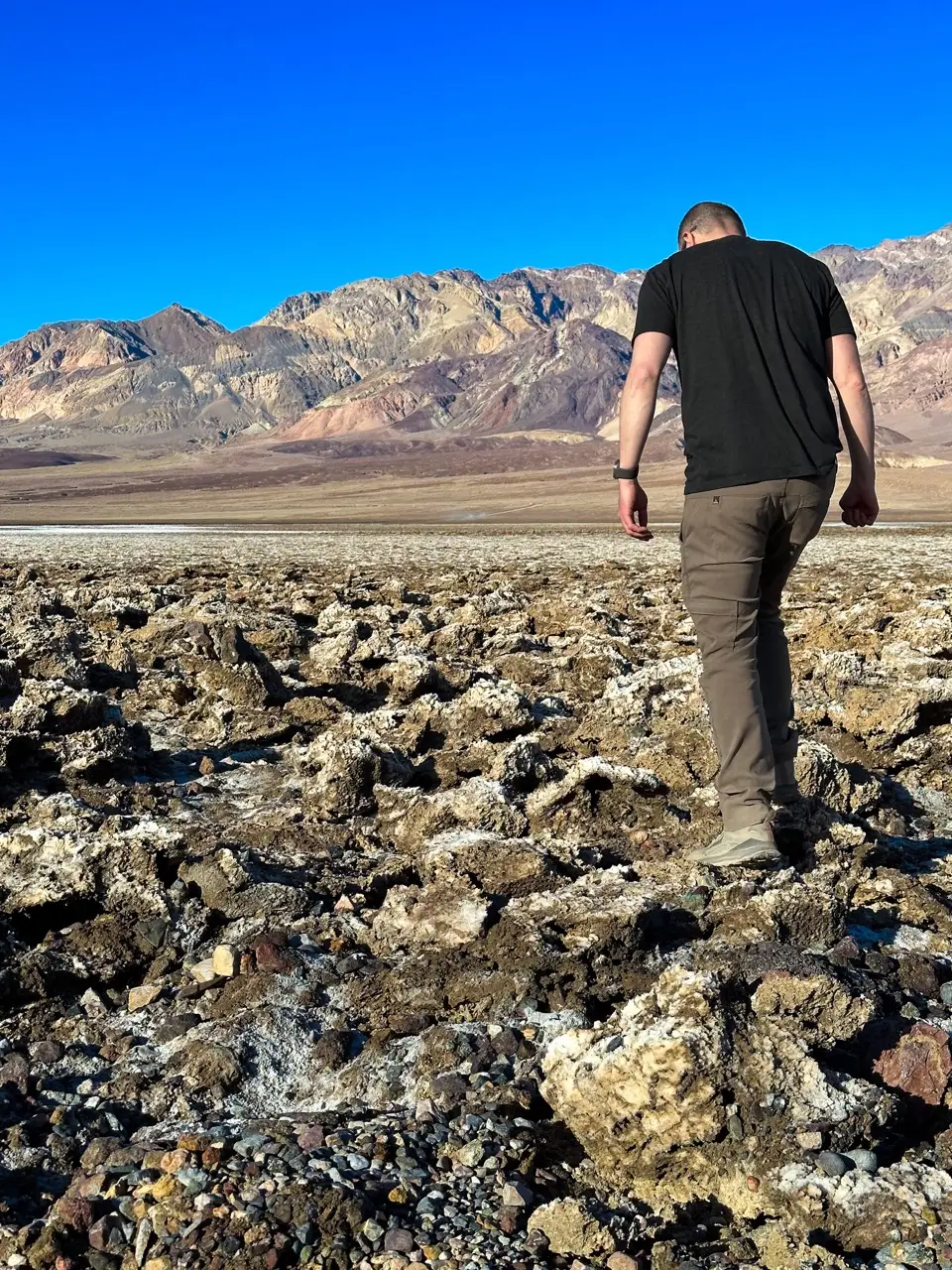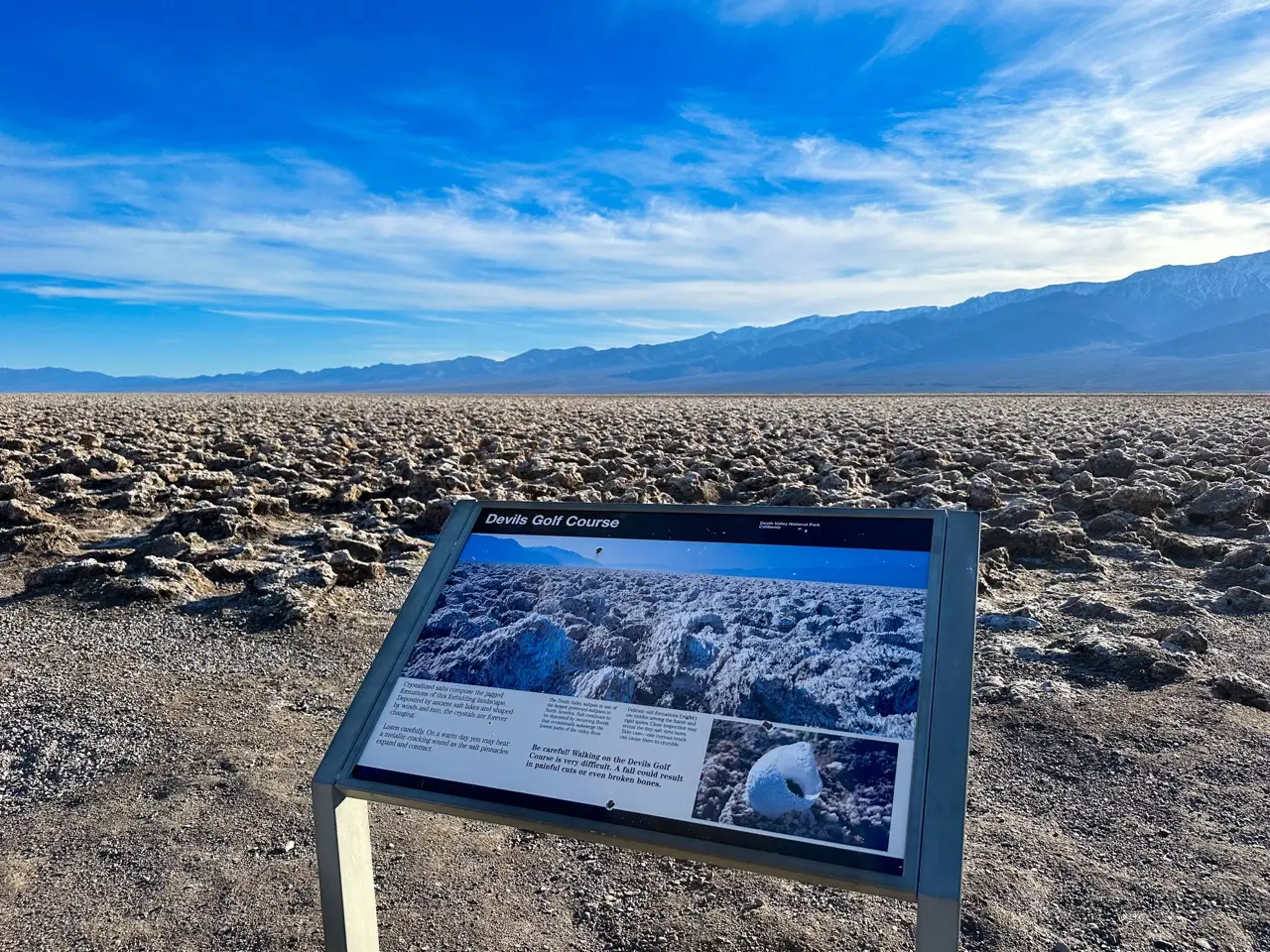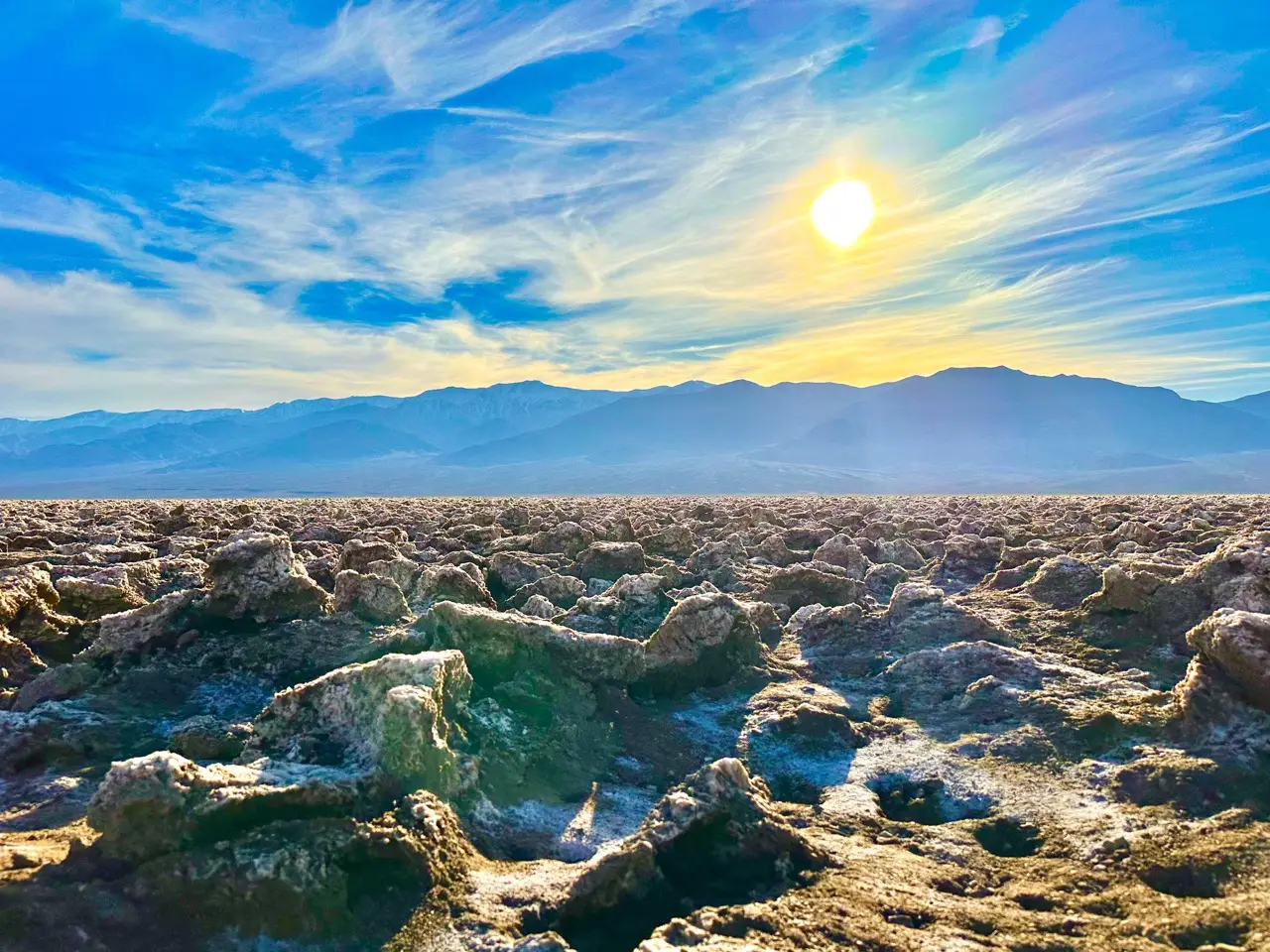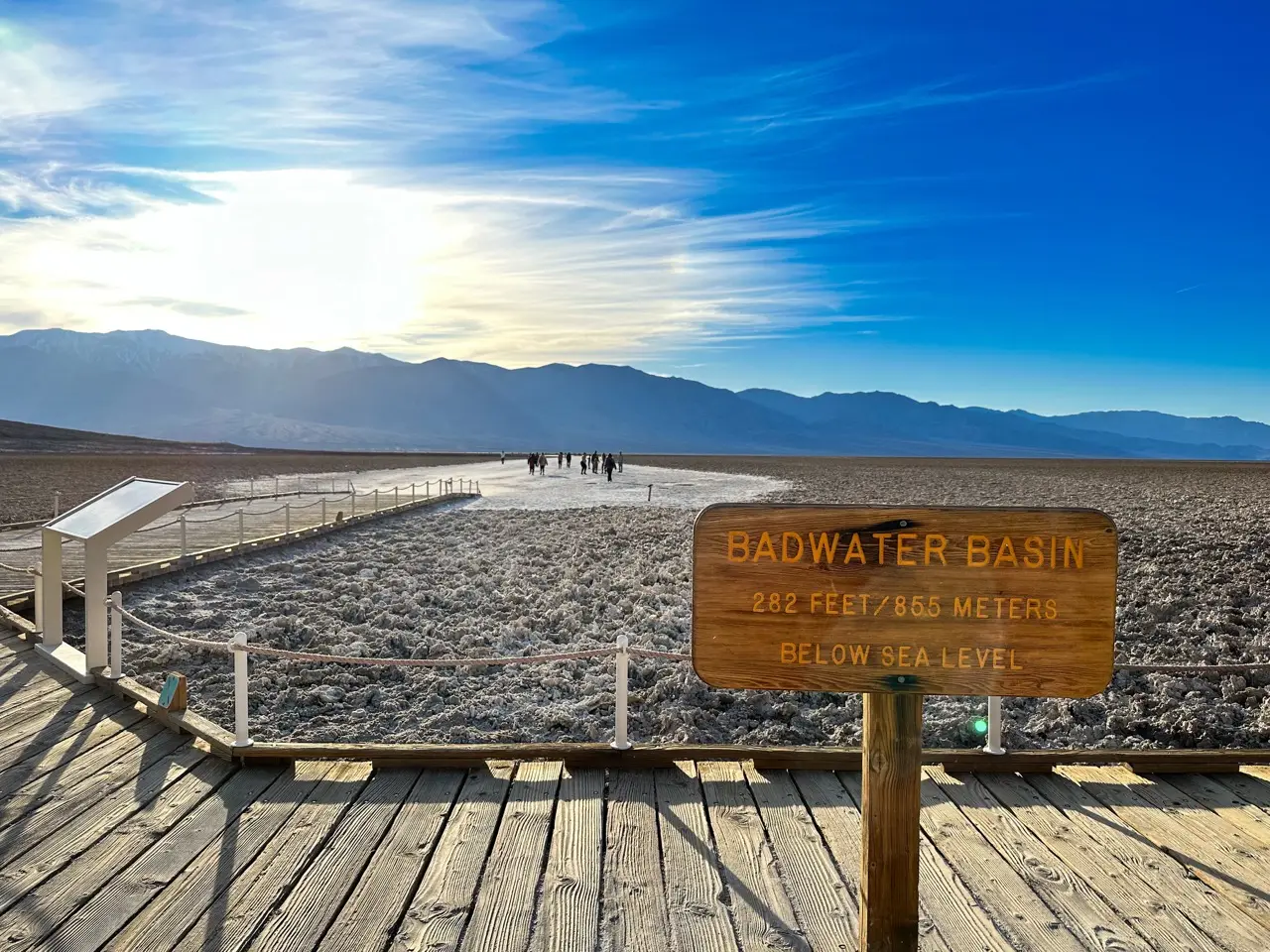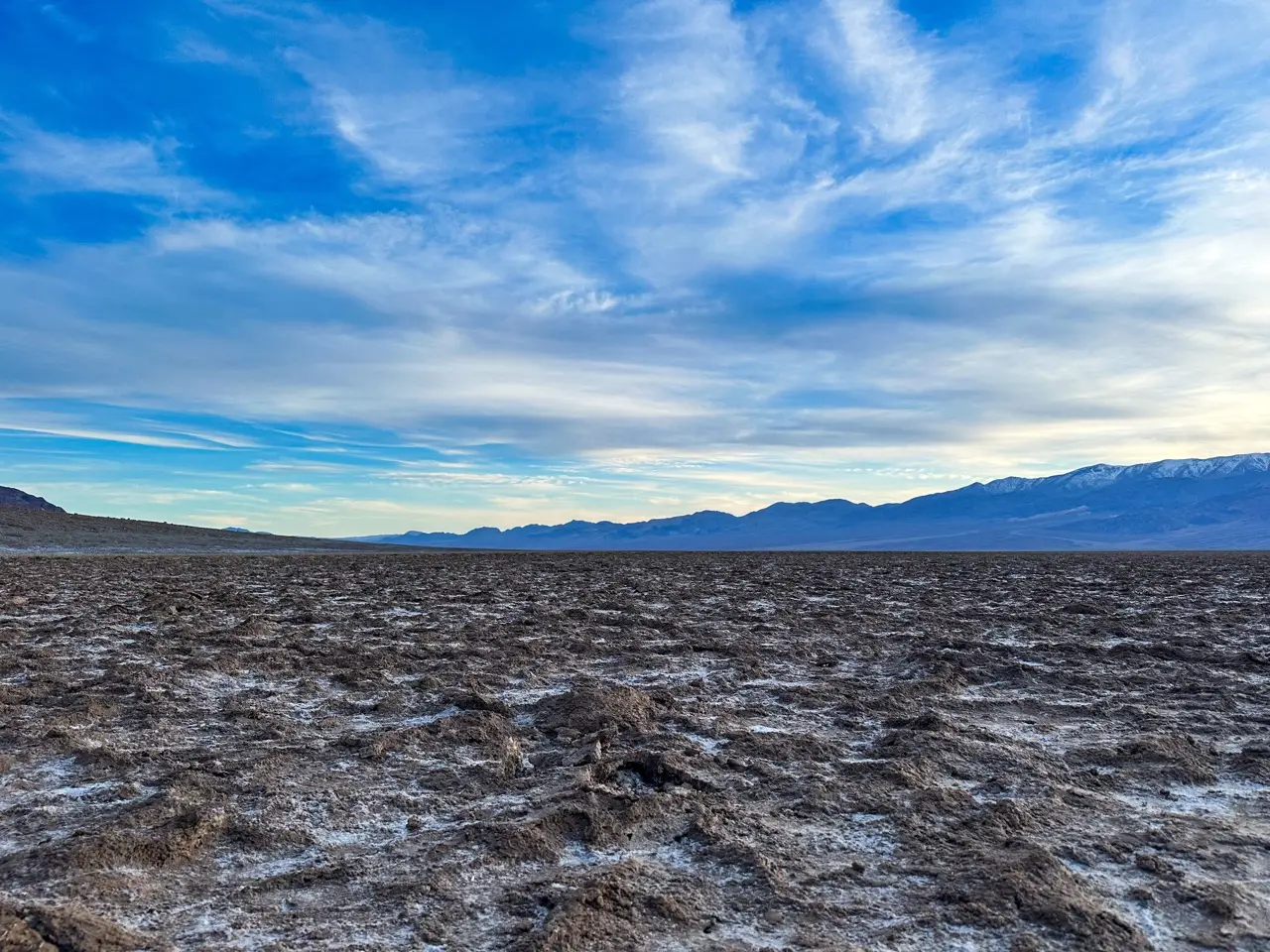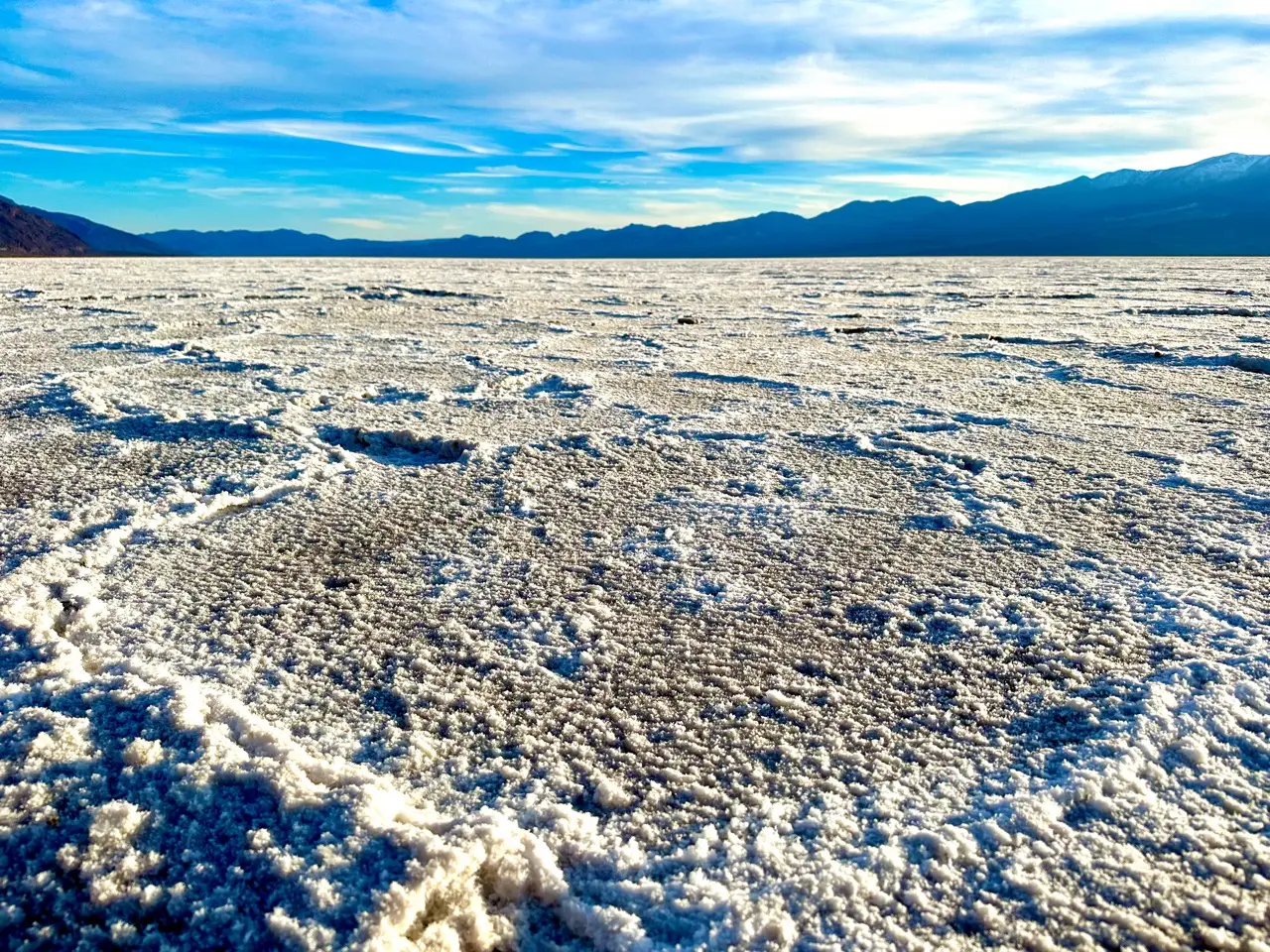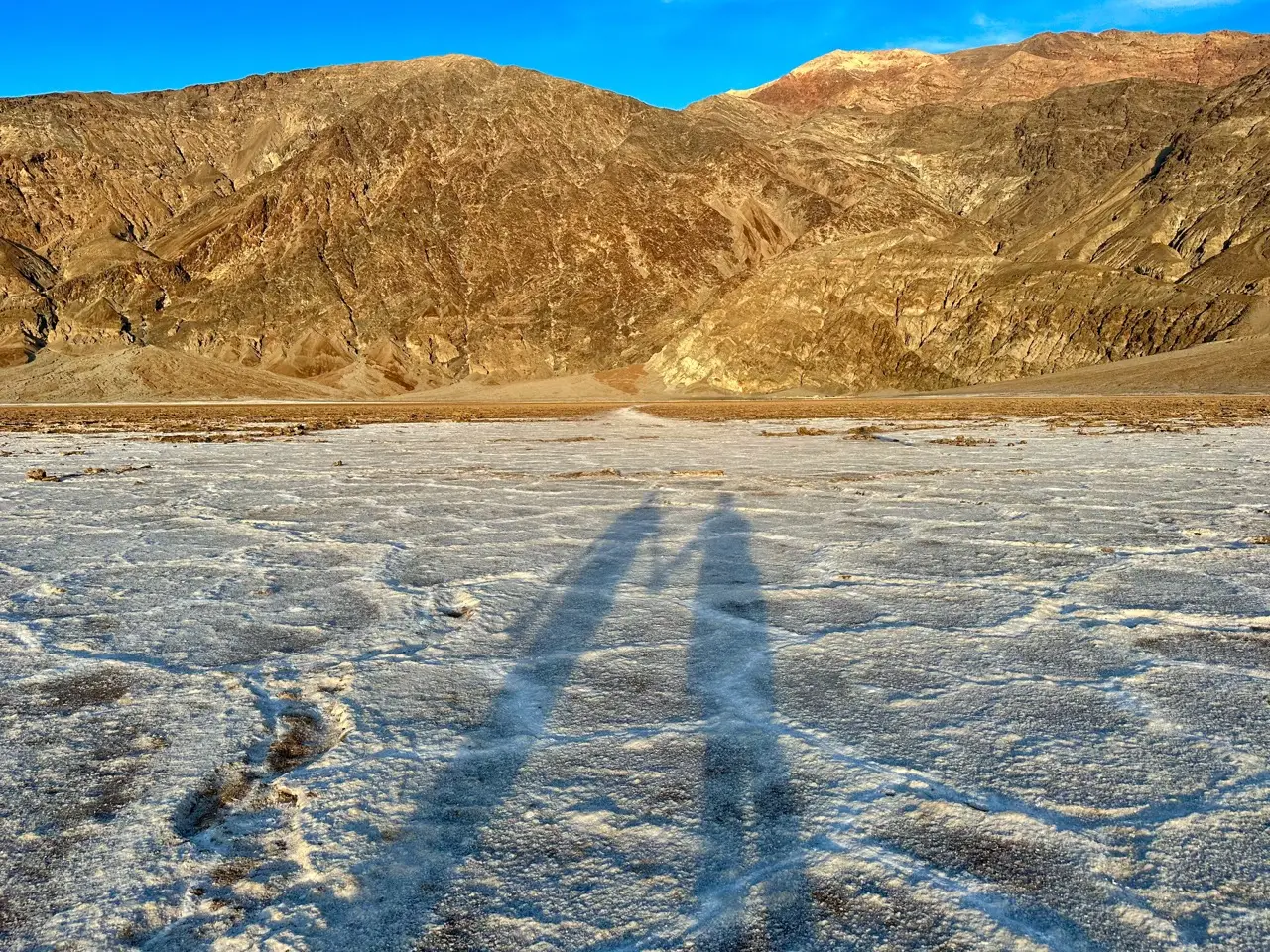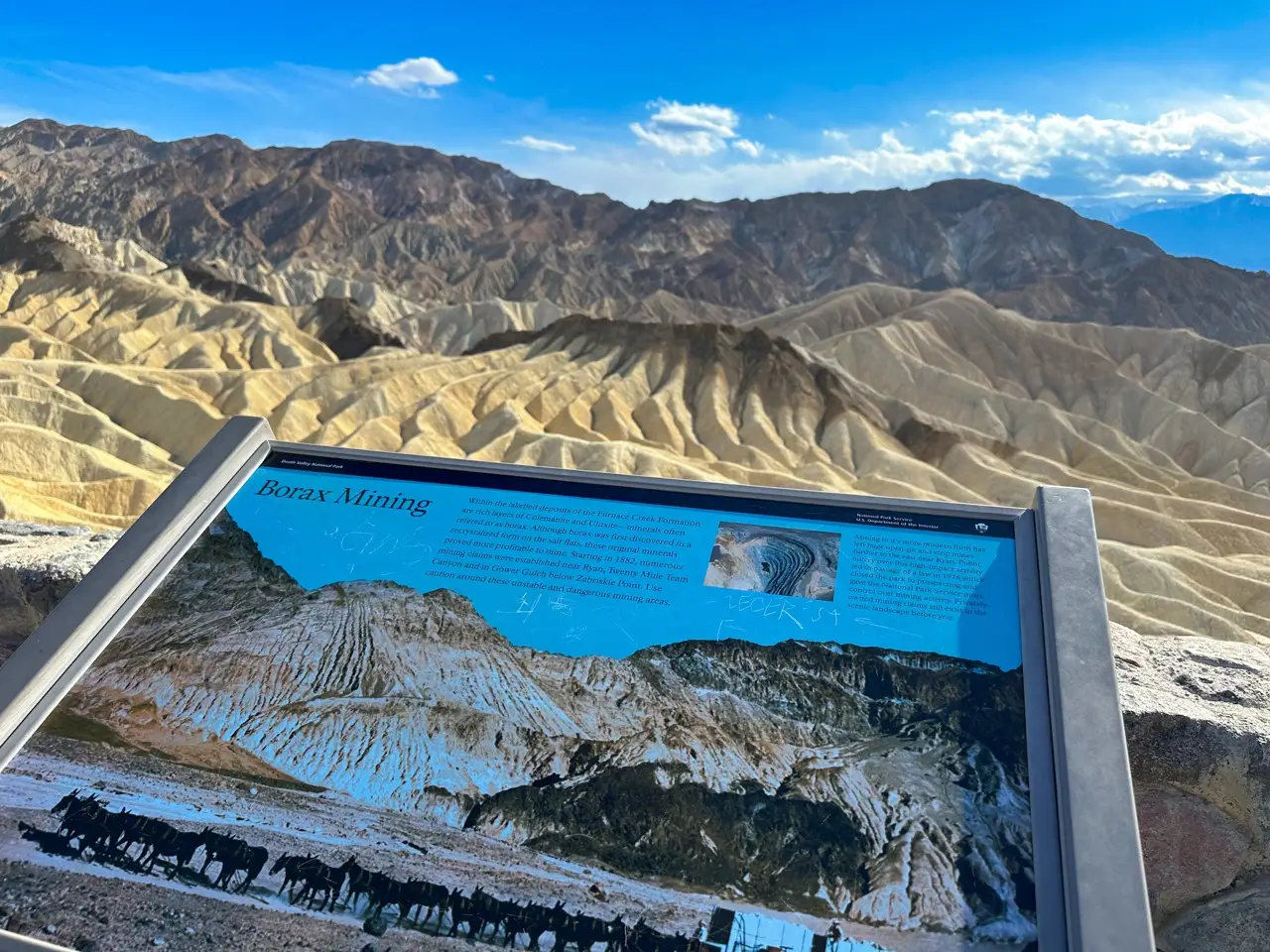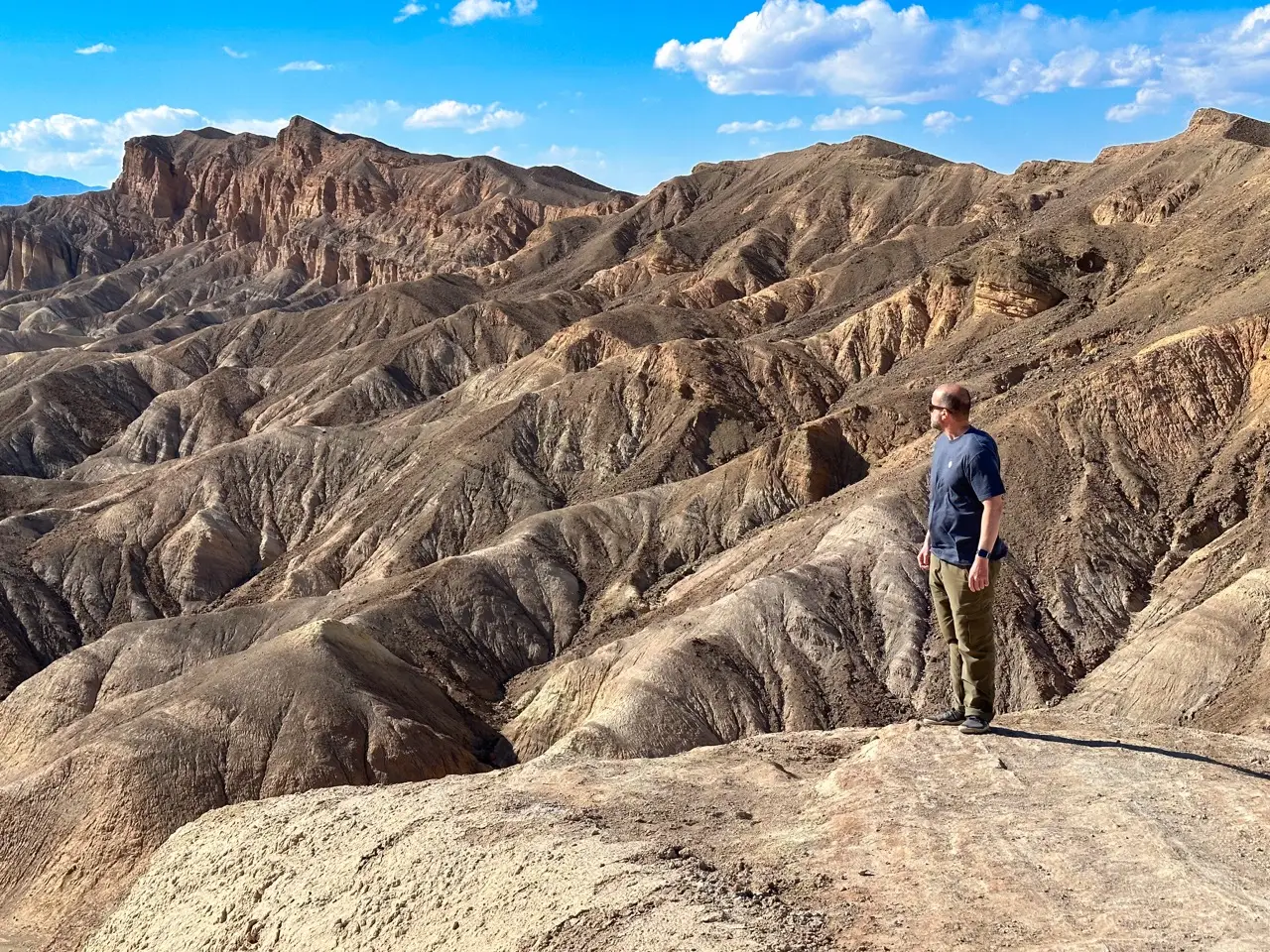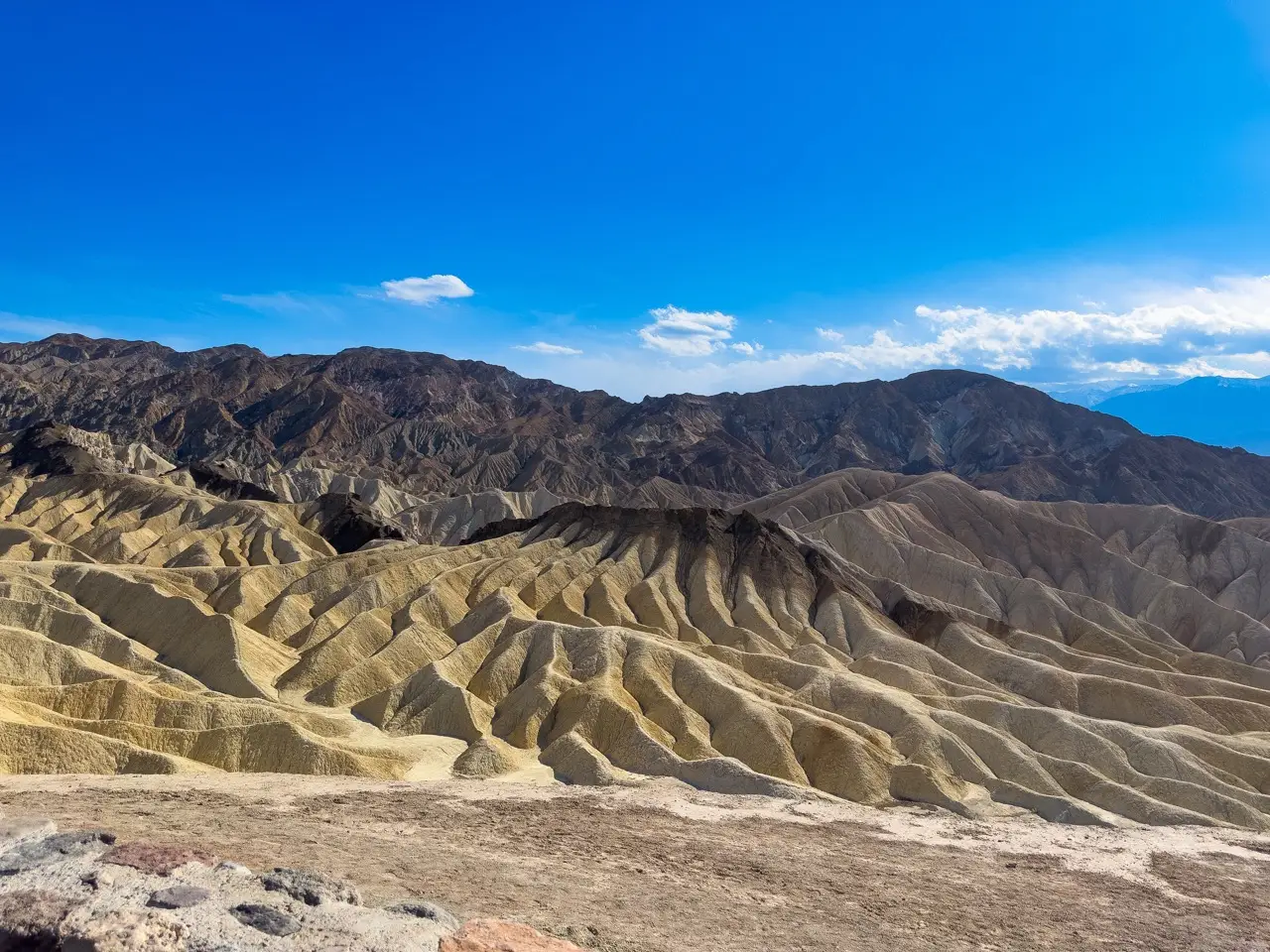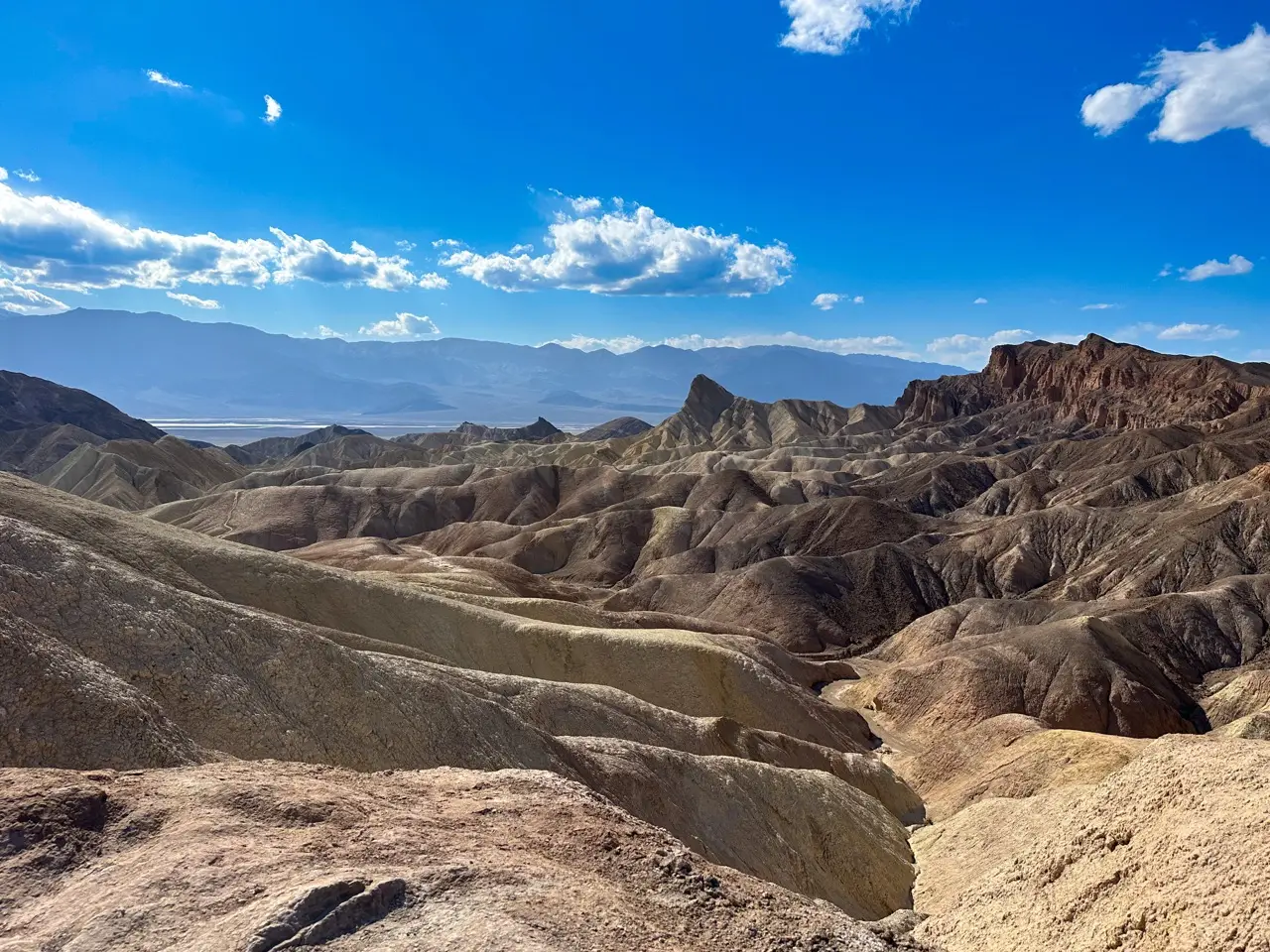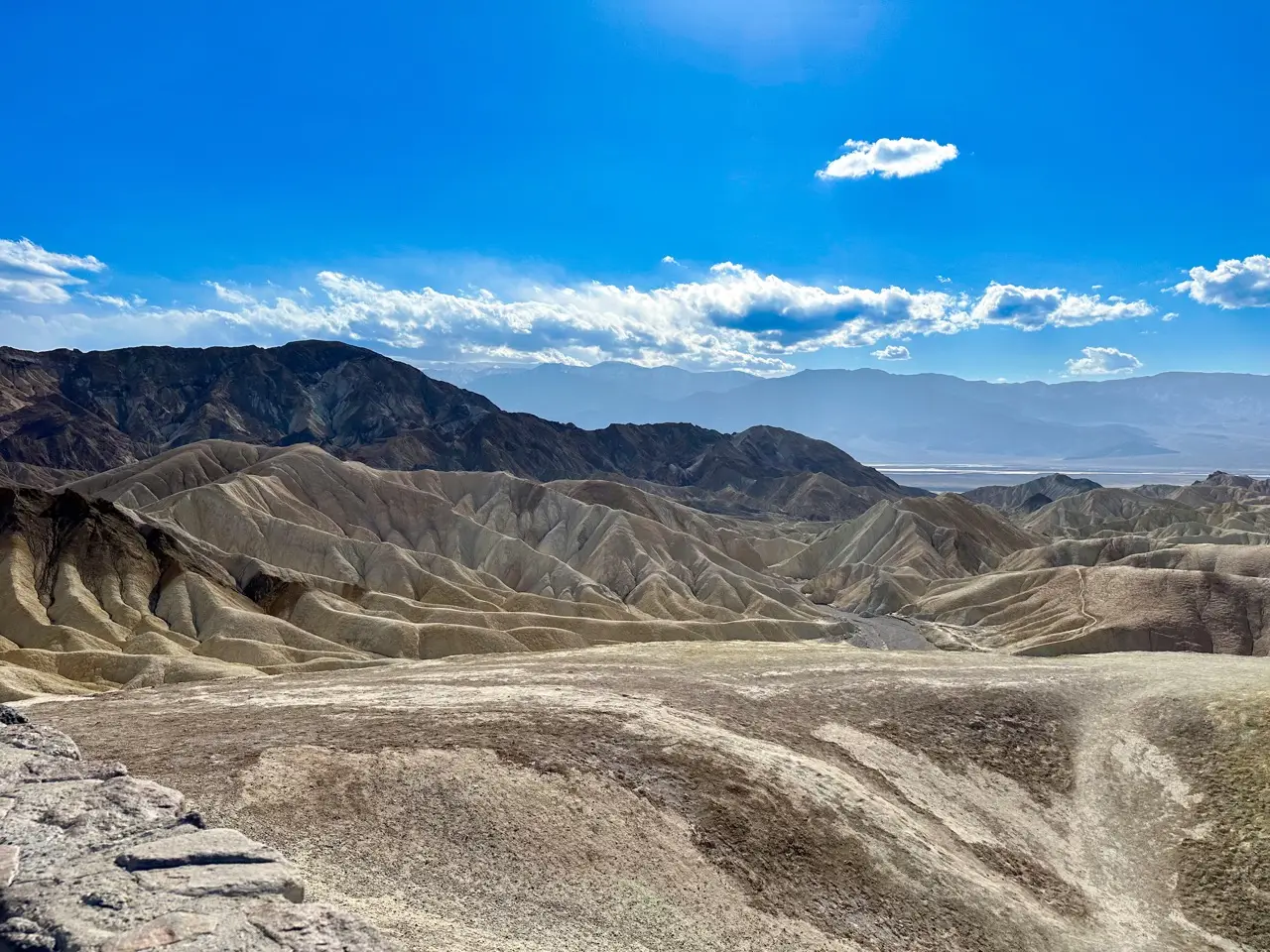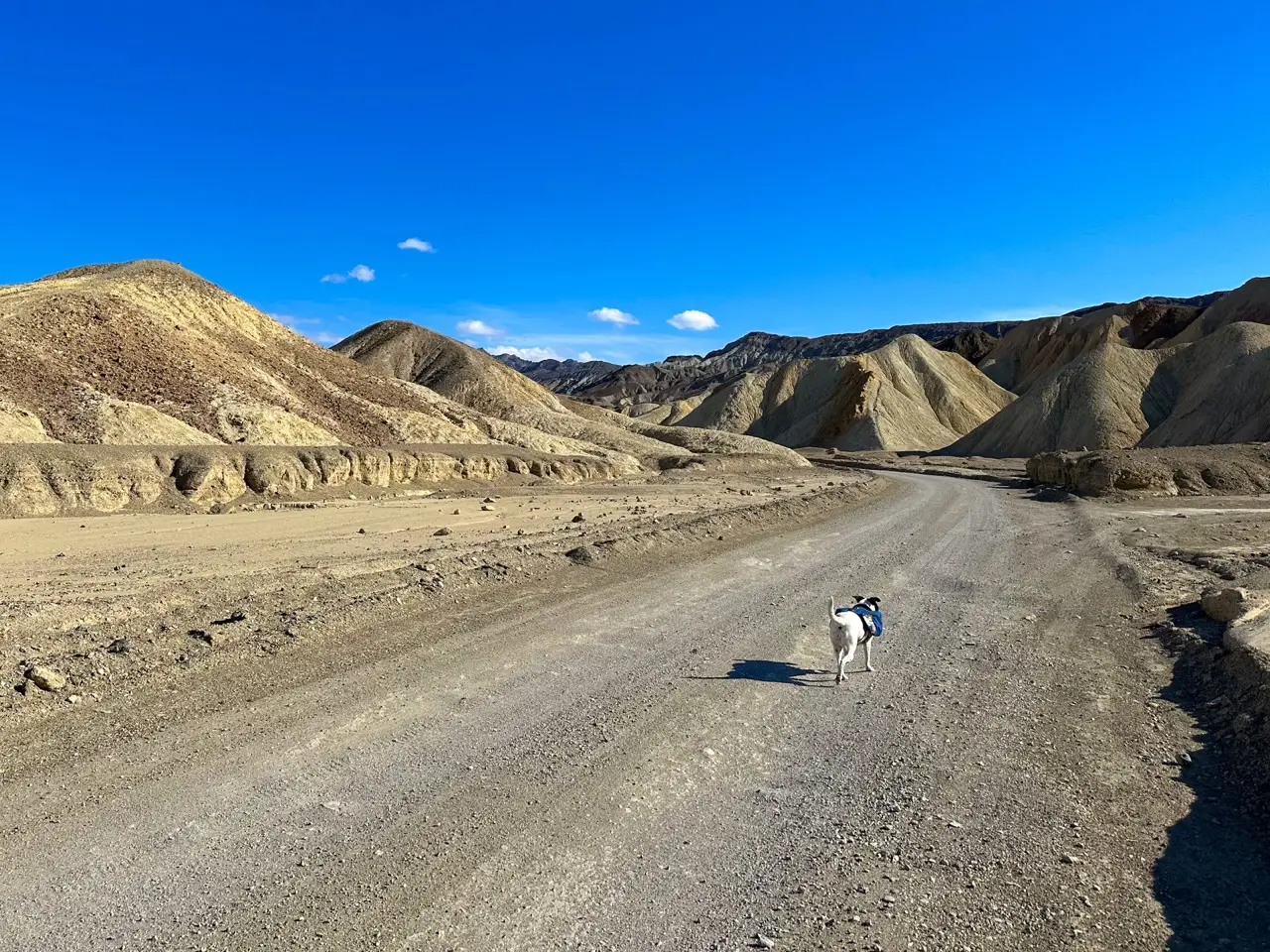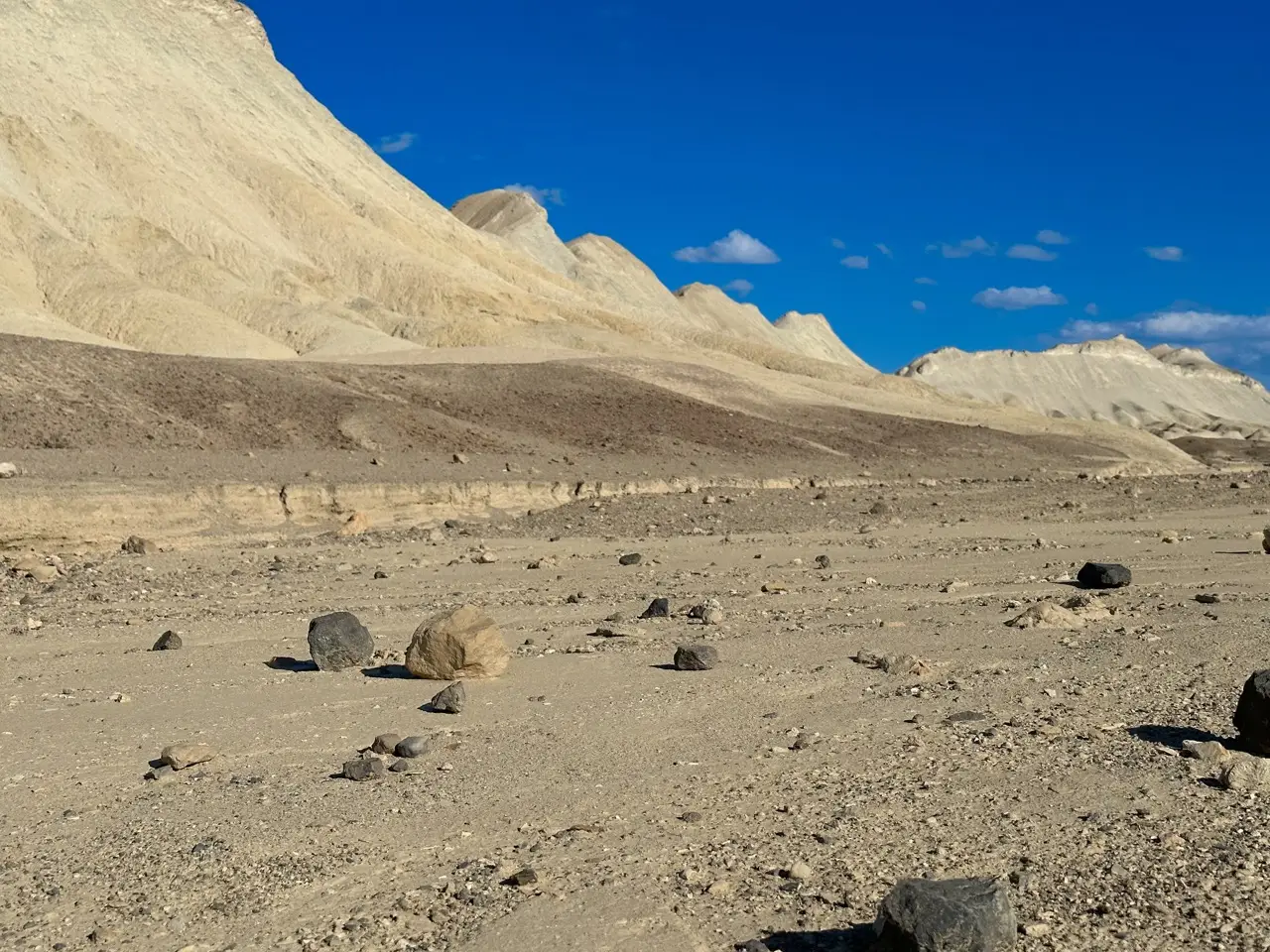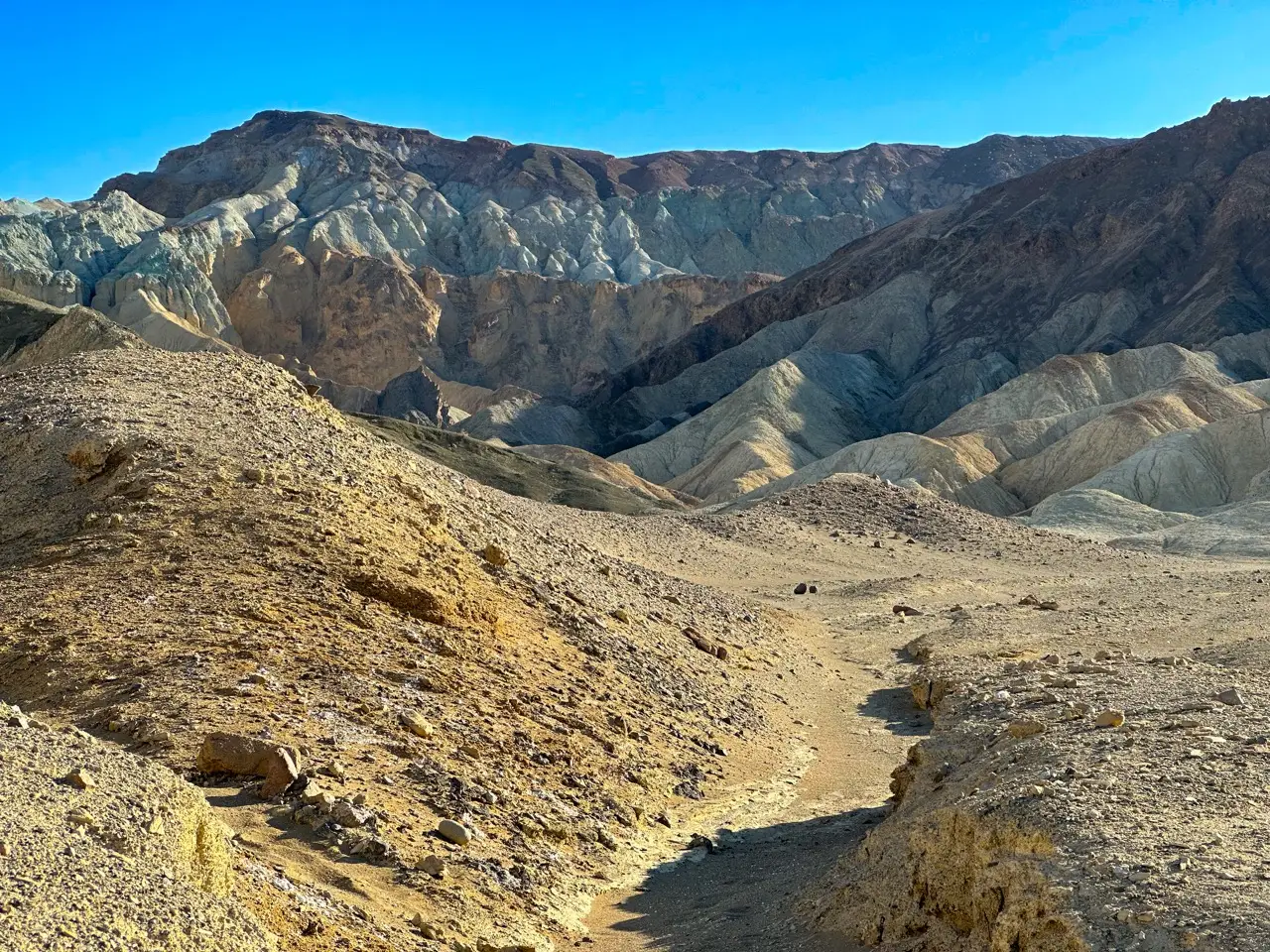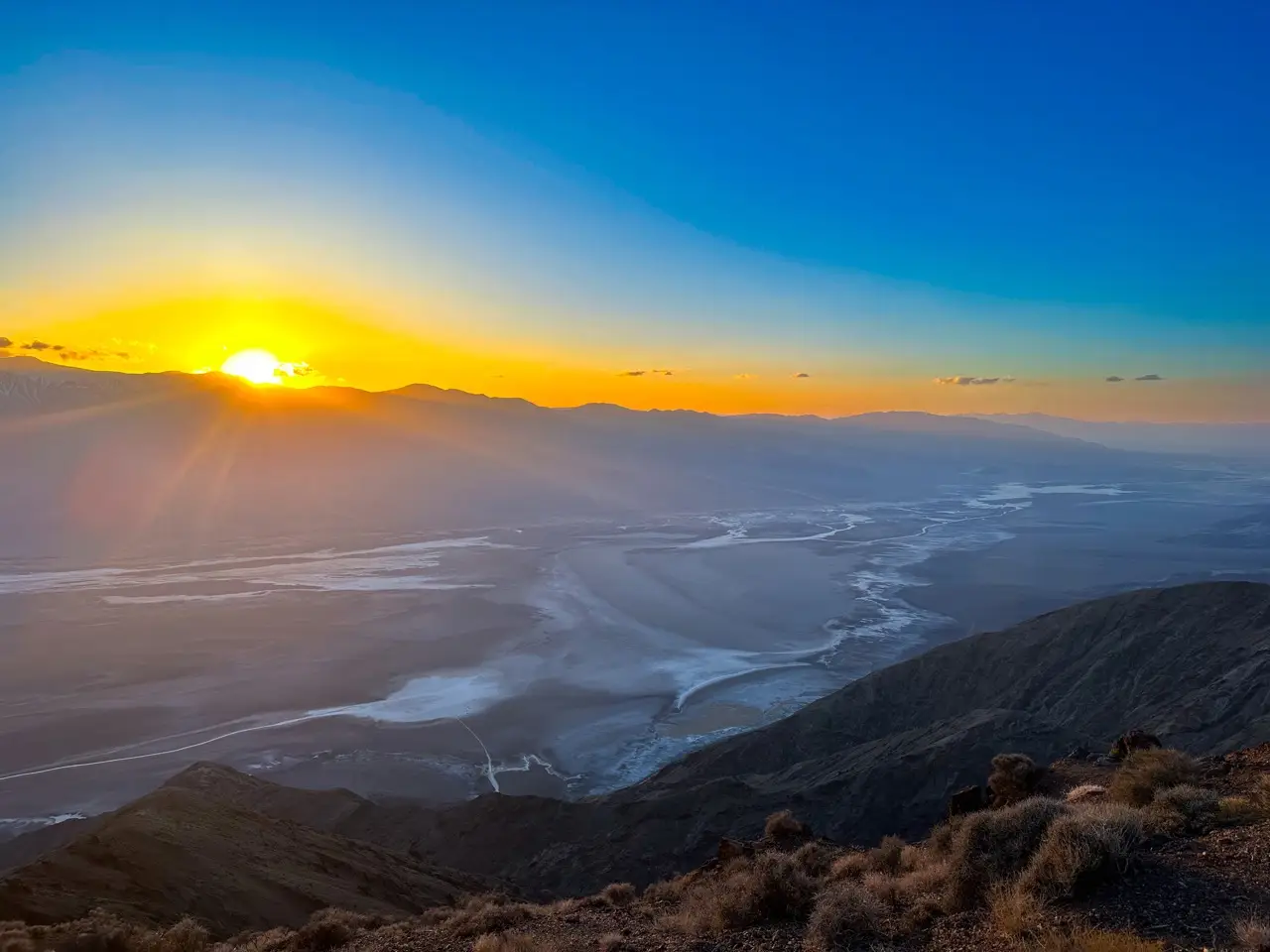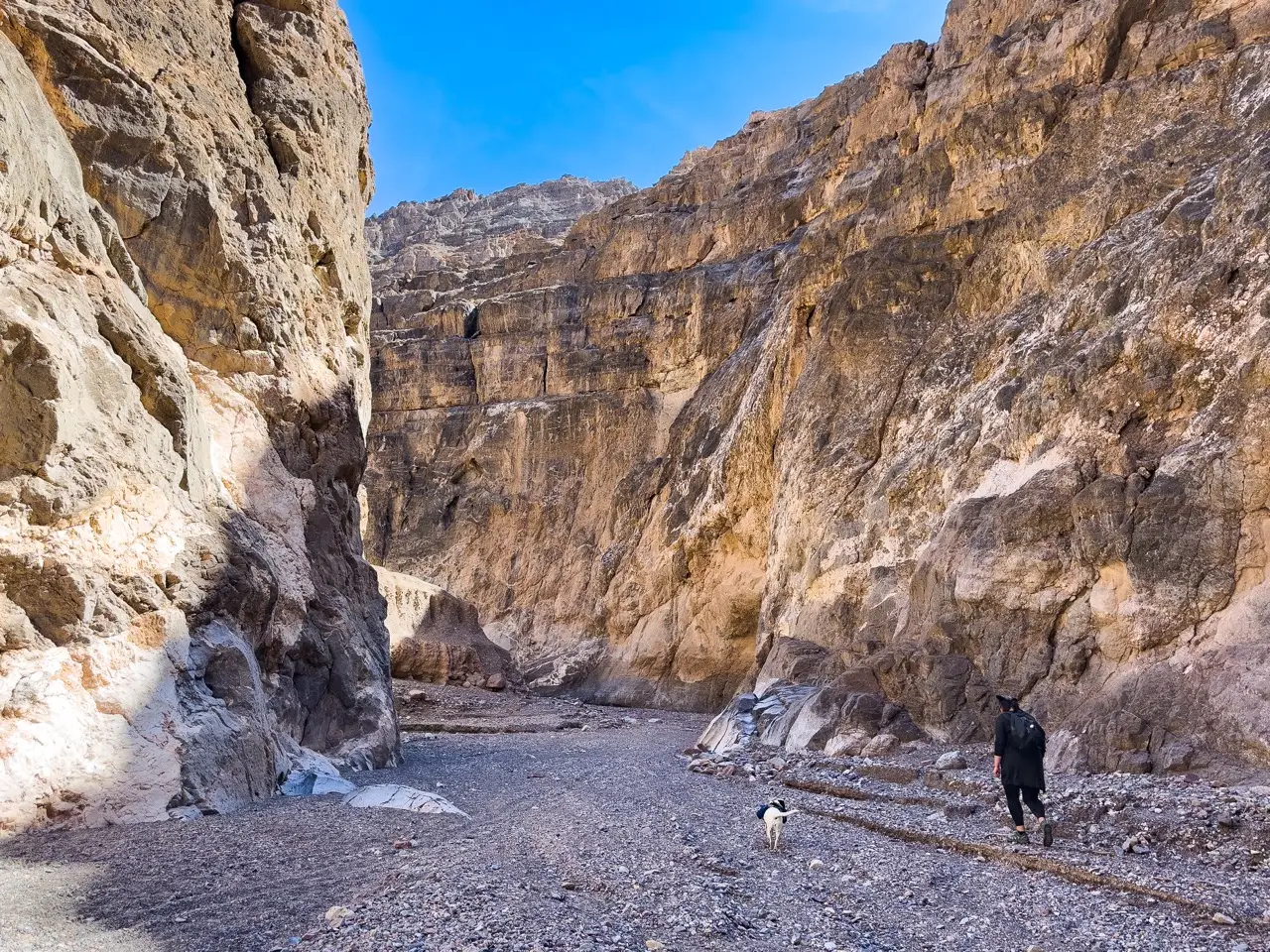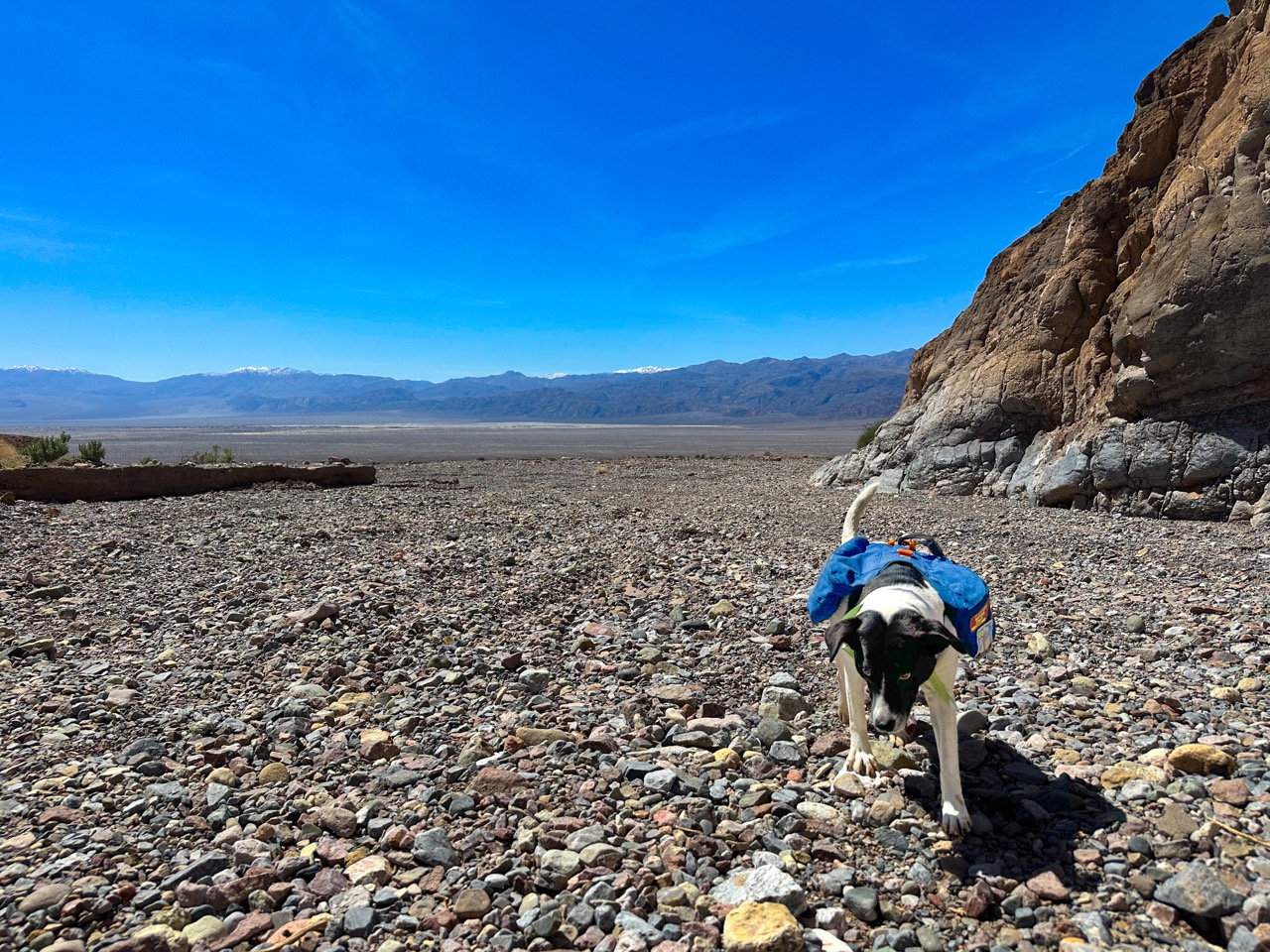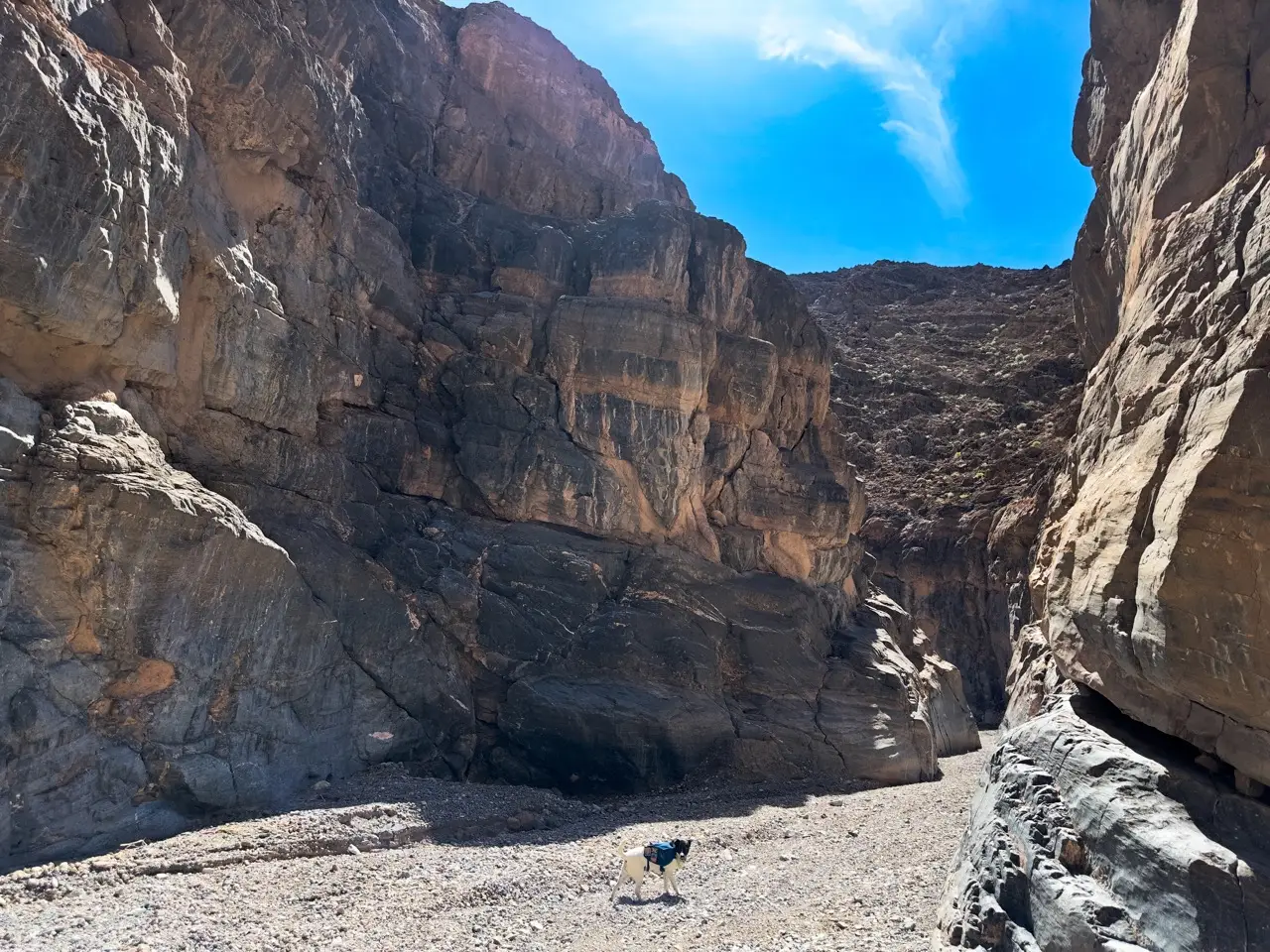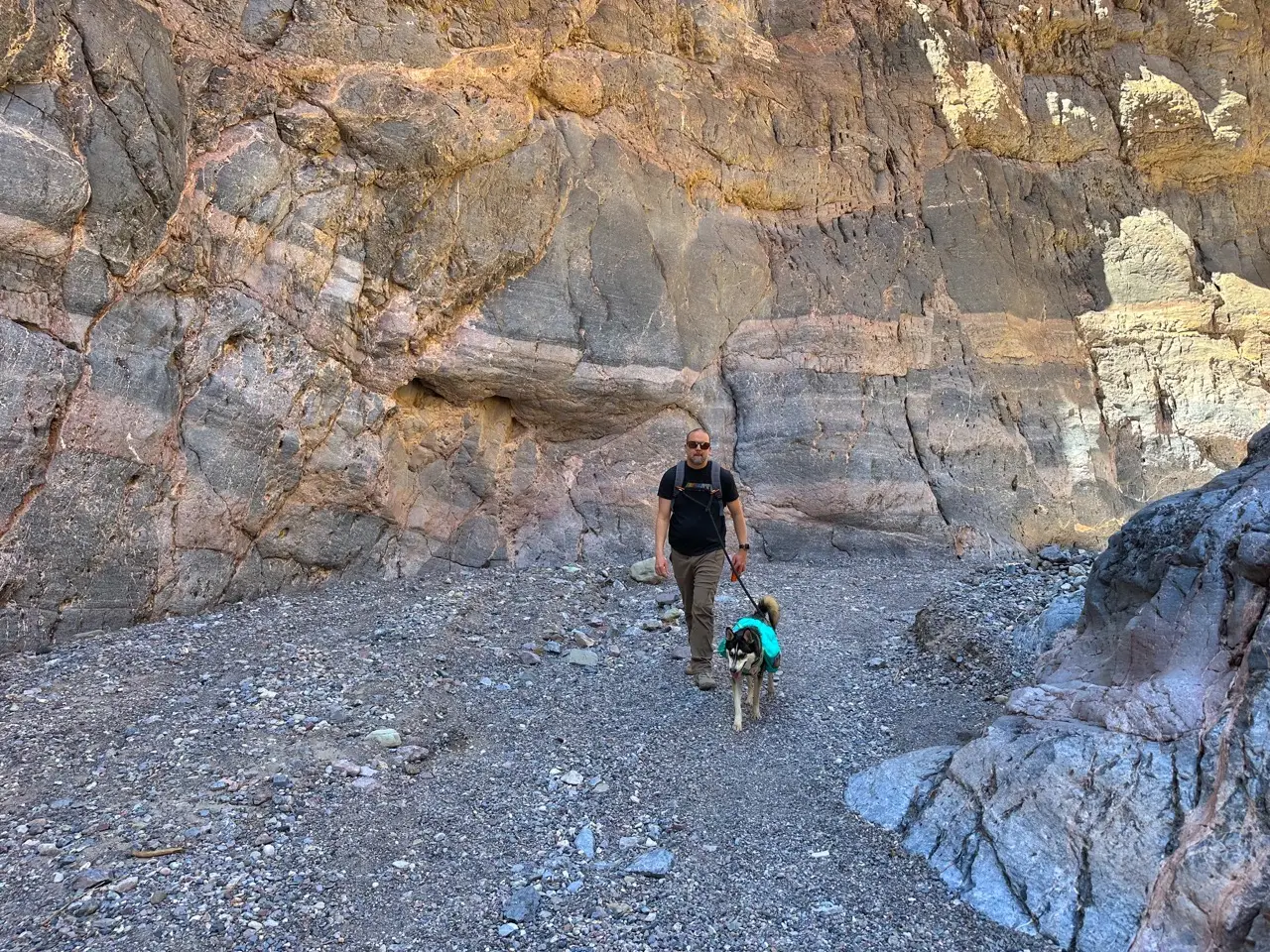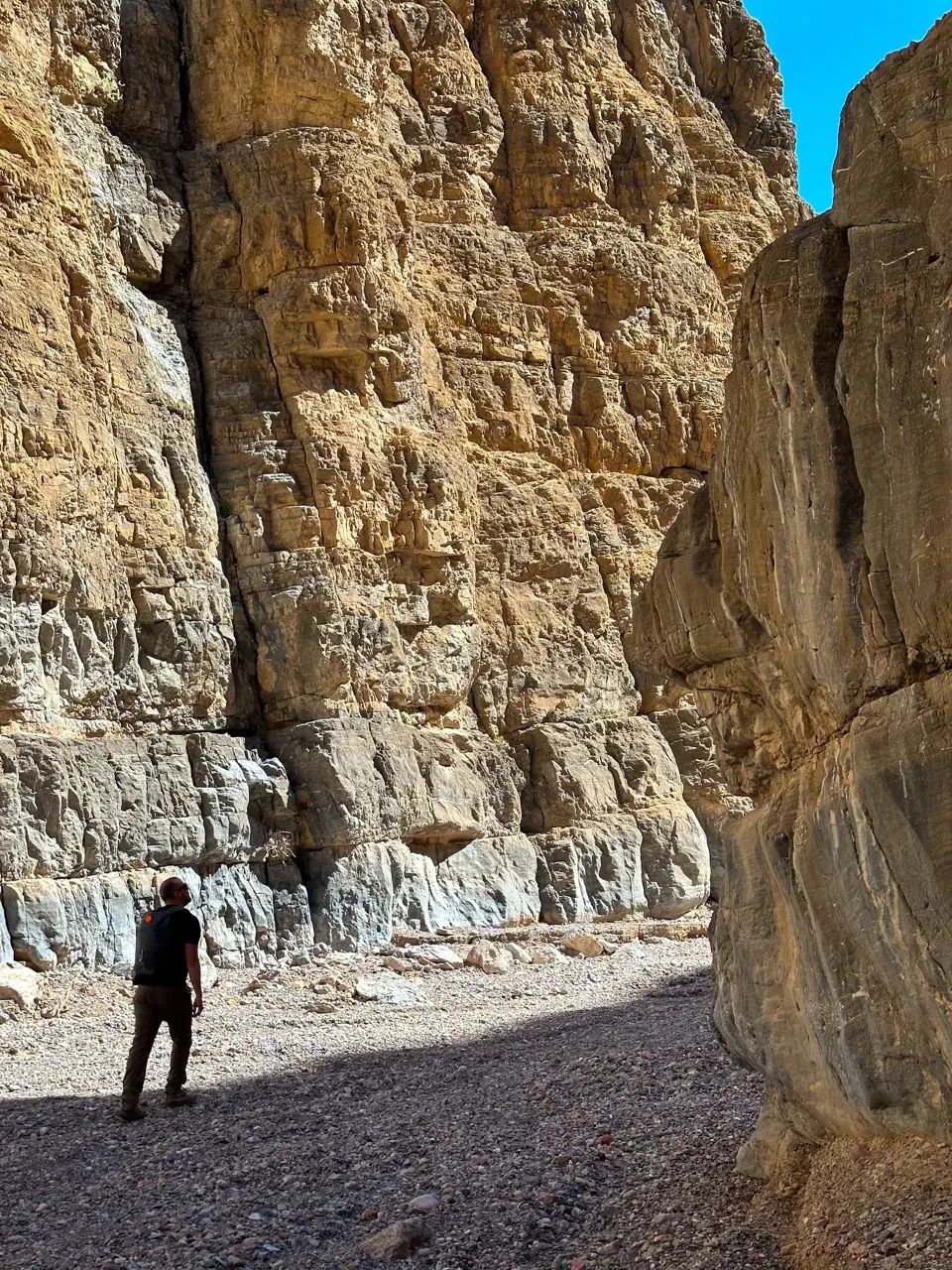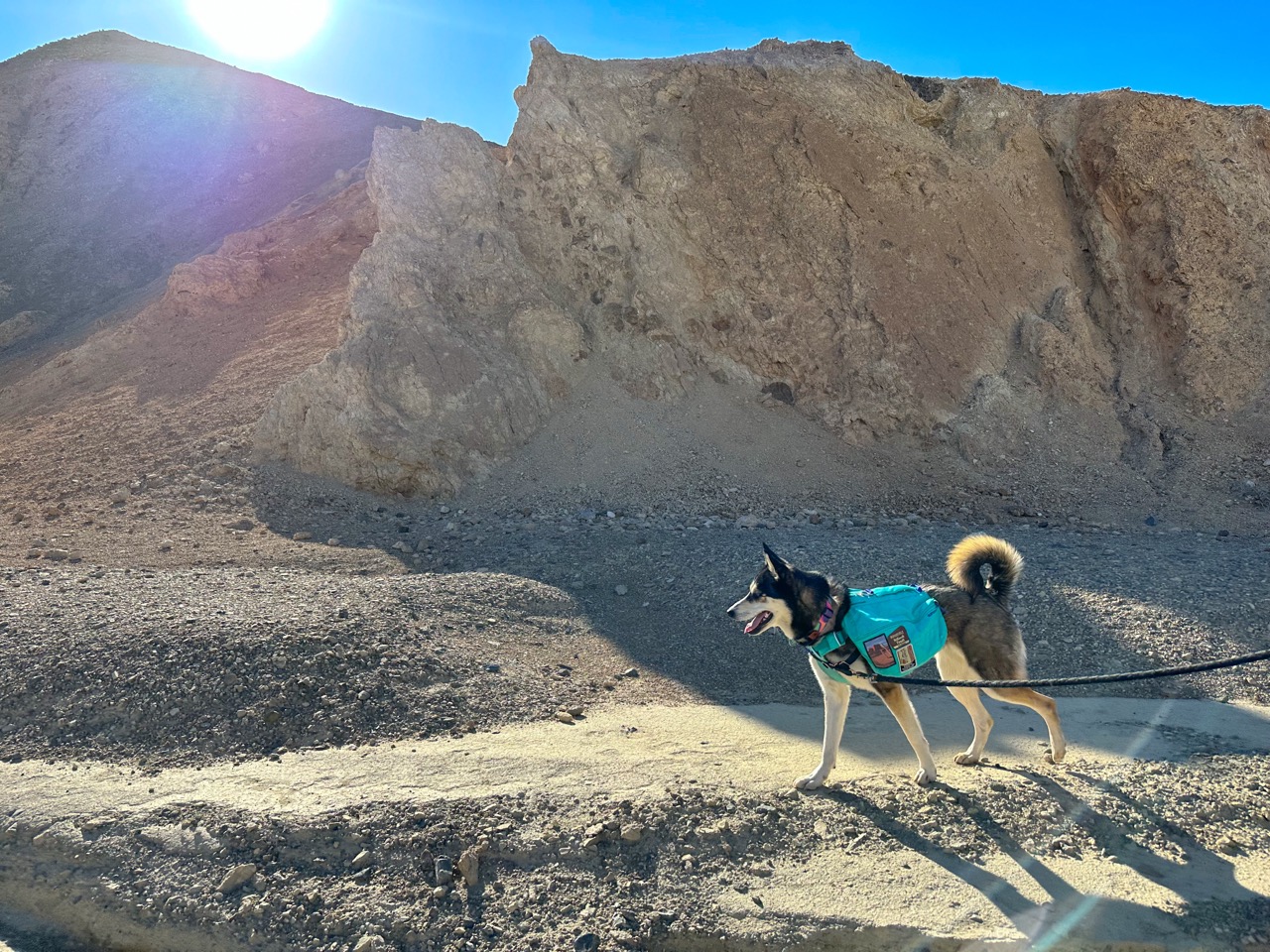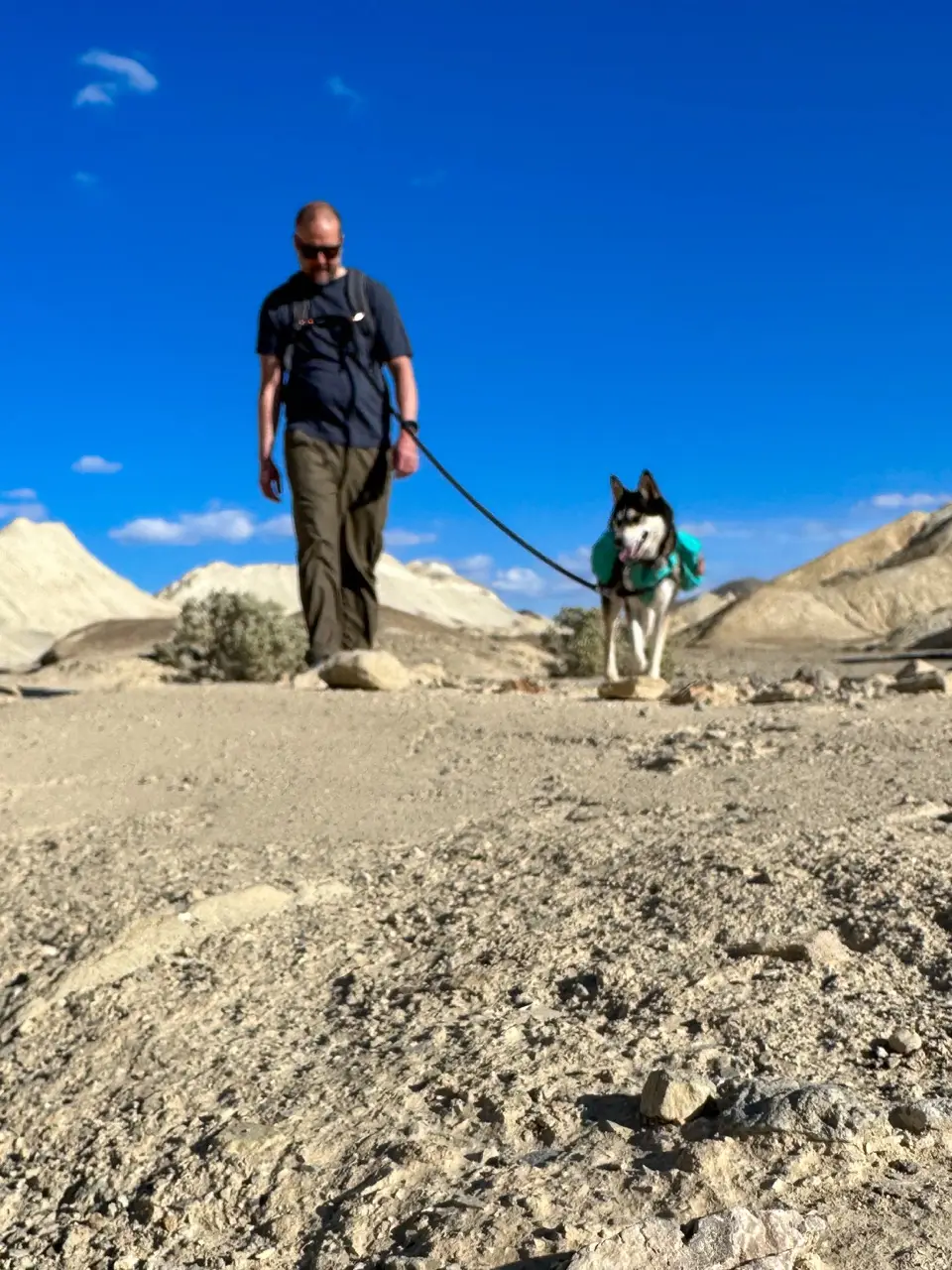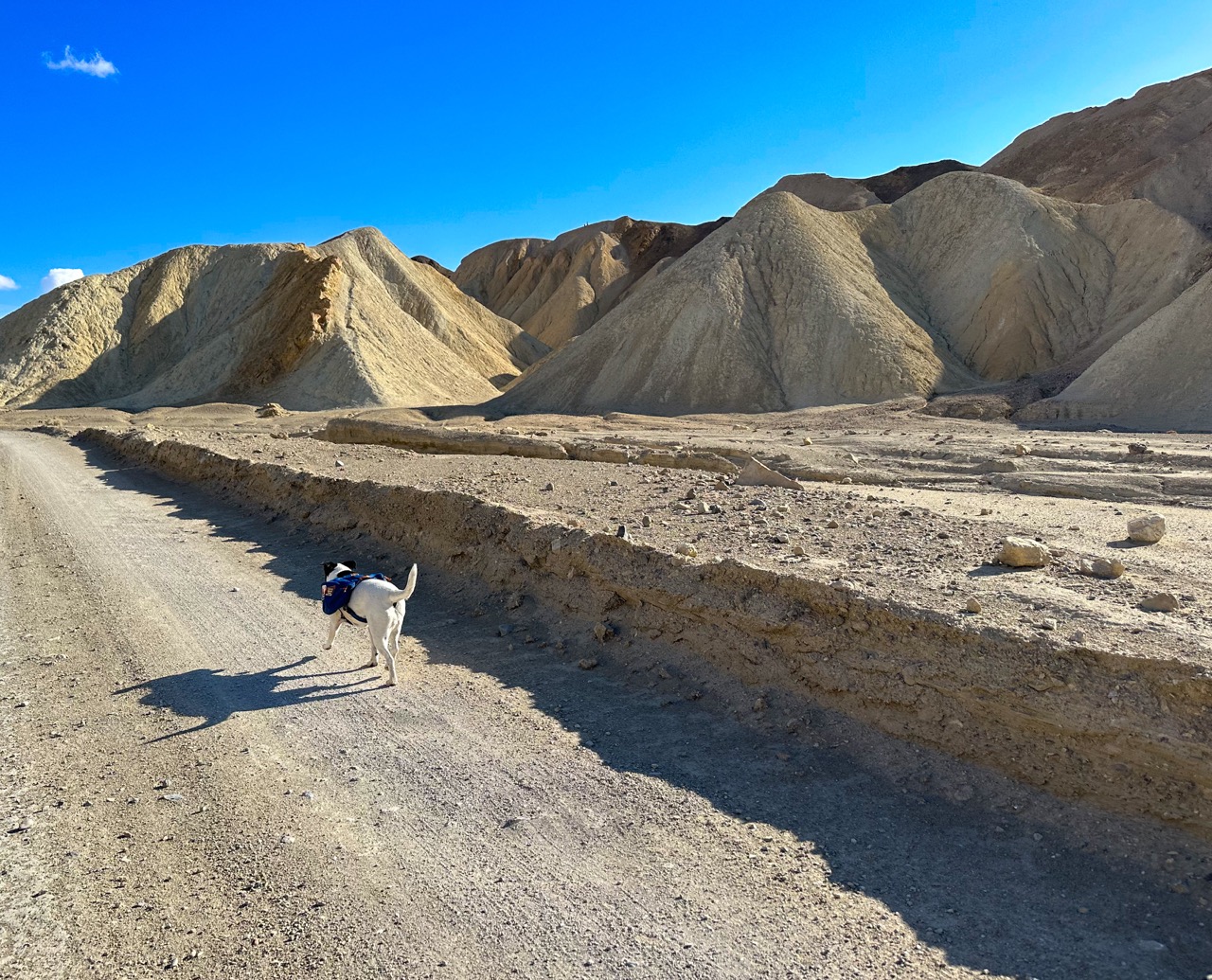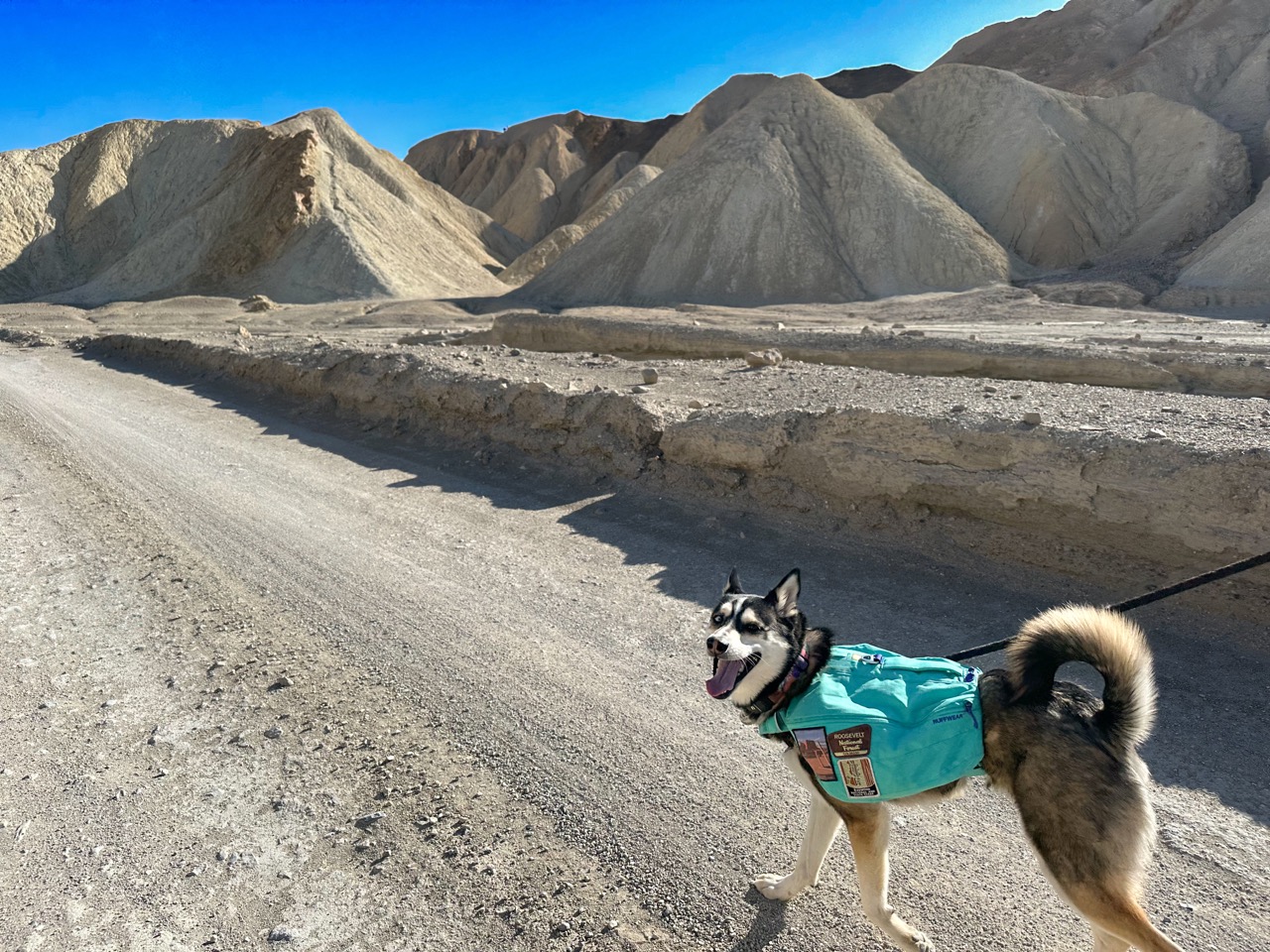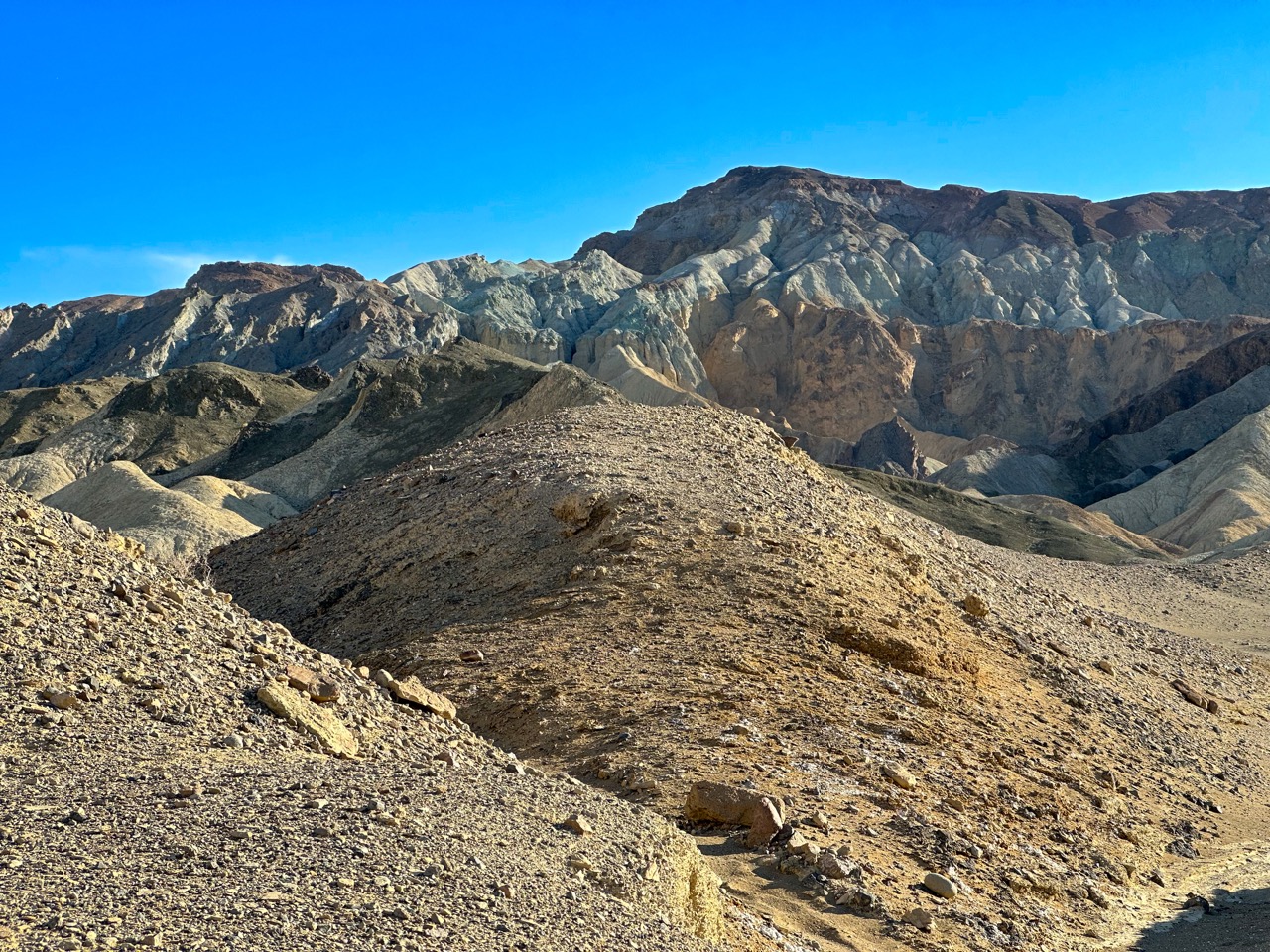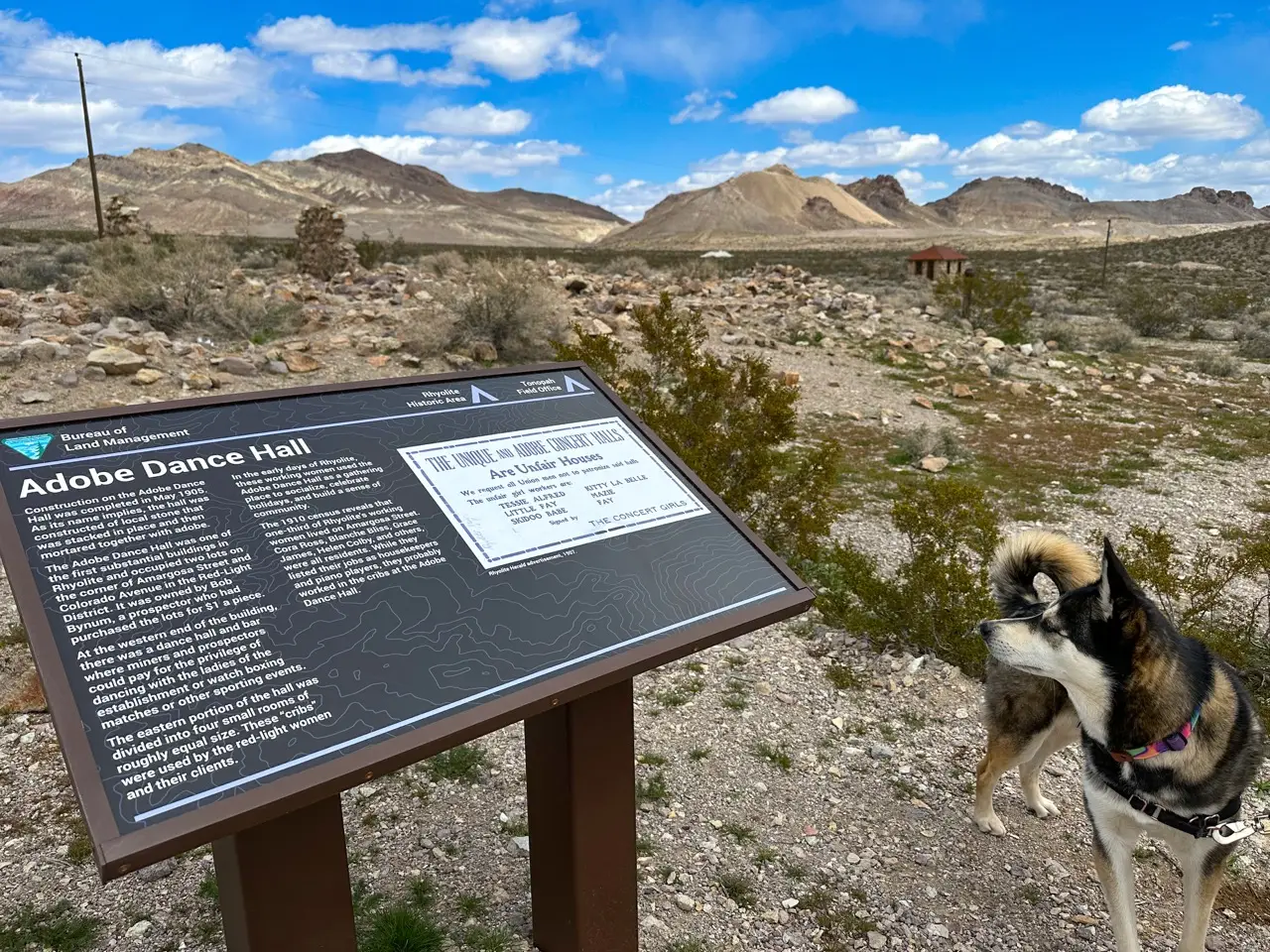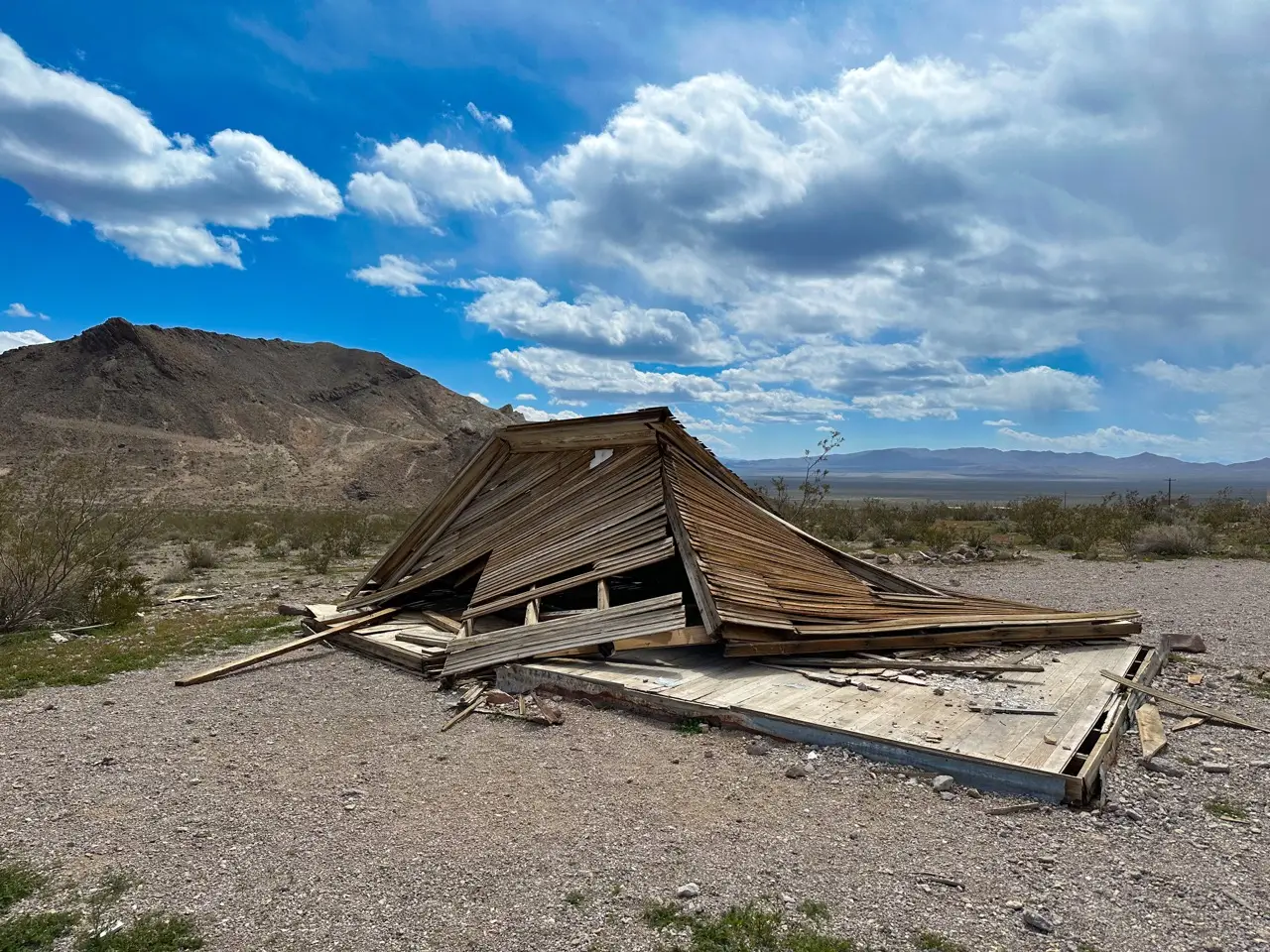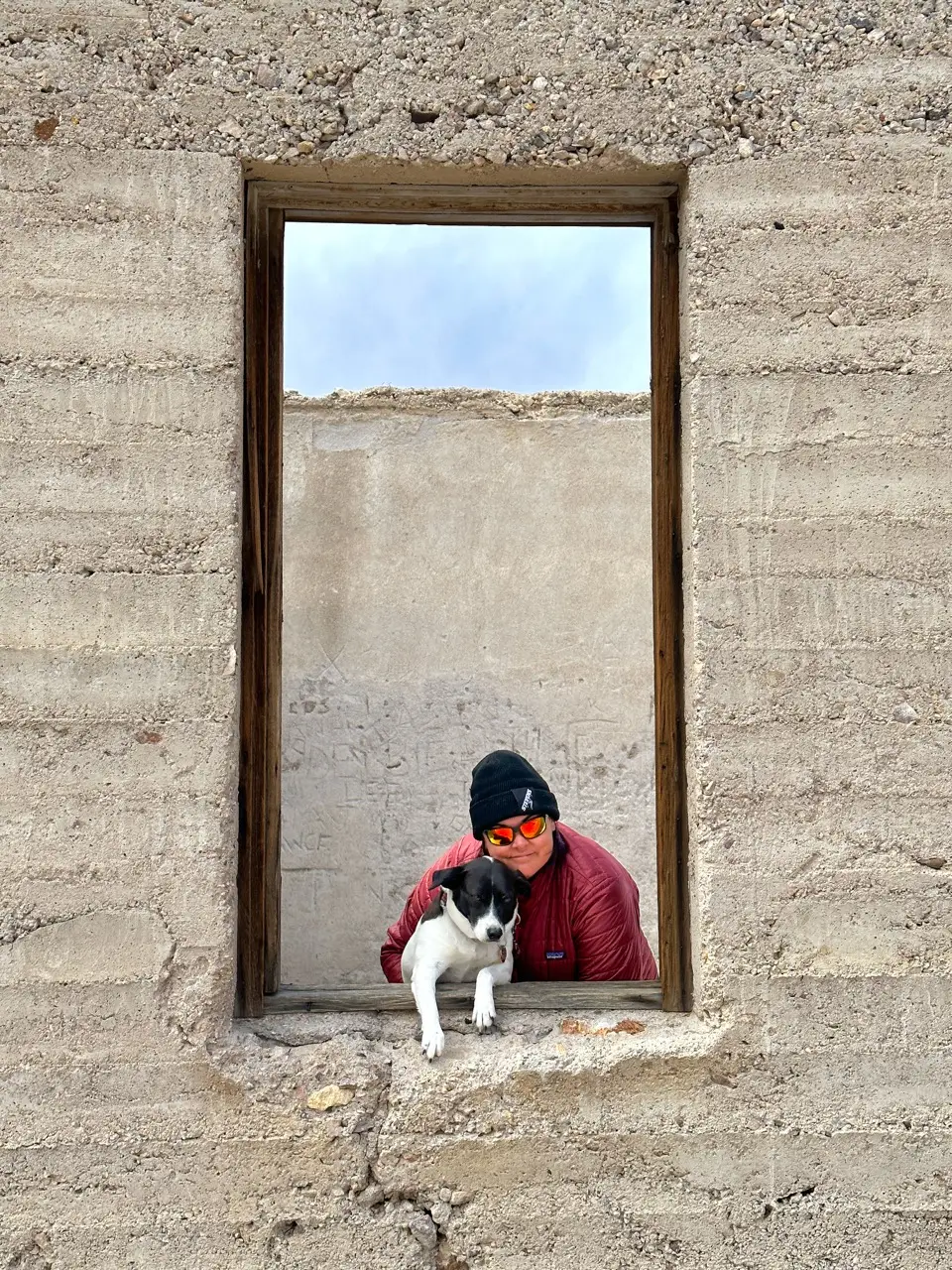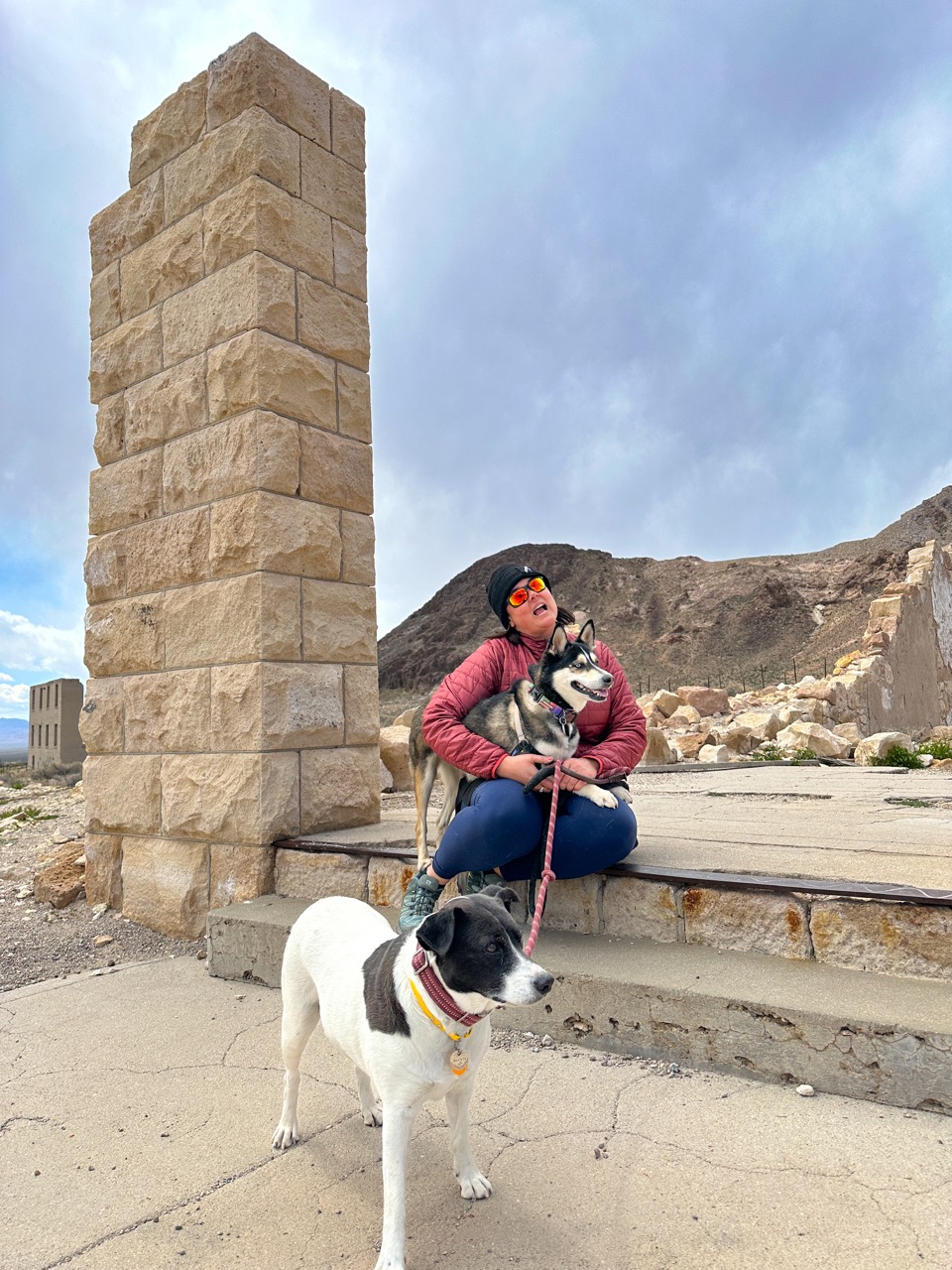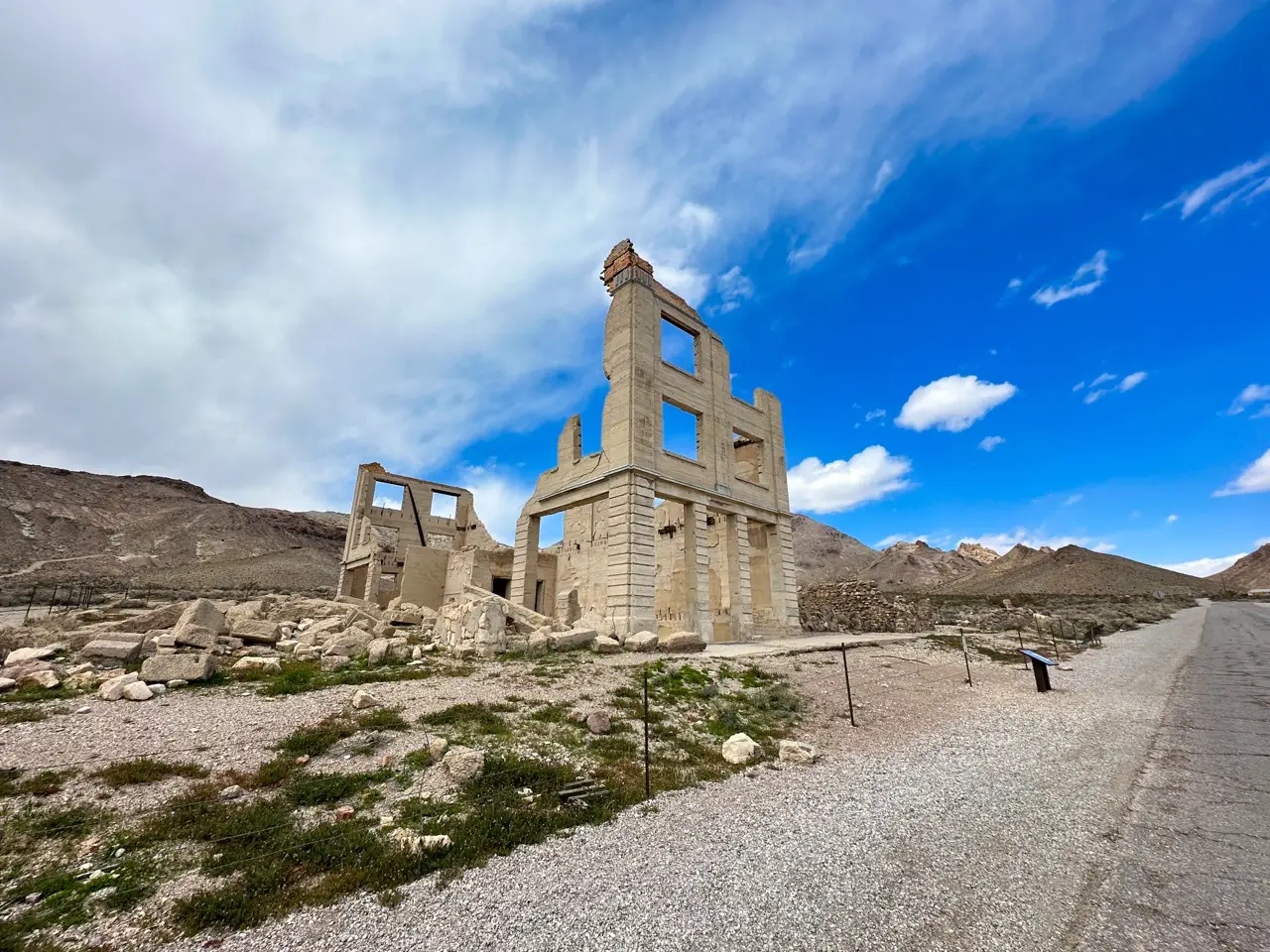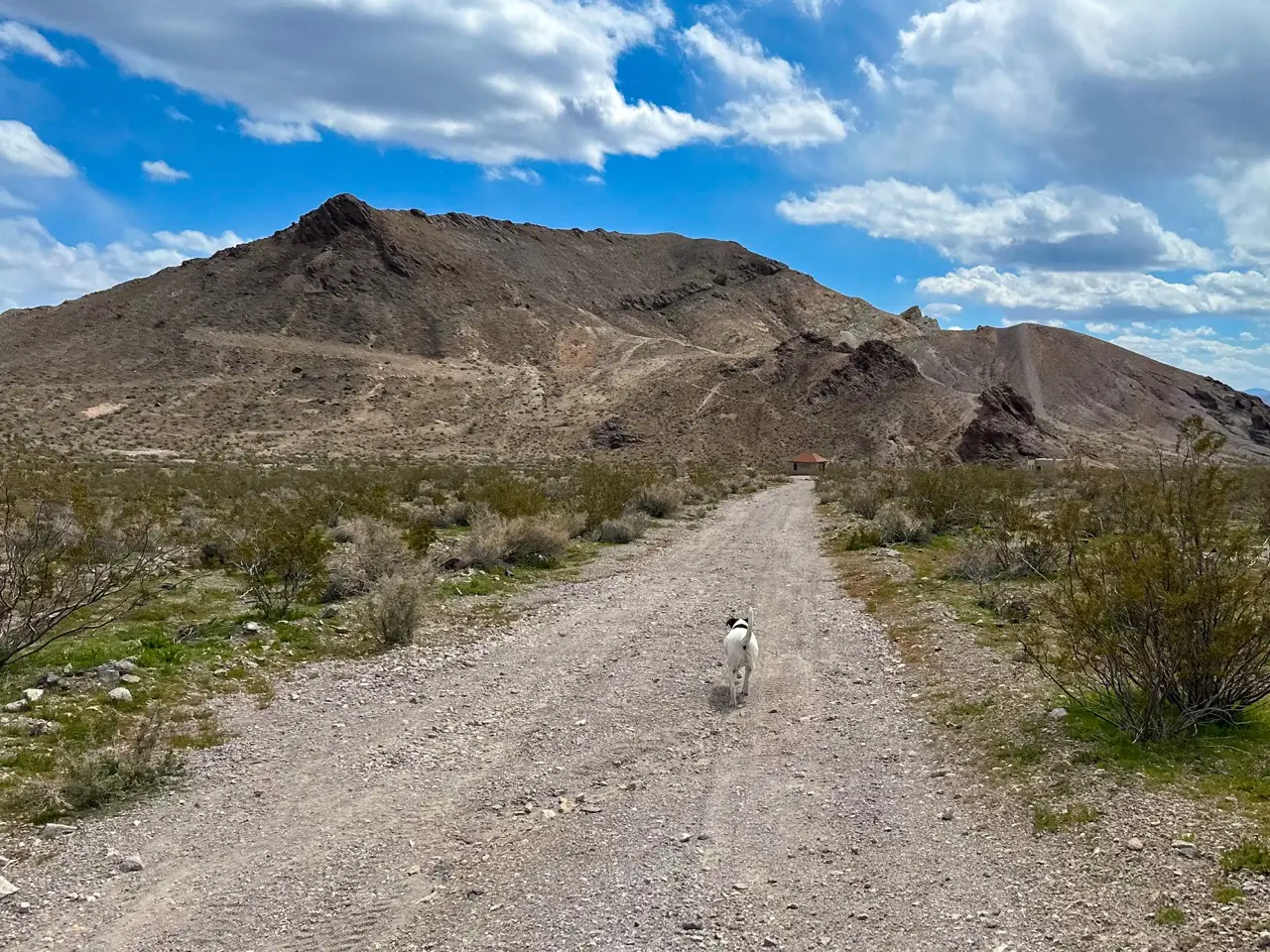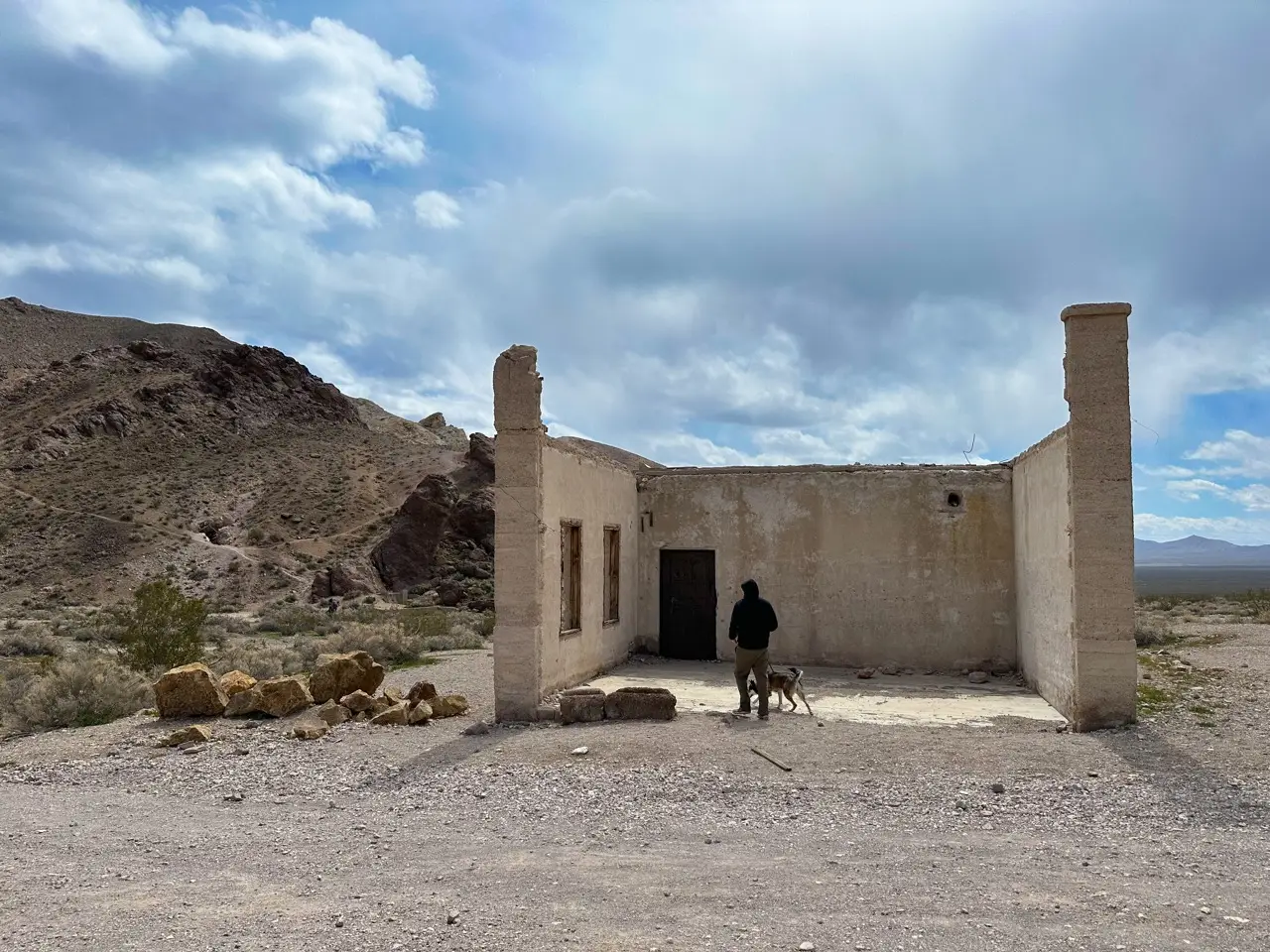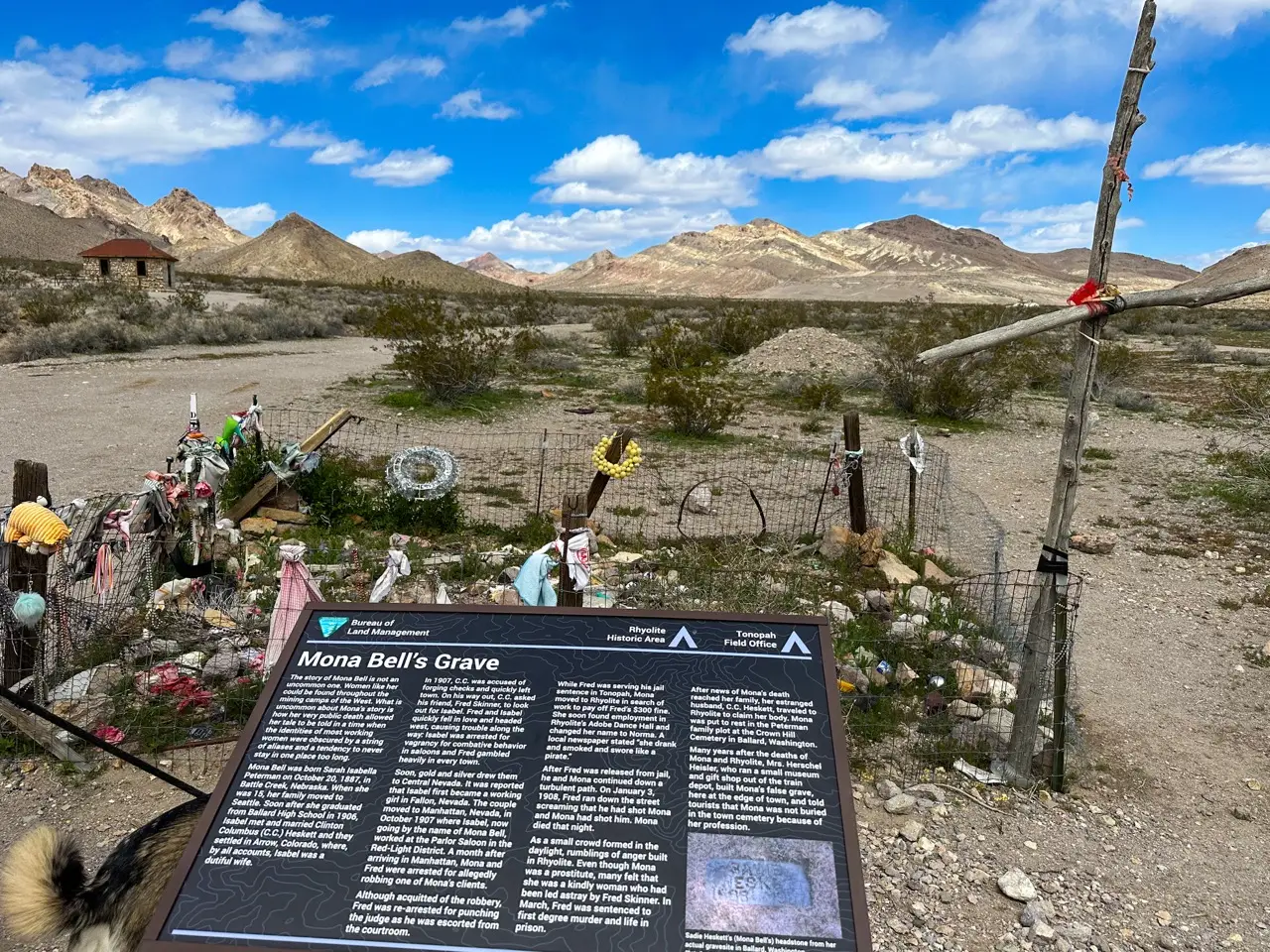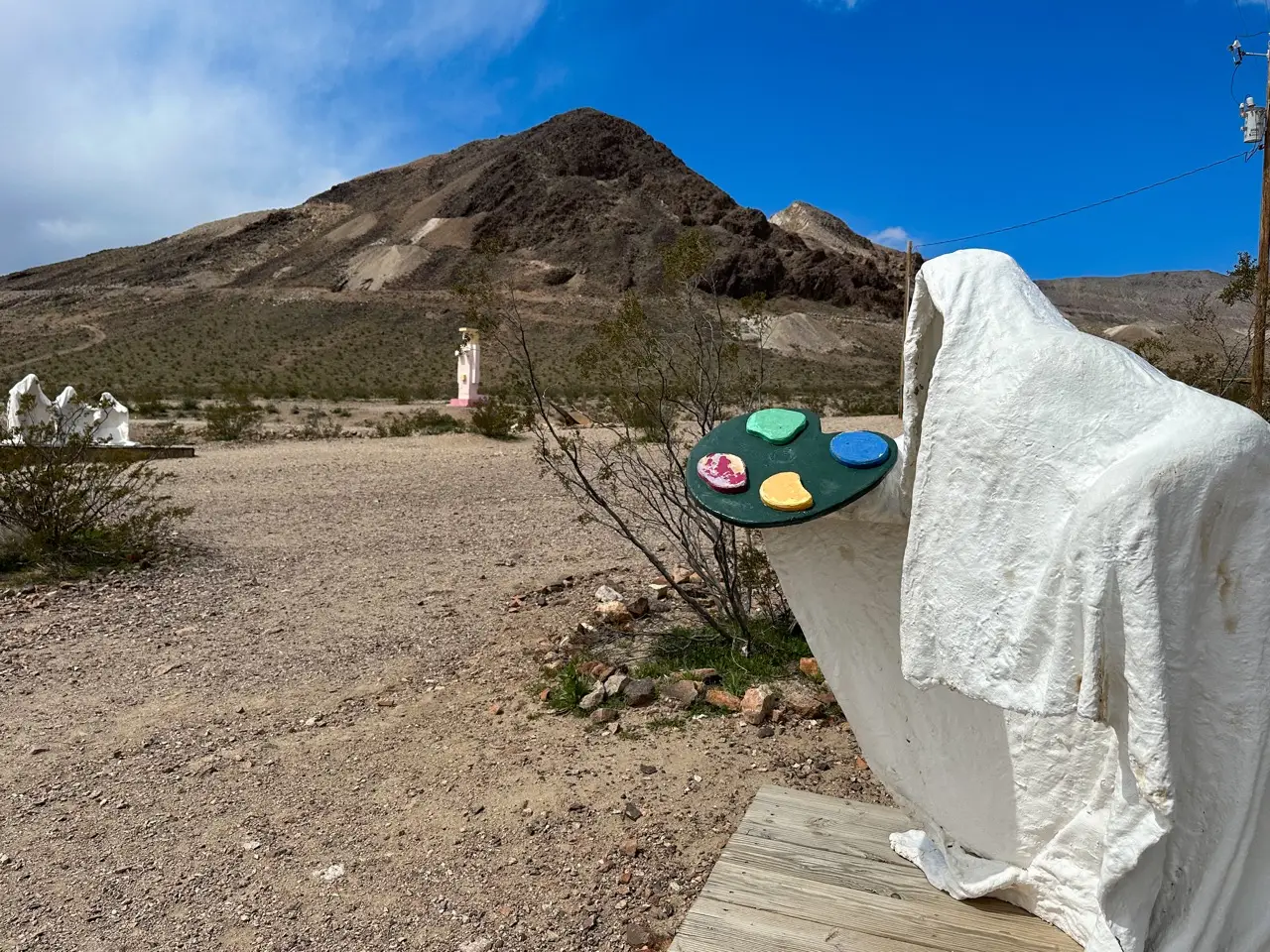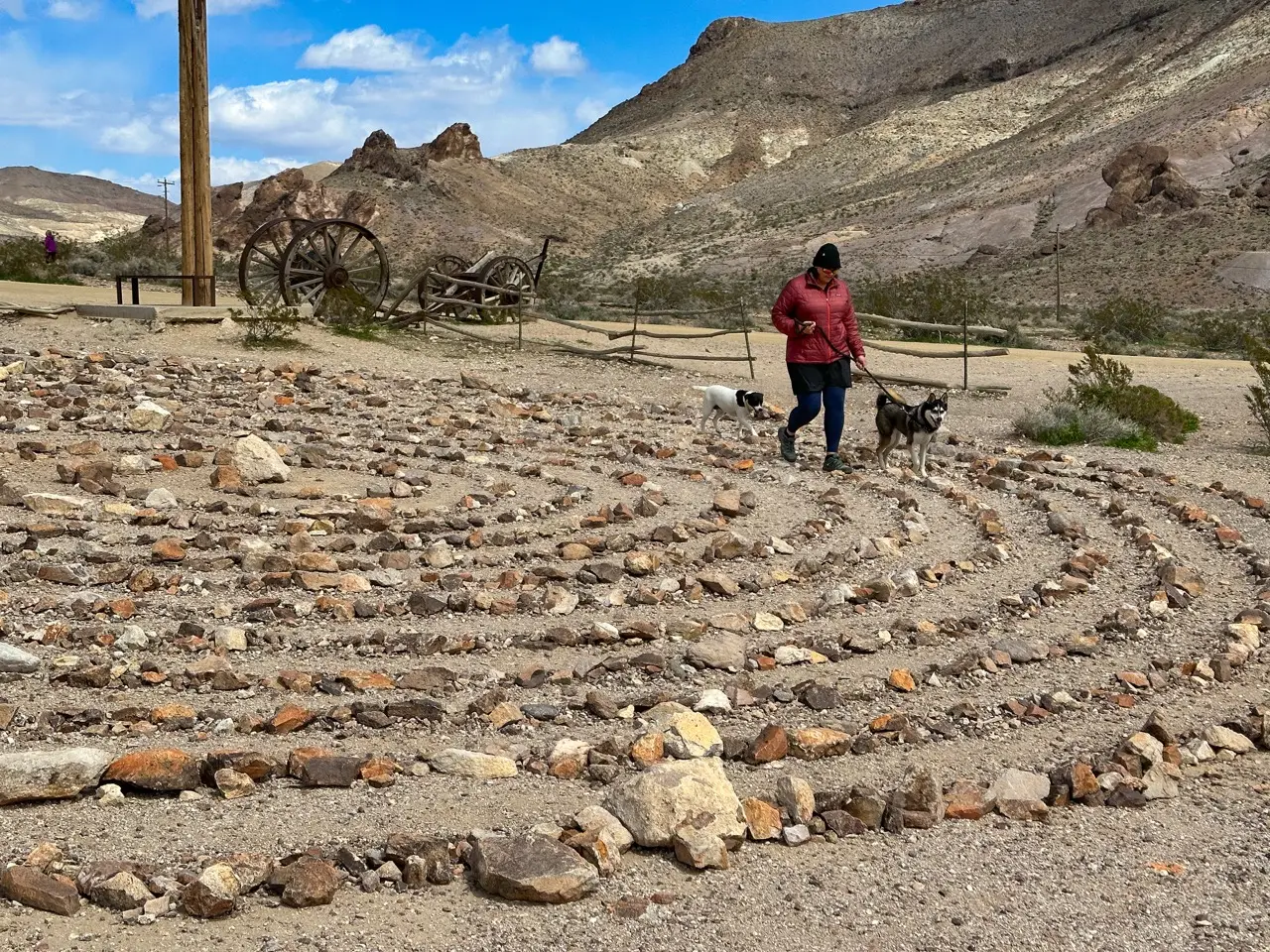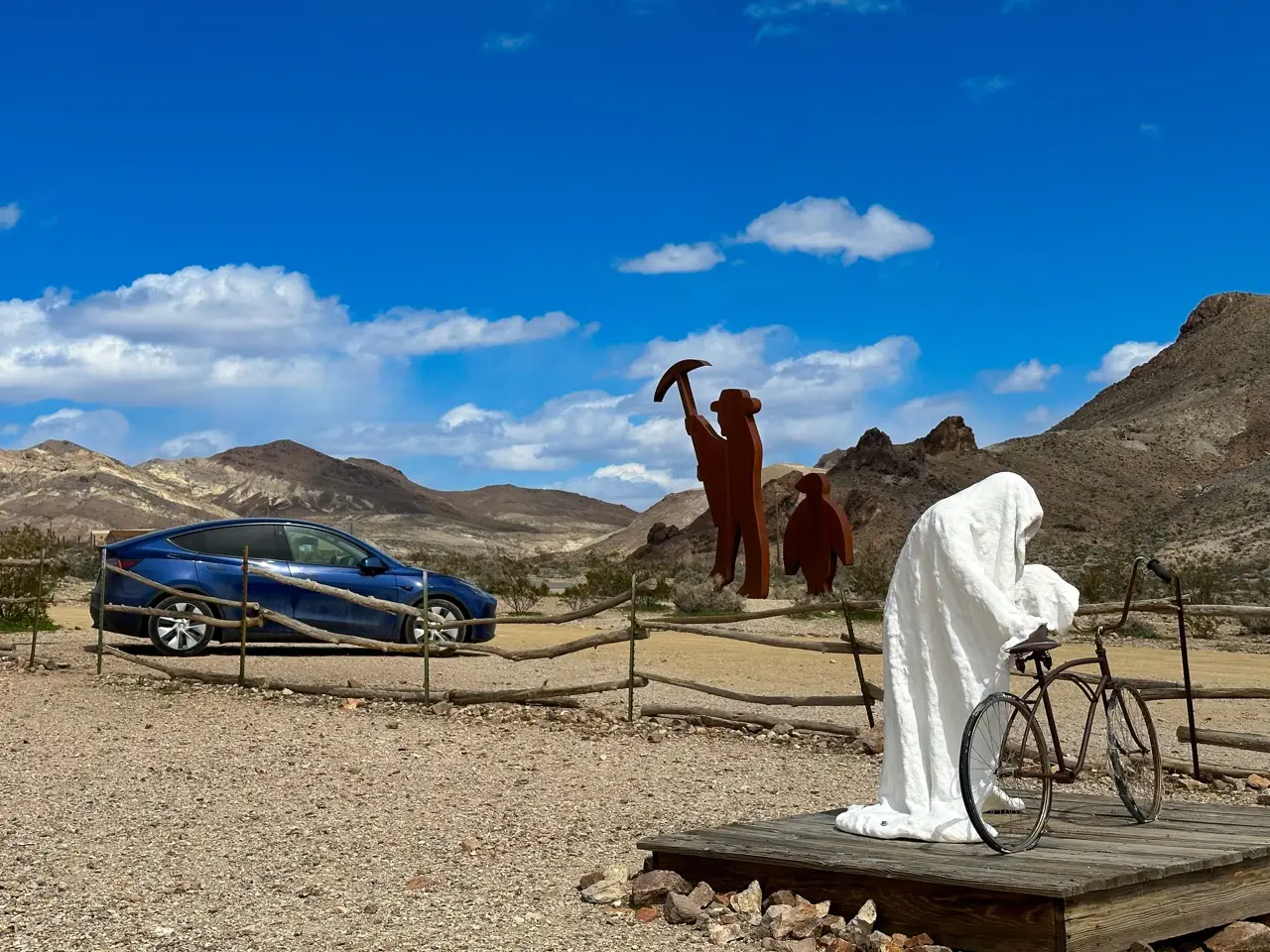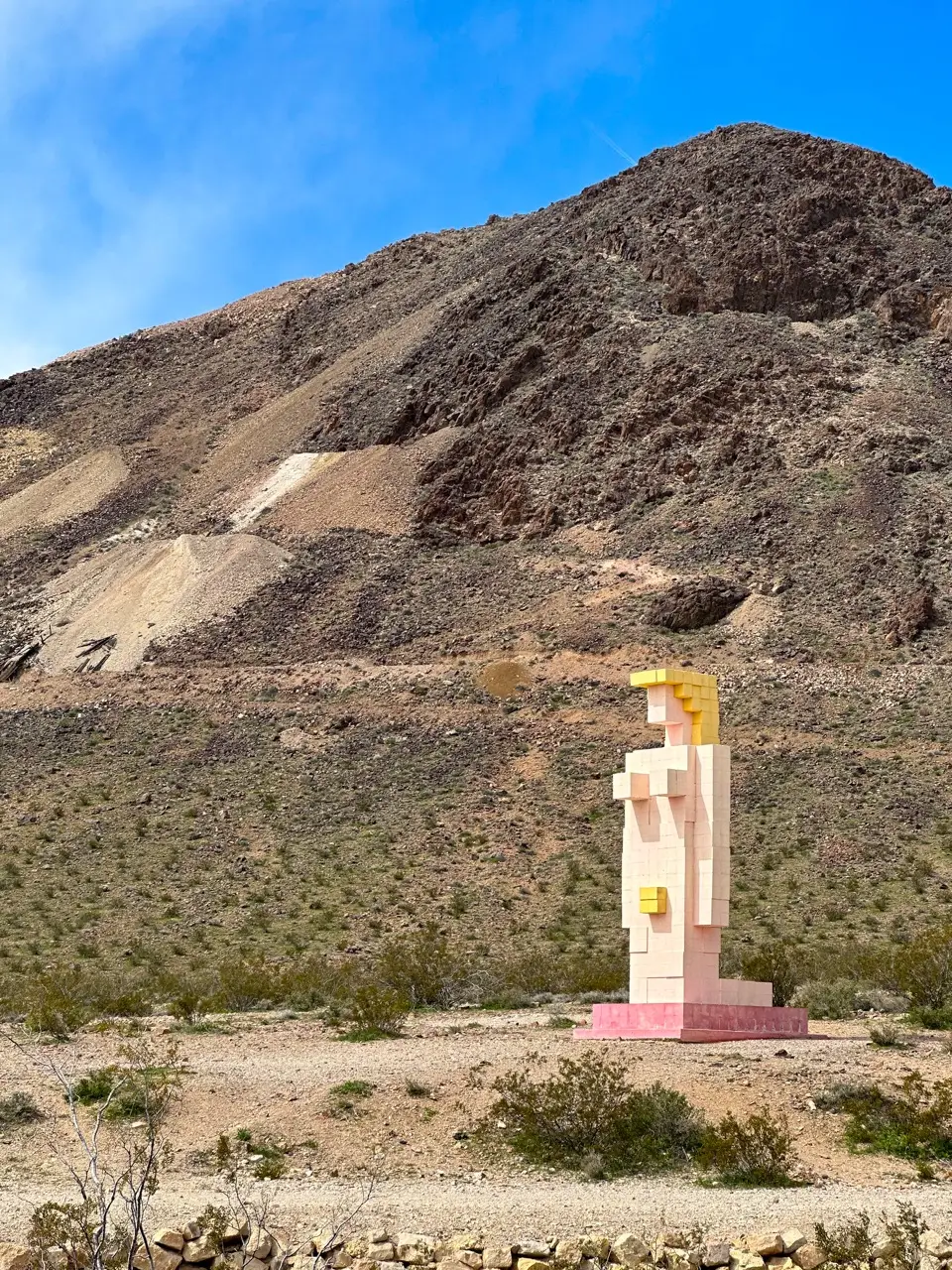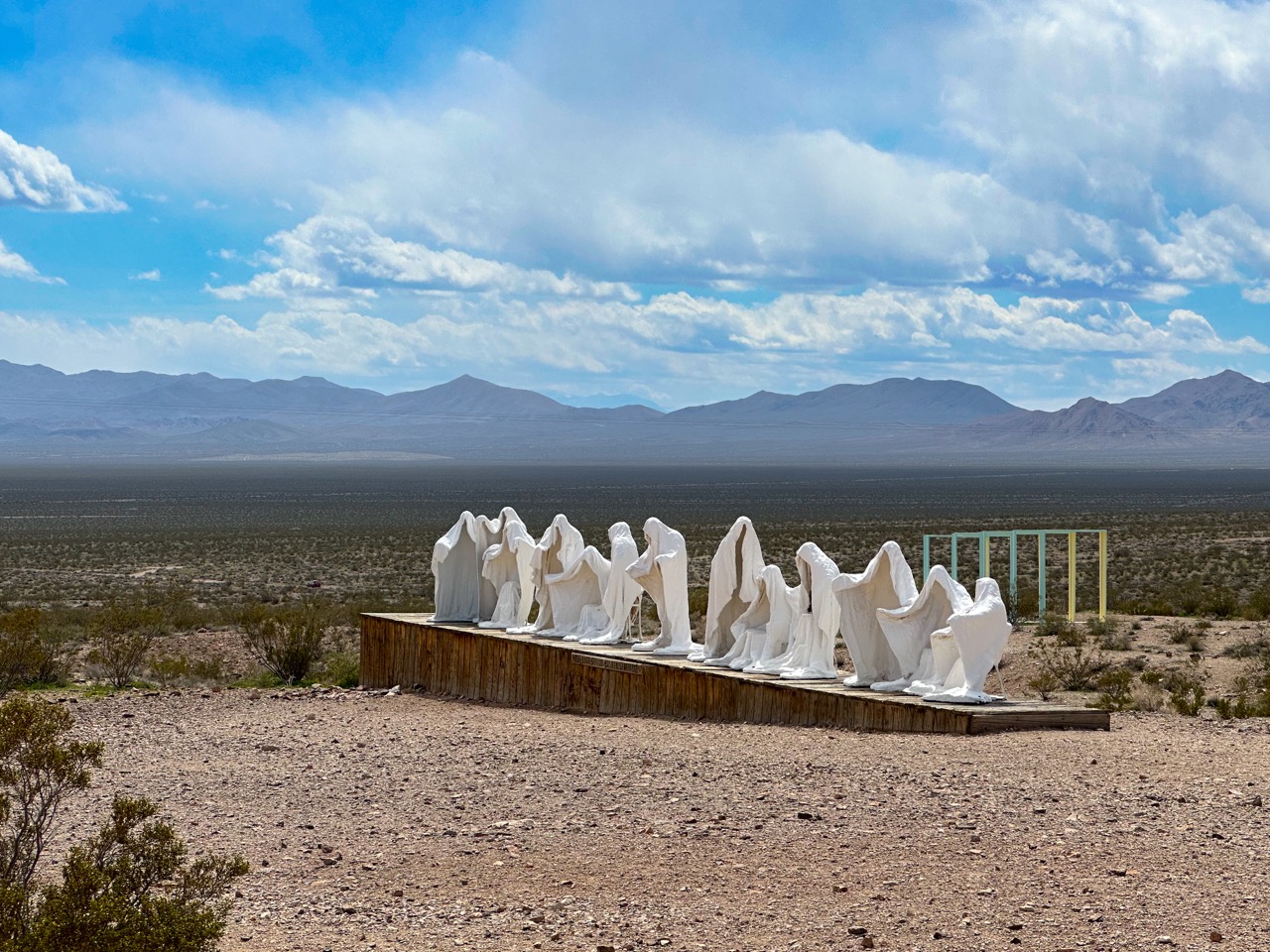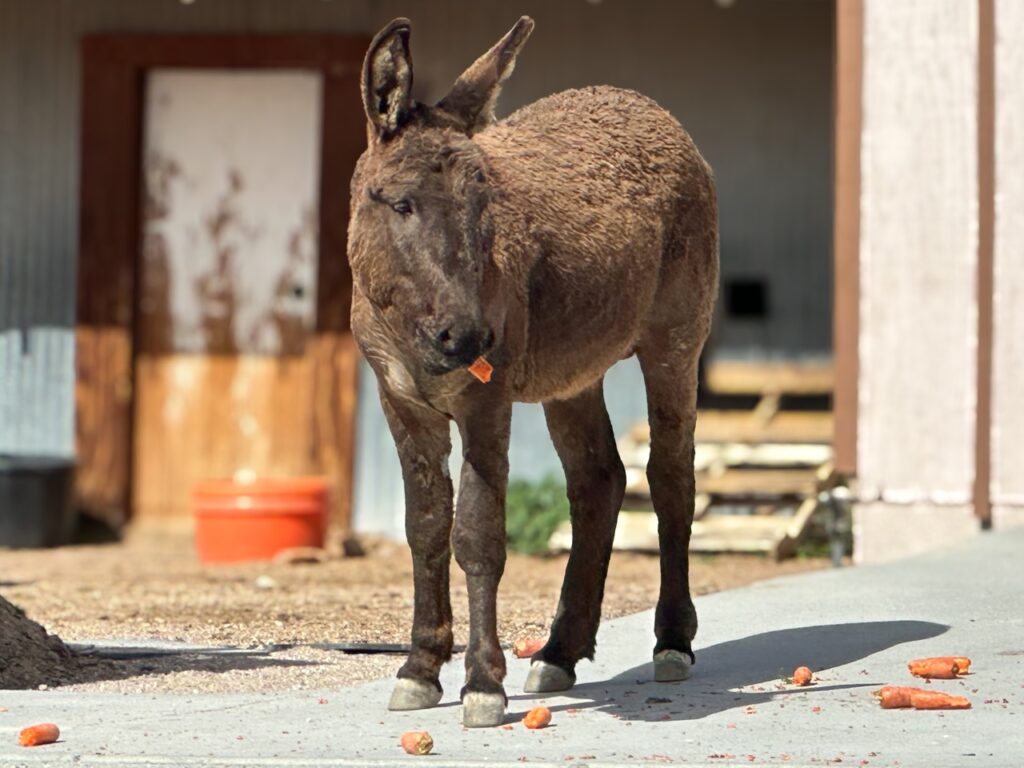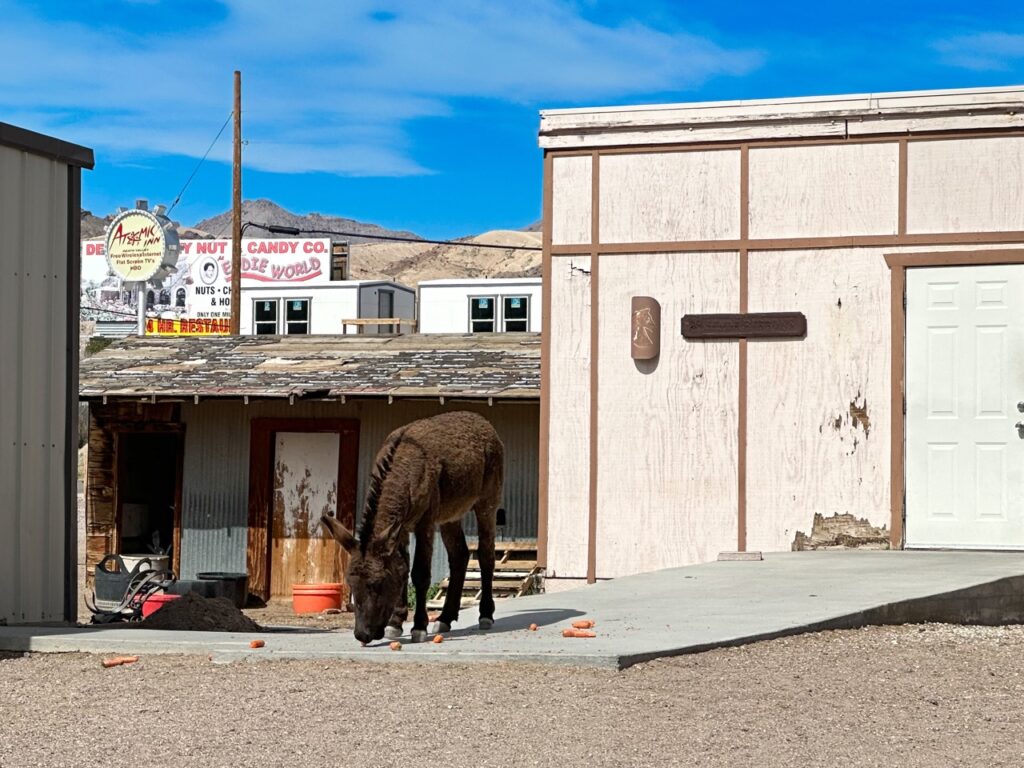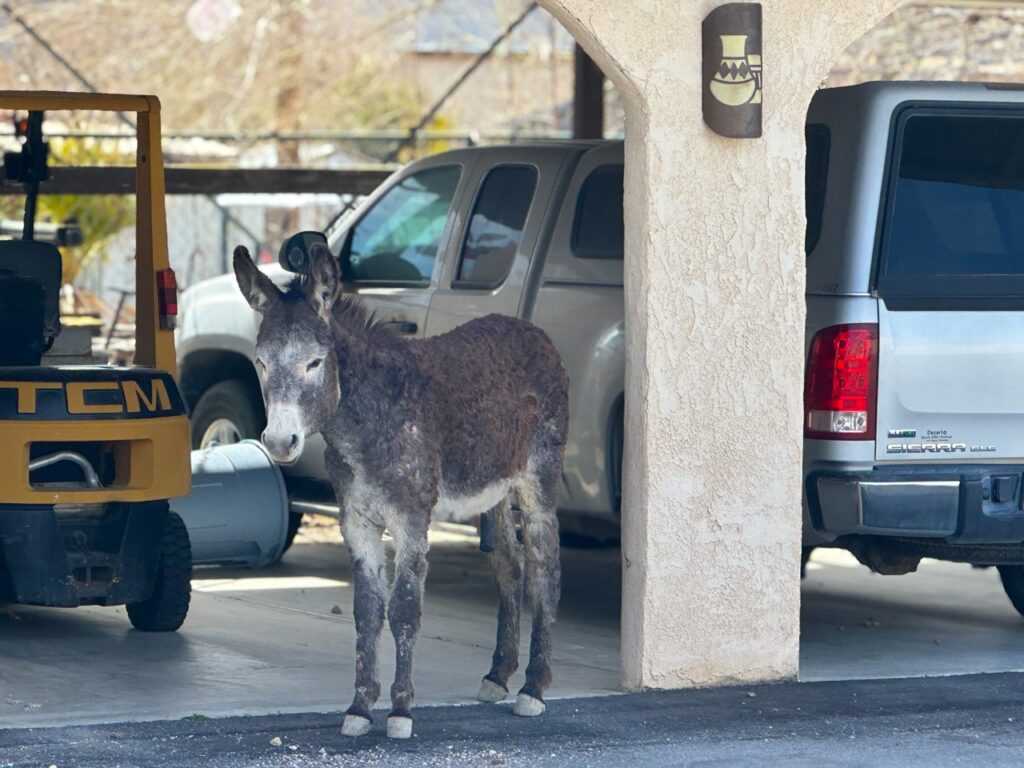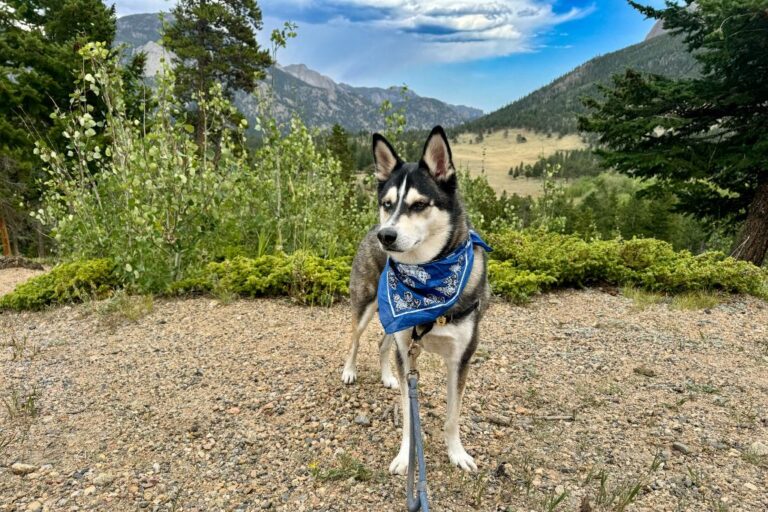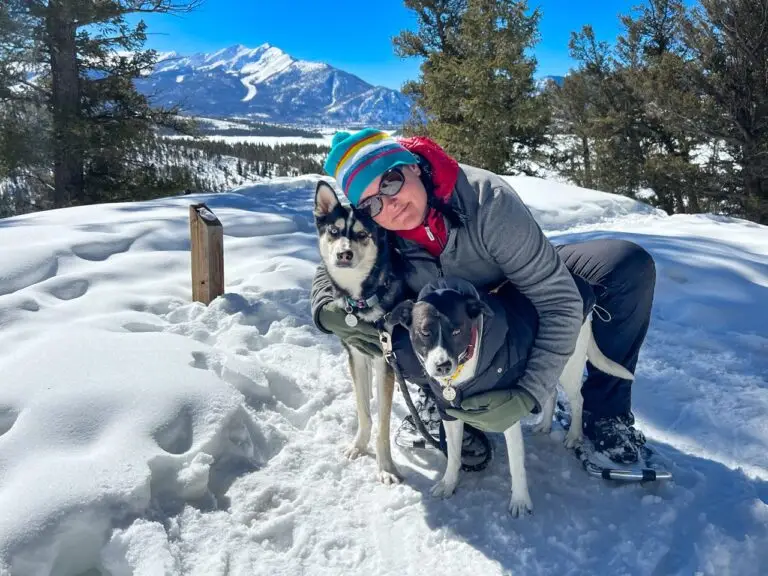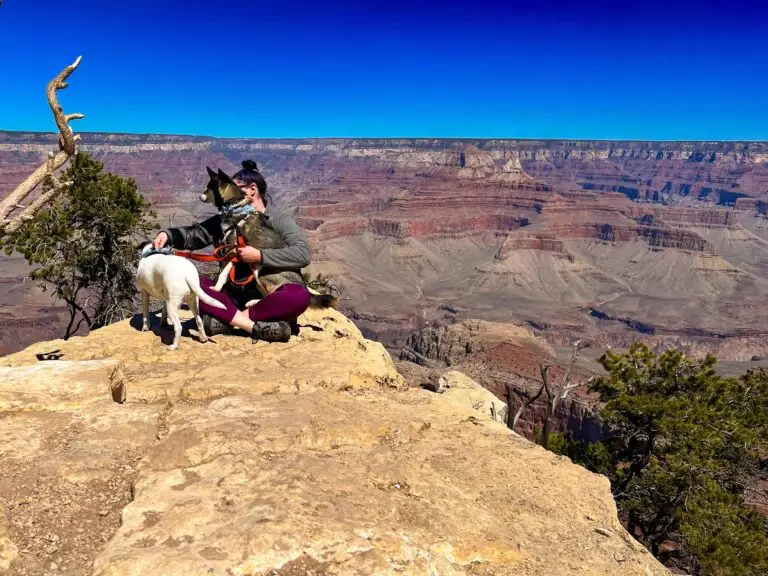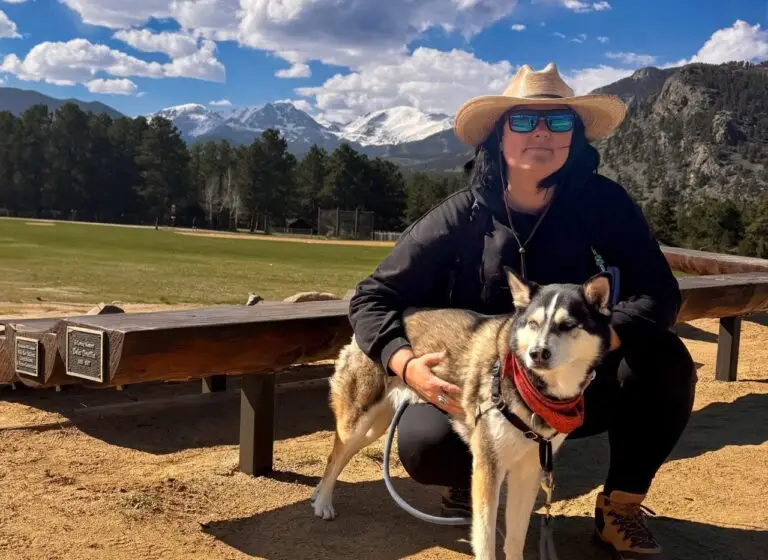Death Valley National Park: Dog-friendly guide
Death Valley National Park, spanning both California and Nevada, defies all expectations. It is wild, vast, diverse, and stunningly beautiful. It’s a place where you can stand at the lowest point in North America, Badwater Basin, and gaze upon the highest peak in the contiguous United States, Mount Whitney. And ALL of the colors and textures in between are nothing short of marvelous. While not a National Park typically associated with pet-friendly travel, in this post we share all of our tips, tricks, and secrets to navigating this incredible area with your dog.
This site contains affiliate links, which means when you click, we may receive a small commission from your purchase at no additional cost to you. This helps us run this page and offer great content free of charge, and we only recommend products that we use and love. We appreciate you!
Introduction to Death Valley National Park
Beneath a canopy of endless stars, where mountains cast shadows across an ancient, otherworldly expanse, lies Death Valley National Park, a realm of extremes and enchantment. This is a place where golden dunes dance with the wind, salt flats shimmer like cracked mirrors, and rugged peaks rise defiantly above a desert that holds secrets older than time itself. By day, the sun reigns supreme, bathing the land in shimmering heat, while twilight reveals a kaleidoscope of colors painting the horizon in hues of amber and violet. Here, nature’s raw beauty whispers tales of survival, solitude, and a timeless connection to the earth. Unline anyplace else in California, Death Valley is not just a destination; it’s an invitation to step into a landscape that feels as infinite as the imagination.
From the vibrant hues of Artists Palette, created by volcanic deposits, to the salt flats of Badwater Basin (North America’s lowest point at 282 feet below sea level) – the park’s geology is as diverse as it is mesmerizing. Rugged mountains, ancient lake beds, and eroded badlands like those at Zabriskie Point reflect millions of years of dynamic change.
Salt flats, badlands, snow-capped peaks, colorful mineral deposits, sand dunes, history – this park is like all other national parks packed into one! Death Valley has been on my wishlist for years, but I knew it would take a special kind of planning to pull it off with my trusty canine companions Bonnie & Ada. So in the spring of 2023, after months of pontificating and groundwork, we set off for this unforgiving landscape, willing to pull out all the stops and have a great time doing the things we COULD do in this park. And we were not disappointed! So here, I’m sharing all of our tips, tricks, and secrets, to save you the same tedium that I went through, and hopefully make your trip wonderful.
Related Posts:
- Guide to visiting (nearly) any National Park with your dog
- Hiking with your dog: 12 tips to always be pup-pared
The Challenge: Making Death Valley Dog-Friendly
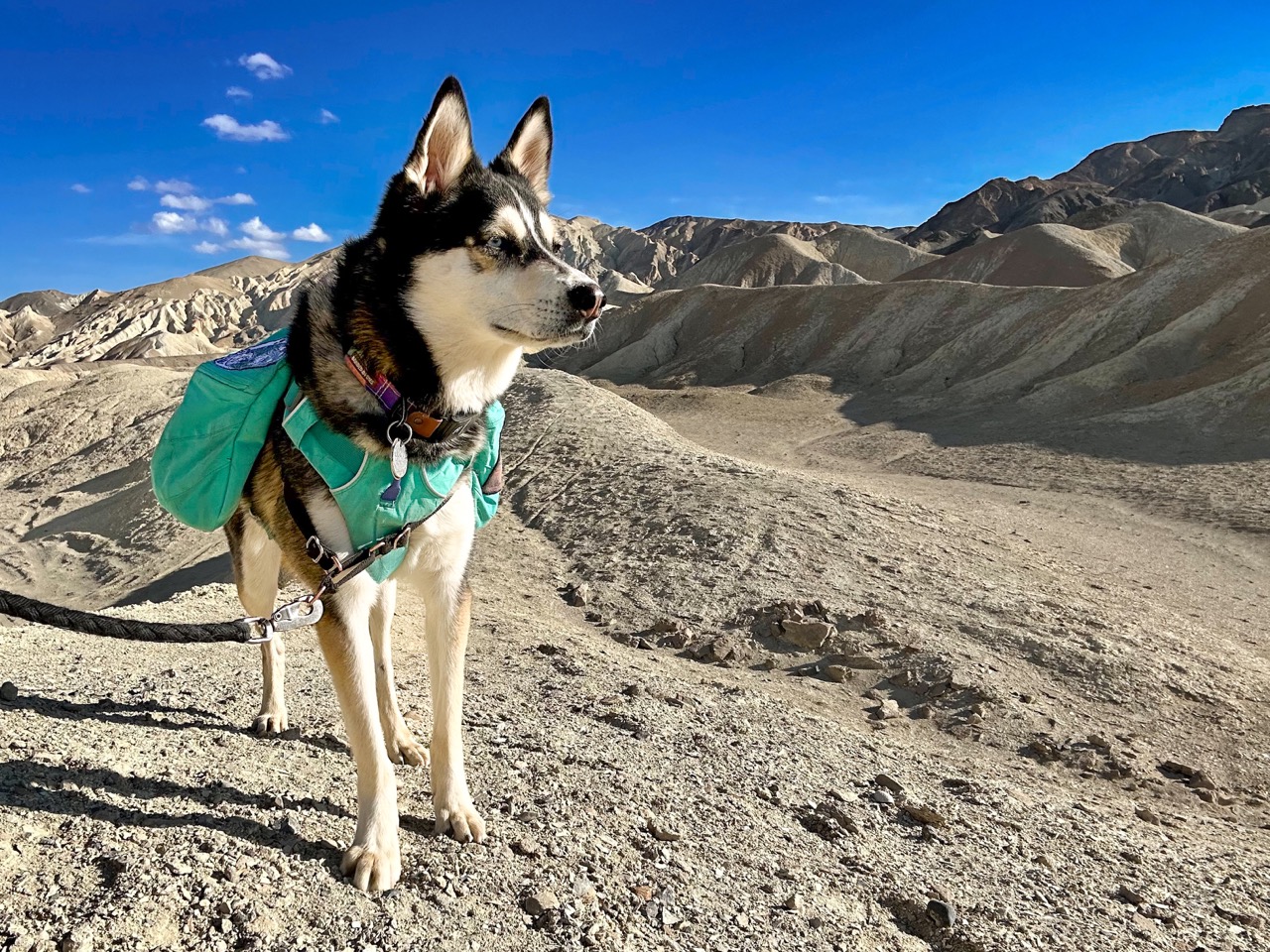
Death Valley does not advertise itself as a dog-friendly park. Thus, it’s often off the radar for dog-loving travelers. But we beg to differ! With some creative thinking, willingness to think outside the box, and some determination, you can have a great time here with your pooch.
There are a handful of big considerations to pay attention to as you start planning:
- Timing is everything – This park is best to visit in the cooler months. We recommend October – March. We visited in mid-March, and it was pretty hot (80’s-90’s during the hottest part of the day). We kept our outdoor activities to mornings and evenings, and we did great, but we don’t recommend visiting April – September.
- Your vehicle is essential – This park is ENORMOUS. Plan to do a lot of driving, and make sure your dog is comfortable with this. In this blog post, we’re only covering our recommended activities that we’ve explored so won’t be providing a thorough review of every single place in the park. If we ever get back, I’ll update this post.
- Book your place to stay first – Dogs are allowed in campgrounds, but there are NO dog-friendly hotels in the park. So unless you plan to camp, this means staying in one of the gateway towns, and driving in each day. (Again, LOTS of driving). Our dogs love car rides, so this worked fine for us. But wehre you stay is going to sdetermine what parts of the park you have access to, and how long it will take to get to the destinations you most want to visit.
- Pack smart – No matter when you visit, this park is extreme! You’ll want to pay special attention to what you pack to ensure safety and comfort, so I’m providing a complete packing list below.
- Monitor closures – Because of the constant extremes, it’s imperative that you check park conditions in the days before your trip, to find out if there are roads closed or other kinds of natural impediments to visiting various parts of the park.
Land Acknowledgement
Death Valley National Park, is located on the ancestral homelands of the Newe Sogobia (Western Shoshone) people.
To show respect to the native peoples who cared for these lands long before white settlers, we do several things:
- Research and speak the names of the traditional guardians of the land. We use Native-land.ca
- Ask permission from the land itself before we enter. It might seem silly at first, but the more this becomes a habit, the more you become attuned to the ways in which the land speaks.
- Make donations to native-led organizations that support the communities whose ancestral lands were stolen.
Park Policies
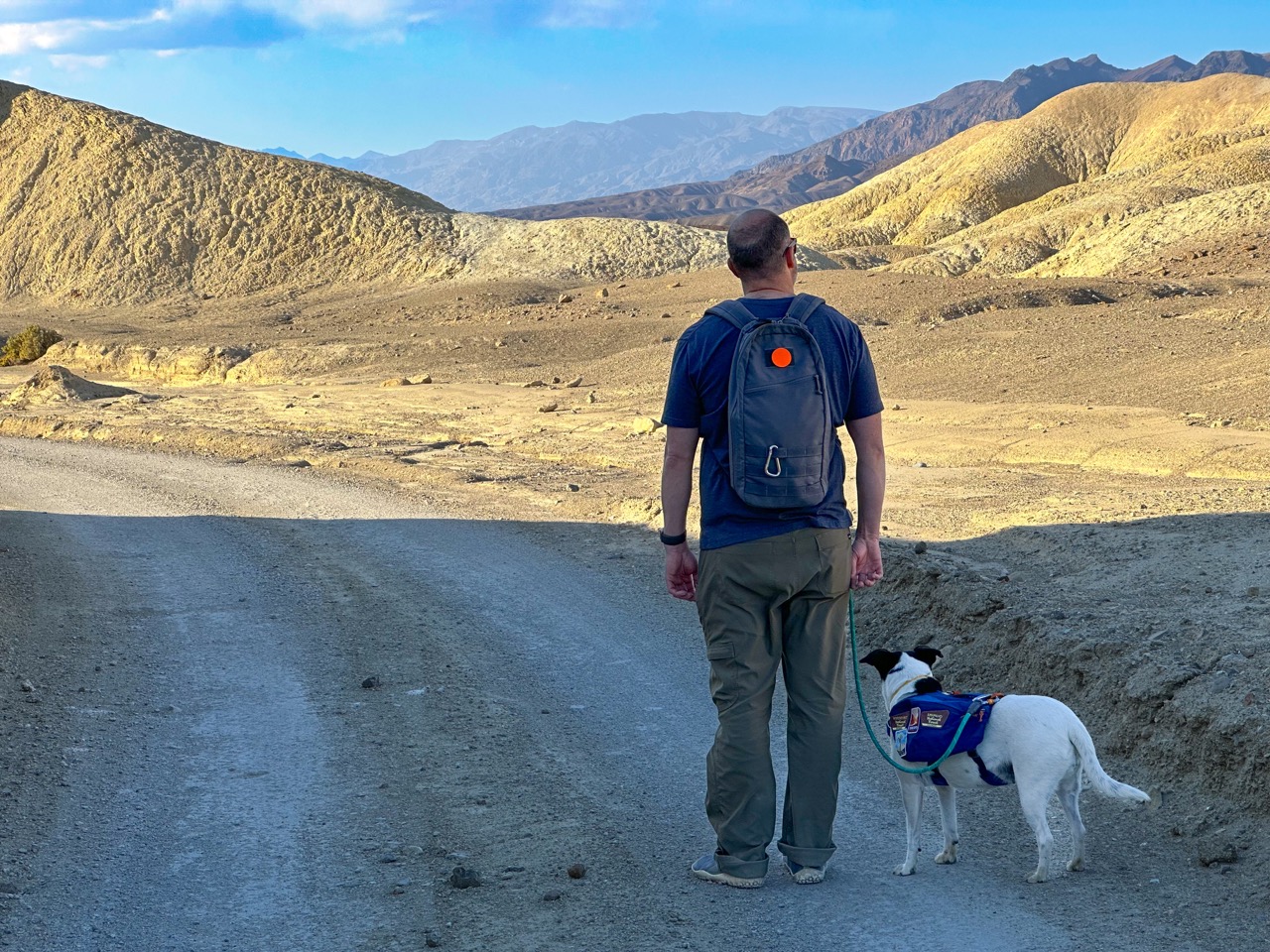
According to their website – Pets are allowed in developed areas of Death Valley National Park, including roads, parking lots, campgrounds, and near federal buildings, provided they are leashed. To ensure the safety of pets, visitors, and wildlife, pets are not permitted in undeveloped areas, where they face dangers like wildlife encounters, hazardous plants, and extreme heat. Limiting pet access also minimizes conflicts with other visitors and prevents disturbances to native animals, as the presence of pets can alter wildlife behavior and spread diseases through pet waste.
So keep reading for how we followed all these rules, but still had a magical time.
For more details about Death Valley’s pet policies, click here
Things to do in Death Valley with dogs
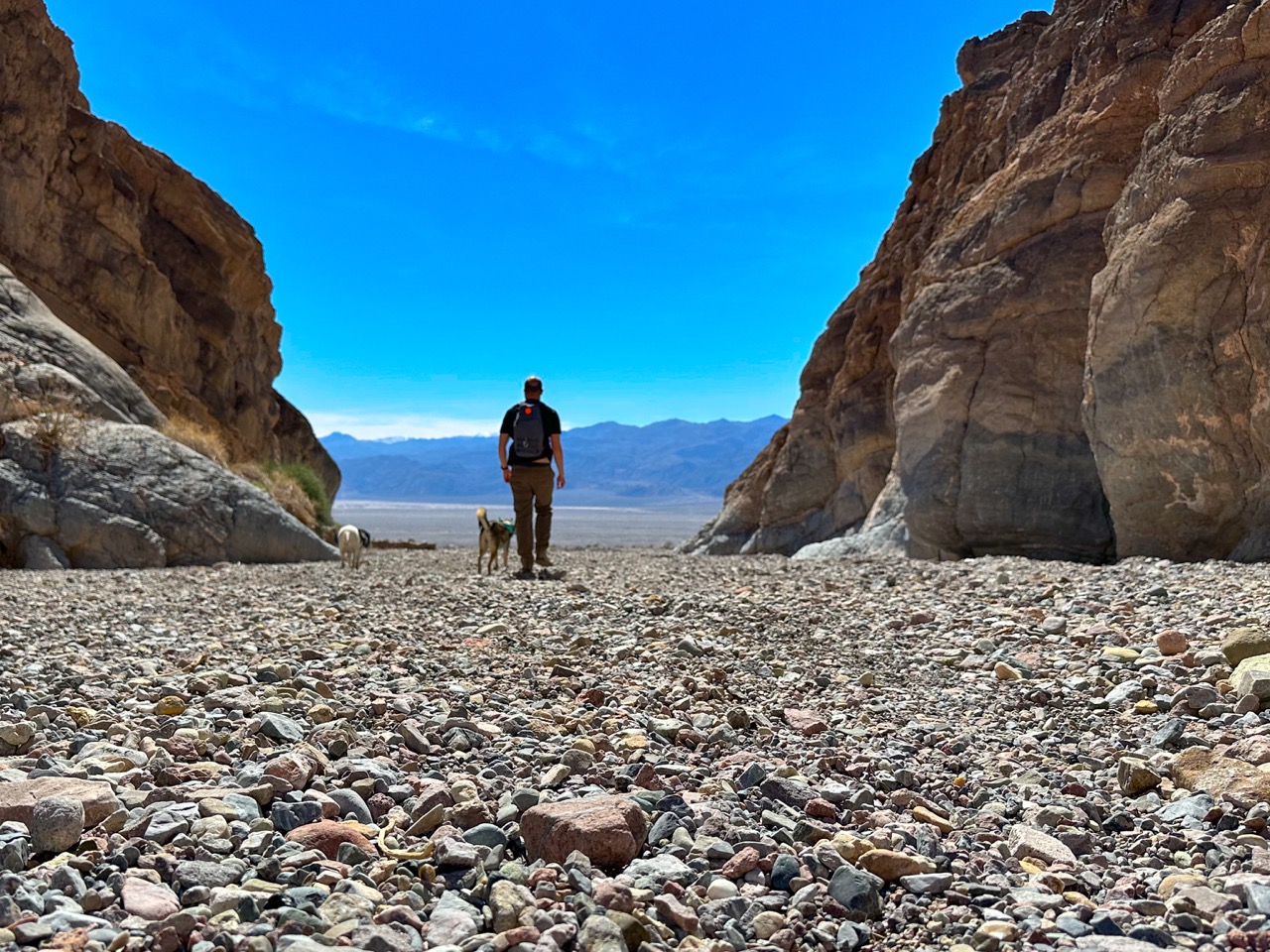
Ok, let’s get down to it. No, you can’t hike on trails. But you CAN hike on roads. Many of the iconic scenic viewpoints are located off paved roads where your dogs can walk around with you, and so much of the spectacle of Death Valley is visible from the windows of your vehicle.
Scenic drives
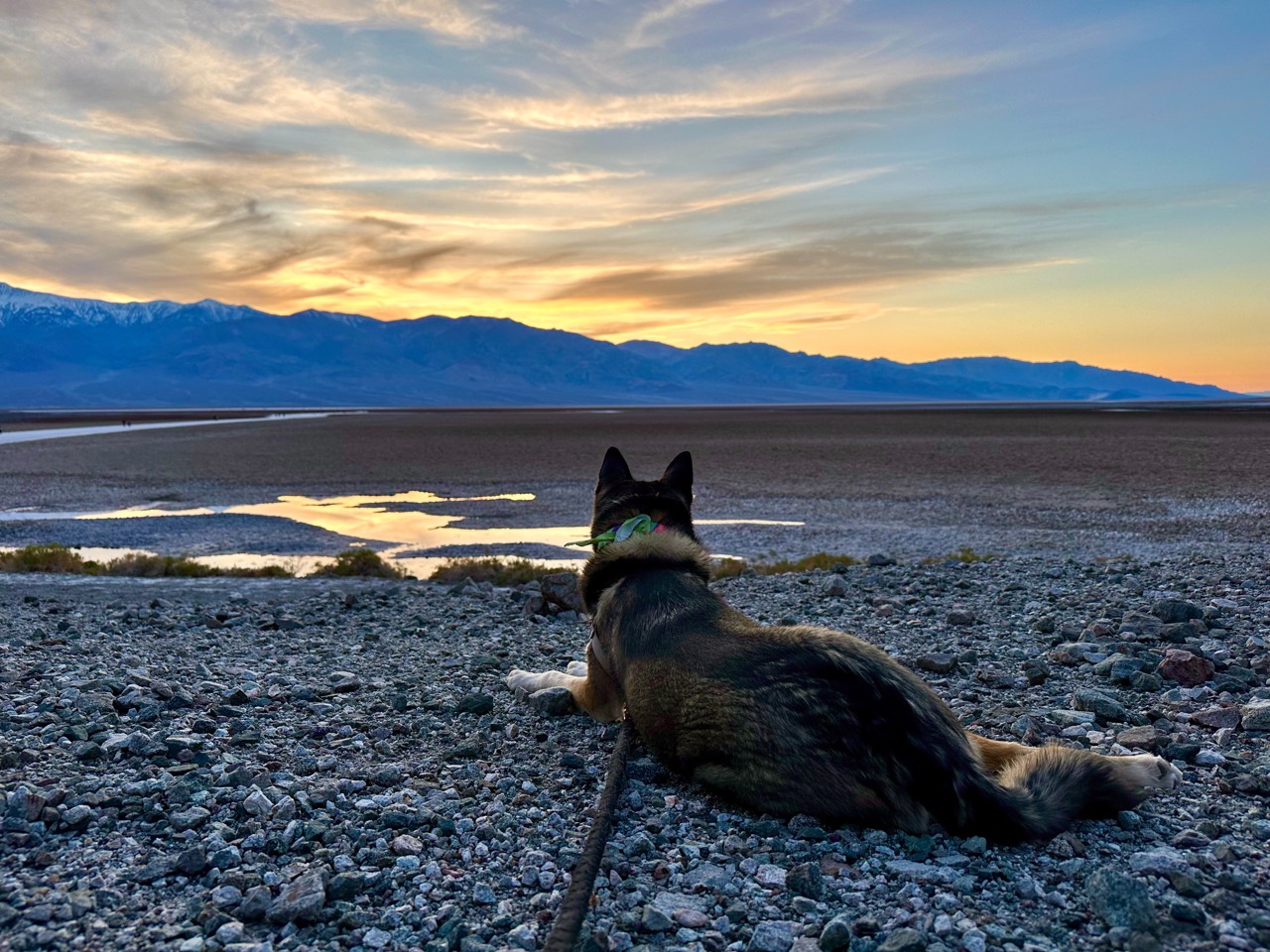
🚙Artists Drive
This nine-mile (14.5 km) one-way paved road winds through vibrant, multicolored hills formed by volcanic deposits. The colors are particularly striking in the afternoon light. With a vehicle length restriction of 25 feet (8 m) due to sharp turns and dips, the drive offers a thrilling yet accessible experience. Watch for cyclists and pedestrians as this scenic route is a favorite among visitors.
Your dog can’t walk on the trails into the various landmarks, but they can walk along the road with you, and stretch their legs at the various viewpoint stops.
🚙Badwater Road (Start at Furnace Creek Visitor Center)
Badwater Road is a key route in Death Valley National Park, stretching 45.2 miles and providing access to iconic attractions like Artist’s Palette, Devil’s Golf Course, and Badwater Basin, the lowest point in North America at 282 feet below sea level. This paved road allows easy access to top sights without extensive hiking. While summer drives offer air-conditioned comfort from the extreme heat, visitors should prepare for potential wildlife encounters and carry essential supplies, as there are no services along the road. In spring, the route often bursts into a vibrant wildflower bloom, making it a scenic and unforgettable drive.
Your dog can stretch their legs at Devil’s Golf Course, and even walk along that short road through the wild landscape. And they can also jump out and walk around at the Badwater Basin viewpoint with you, though they can’t actually walk out on the salt flats.
Note: If there is ONE place in the park that we recommend walking without your dog, it’s the mile long trek out into the middle of Badwater Basin! When we visited, Bryan and I took turns walking out onto the salt flats, while the other stayed at the parking lot with the dogs. It doubled the time it took to take in this spectacular spot, but it was SO worth it!
🚙SR190 & Dante’s View Road (Start at Furnace Creek Visitor Center)
Dante’s View, perched at 5,485 feet above sea level in California’s Inyo County, offers breathtaking panoramas of Death Valley’s salt flats, the Panamint Range, and Mt. Whitney, in the distance. Popular with photographers, sunrise and sunset provide stunning light for capturing the landscape, and the area is perfect for stargazing, with remarkable views of the Milky Way during a new moon or glowing salt flats under a full moon.
On your way up to Dante’s View, the scenery is stunning, and there are plenty of opportunities to stop and let your pup stretch their legs. Zabriskie Point proper is not accessible to dogs, but the vistas from the parking area are stellar and worth a stop! You can drive or hike 20 Mule Team Canyon Road, and Ryan Picnic Area is a great place to stop and enjoy snacks.
Picnic areas
We definitely recommend packing your own food on your park adventures. Because things are so spread out, and you’ll want to cover a lot of ground, it’s best to be able to eat when you want!
You will find picnic areas and chill spots at the following locations:
- Furnace Creek Visitor Center
- The Ranch hotel (off of Highway 190)
- Ashford Mill
- Hells Gate
- Mud Canyon
- Texas Springs Campground
- Ryan Picnic Area
- Emigrant Picnic Area
- Scottys Castle Picnic Area
- Wildrose Station Picnic Area
Hikes (with a twist)
Ok, technically, dogs are NOT allowed on any hiking trails. But they ARE allowed on roads – paved and unpaved – and herein lies the secret to beautiful, adventurous walks with your pooch that feel like hiking, without breaking any rules.
Additionally, know that since these are all roads, it’s possible you’ll encounter vehicles. However, I’m only recommending remote roads that get very little vehicle traffic.
🥾Titus Canyon Road
Before I say anything else, I must warn you there is a trick to this one. Be sure to read all the info below!
Titus Canyon narrows to less than 20 feet wide in places, with rugged terrain for driving, but fairly straightforward terrain for hiking. The canyon, carved into the Grapevine Mountains, showcases striking geological formations, including the Cambrian Zabriskie, Carrara, and Bonanza King Formations. Its folded and faulted dolomite, limestone, and shale layers create a unique and captivating landscape.
And there’s the REALLY important thing about Titus Canyon! Most of the information you’re going to find describes it as a one-way scenic drive, starting by the Ghost Town of Rhyolite, Nevada, and ending with the narrows section, before spitting you out into Death Valley. That’s the way this experience in the park was designed.
BUT, this road was destroyed for driving in 2023 by rains caused by Hurricane Hilary. The road is completely washed out, and indefinitely impassable for vehicles. Every bit of messaging you’re going to see is going to say it’s closed, marked by red lines on maps. But I can’t stress this enough – Titus Canyon Road is ONLY closed to vehicles. It’s completely fair game to walk the road, and I confirmed this with Death Valley Rangers before doing it.
Even better, because of the closures, there’s no need to worry about the one-directionality of the road. Thus, you can start your exploration from inside Death Valley, from the most spectacular part of the canyon called the narrows. All you have to do is navigate to the Fall Canyon Trailhead from inside the park. Then, instead of heading left up the hiking trail, head right into Titus Canyon on what used to be a road, but is now just a level, gravel canyon bottom.
This hike is SPECTACULAR! It’s as long as you want it to be, with absolutely stunning scenery, and includes lots of opportunities to climb around and play on the rocks with your dog. What makes it even more special is the road closure information blocks a lot of folks from venturing out this way. We only encountered a handful of other adventurers on our hike, and it was the only place in the park that we felt like we had to ourselves.
- Trailhead: Fall Canyon Trailhead
- Length: 3 mi round trip out & back (BUT, you can actually walk as far as you like! Titus Canyon road is over 20 miles long end to end)
- Elevation Gain: approximately 544 ft
- Info on Alltrails
🥾Mustard Canyon Road
Mustard Canyon, in the West Coleman Hills, features yellowish Miocene-era rocks from the Furnace Creek Formation, roughly 15 million years old, with occasional borate minerals. Despite its name, the “canyon” resembles more of a wash, with striking yellow formations in ideal light. The rugged foreground transitions into vast alluvial fans, leading to the distant Amargosa Mountains.
This short walk is absolutely spellbinding.
- Trailhead: Harmony Borax Works Trailhead
- Length: 2.6 mi round trip out & back
- Elevation Gain: approximately 100 ft
- Trail Info: You can park in a small parking lot at the Harmony Borax Works trailhead. But instead of taking the trail, simply walk along Mustard Canyon Road in the opposite direction.
- Info on Alltrails
🥾Twenty Mule Team Canyon Road
Twenty Mule Team Canyon, an unpaved road through colorful badlands in Death Valley, offers stunning views and photo opportunities, especially at sunrise and sunset. Historically, it was the late 19th-century route for mule teams hauling borax ore from Furnace Creek to Mojave, California. The canyon’s Pliocene-era Artist Drive Formation, rich in mudstone, sandstone, and borax minerals, showcases dramatic erosion. It also served as a filming location for Star Wars: Return of the Jedi, adding cinematic history to its natural beauty.
This hike is beautiful, a little bit challenging, and completely other-worldly.
- Trailhead: There is no official trailhead, but we recommend finding a place to pull off to the side of the road and park near the intersection of SR 190 & Twenty Mule Team Canyon Road
- Length: 5.4 miles round trip out & back
- Elevation Gain: approximately 459 ft
- Info on Alltrails
Bonus: Outside Park Must-Stops!
⭐Rhyolite Ghost Town
Rhyolite, a Nevada ghost town just outside Death Valley National Park, emerged in 1904 after Shorty Harris and E.L. Cross discovered gold-laden quartz in the Bullfrog district. The discovery sparked a gold rush, leading to the establishment of the thriving town of Rhyolite. At its peak, the town boasted grand buildings, including a three-story bank, a stock exchange, and amenities like schools, hotels, and a hospital. Social life flourished with dances, sports, and even a symphony. However, the financial panic of 1907 marked the town’s decline, and by 1916, Rhyolite was abandoned. Today, remnants of its glory, such as the Bottle House and train depot, stand as a testament to its brief yet vibrant history.
⭐Goldwell Open Air Museum
Just outside Rhyolite, Nevada, a striking outdoor art installation transforms the Mojave Desert into a surreal gallery. Created by Belgian artist Albert Szukalski and others, the exhibit features colossal sculptures, including a ghostly life-size Last Supper, a 25-foot pink cinder-block woman, a towering steel prospector with a penguin, and a chrome car-part sculpture. Contemporary American artists have since added to this unique blend of art and desert landscape, making it an extraordinary cultural landmark.
More information about Goldwell Outdoor Museum
Where to stay when you’re visiting Death Valley with your dog
While you can camp in the park with your dog, there are no dog-friendly hotels in the park. Thus, if you’re not into camping, you have to choose a place to stay outside the park and drive in each day to embark on your adventures. There are several options, but we highly recommend Beatty, Nevada. I crunched all kinds of numbers, and calculated lots of drive times, and weighed options to get to this conclusion. Of course, you can simply do your own searching, but below I’m focusing on why we found Beatty to be the best option.
Beatty, Nevada
Beatty, an unincorporated town in Nye County, Nevada, lies along the Amargosa River between Tonopah and Las Vegas, with State Route 374 providing access to Death Valley National Park. Founded in 1905 and named after early settler Montillus Beatty, the town became a railway hub for the Bullfrog Mining District during its gold rush era. Over time, its economy shifted to tourism, driven by nearby attractions like Death Valley, the ghost town of Rhyolite, and the Goldwell Open Air Museum. Beatty also hosts the Beatty Museum and remains a gateway to the region’s historical and natural landmarks.
Why Beatty?
- We found Beatty to be closest in proximity to the majority of the dog-friendly activities and landmarks we recommend in this post.
- Beatty has a variety of hotel and airbnb options.
- Beatty has a small, but adequate number of food options.
- Beatty is close to the outside-park extras that we recommend above. Both are completely dog-friendly.
- Beatty has EV charging if you are traveling via electric vehicle.
Dog-friendly Accommodations in Beatty
Important note about Beatty: One thing Beatty doesn’t have is a grocery store. It’s a big negative, I know! But we found this to be easy to work around by simply picking up groceries on your way into town.
Other Options
Ok, so maybe you’re not sold on this spot. If that’s the case, you can search dog-friendly lodging in the following areas:
- Amargosa Valley
- Pahrump
- Tecopa
Packing List: Always be Pup-Pared
Because you can expect to encounter every type of weather and terrain in Death Valley, you’re going to want to attend to your packing list very thoughtfully. Below is a list of some things you should be sure to have.
- AllTrails Pro account – Most of Death Valley is outside of celle service. Thus, it’s a great resource to be able to pre-download maps of places you plan to visit.
- America The Beautiful National Parks Annual Pass – This is the best way to get the most out of your trip, and pay for multiple days up front, and allow for other national park visits throughout the year.
Human Gear
- Layers! When we visited in March, it was up to 90 degrees in the daytime, but down to 30 degrees at night, especially if you plan to venture up in elevation. This means both summer and winter clothes unfortunately. My go-to is a lightweight long sleeve sun protecting dress, that I can wear bike shorts underneath in the heat, or leggings under when it’s cold. I also always travel with some kind of fleece or hoodie, plus a light puffy shell jacket for insulation. You can see me wearing all different styles of this in the photos.
- Footwear – It’s nice to have some kind of lightweight sandal for walking around picnic areas or stops, but it’s also essential to have some kind of sturdy socks and boots for hiking if you plan to hit any of the canyon hikes I recommend.
- Human water bottles – The desert climate is harshly dry, no matter the temperature. be sure that you pack lots of water for both yourself and your dog.
- Backpack – If you plan on doing any of the hikes we recommend, you’ll definitely need to carry a backpack for your water bottles, in addition to a layers, a med kit, snacks, and any other essentials you bring on hikes.
- Warmth – It’s always smart to have a beanie and gloves with you. Don’t underestimate how much you’ll want these items if you plan on doing any after-dark stargazing.
- Light – I always pack a headlamp for after-dark adventures.
Dog Gear
- Paw wax and/or booties – The surfaces are rough in this park! Paw wax isn’t just for winter, it’s a great way to protect your dog’s paws in dry or course surfaces as well.
- Pupper water bottles – Be sure to designate a portion of water for your dog. We love the kind of water bottles that include a reservoir for them to drink directly out of.
- Doggo backpack – We always put our dogs in backpacks, so they can carry their own water, snacks, and pack out poop.
- Poop bags
- Red light collar – For any after-dark adventures. Red light is the best for keeping your eyes attuned to the dark.
